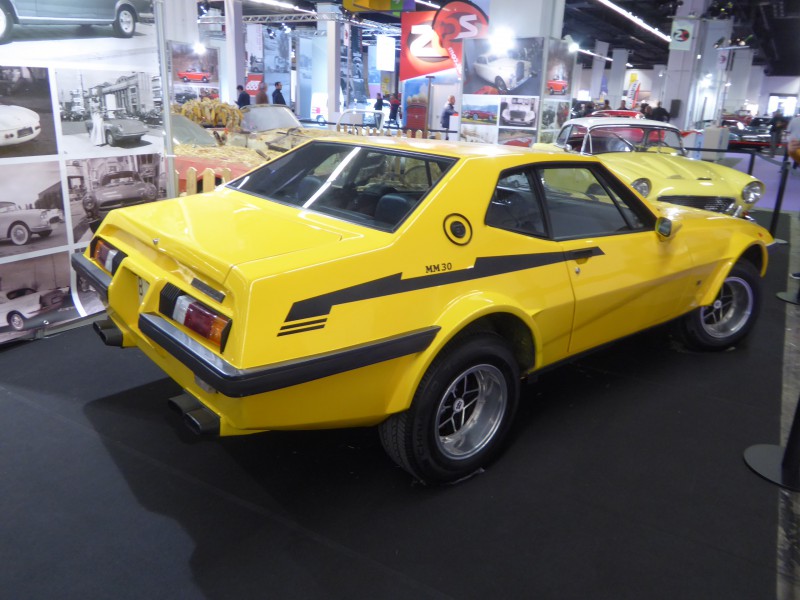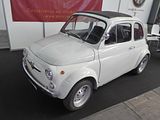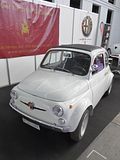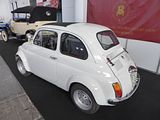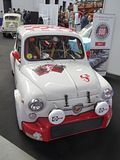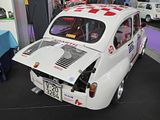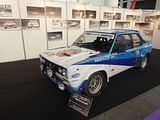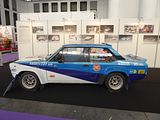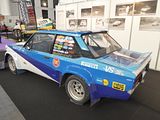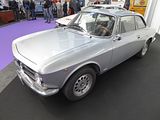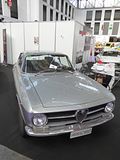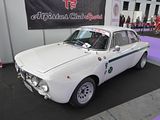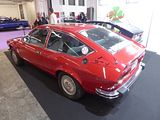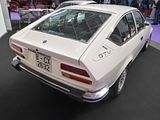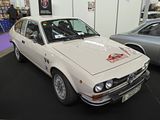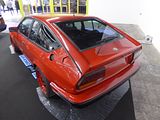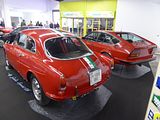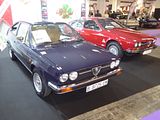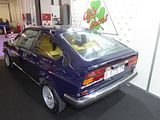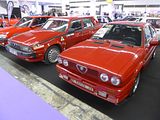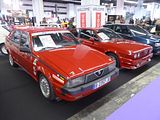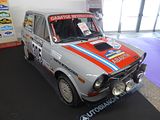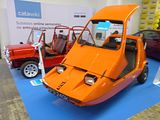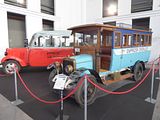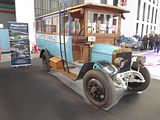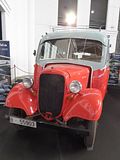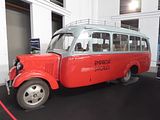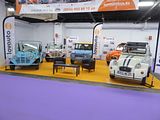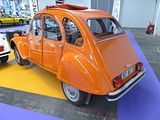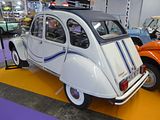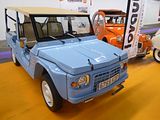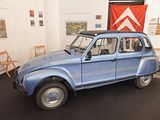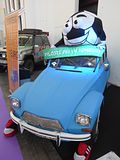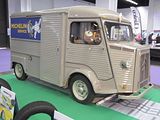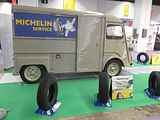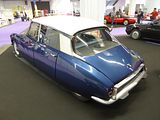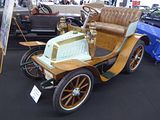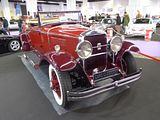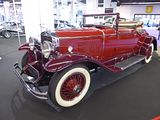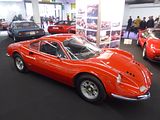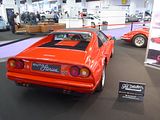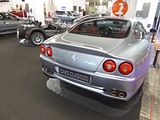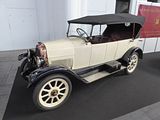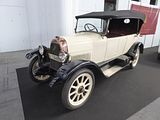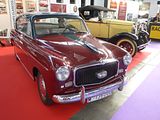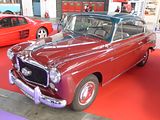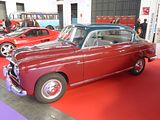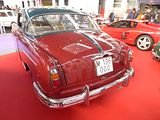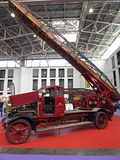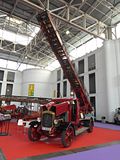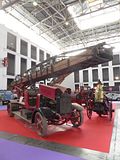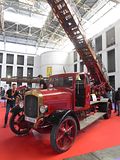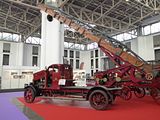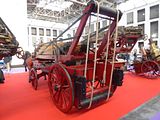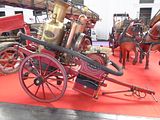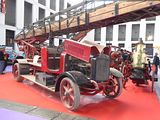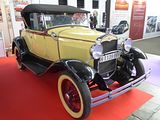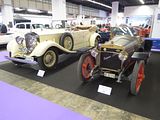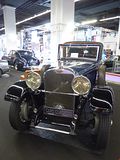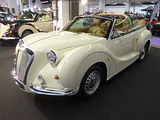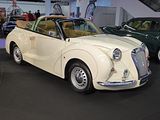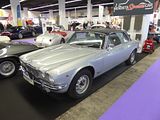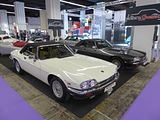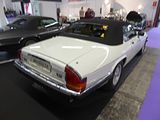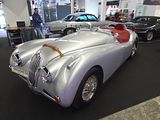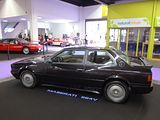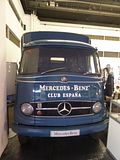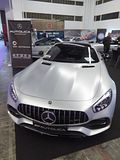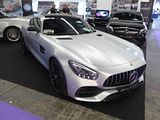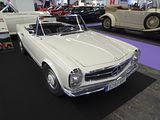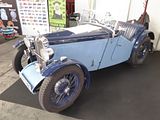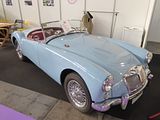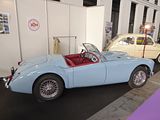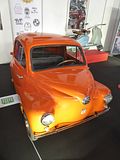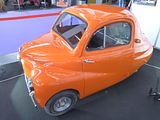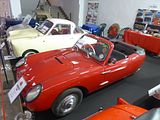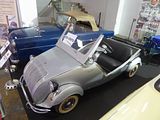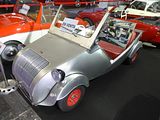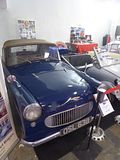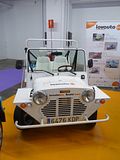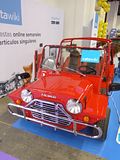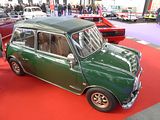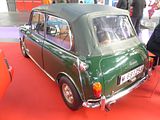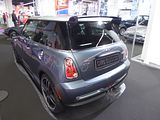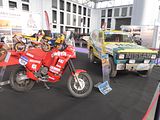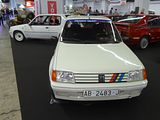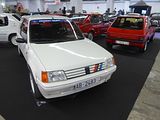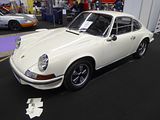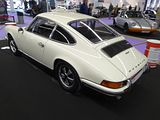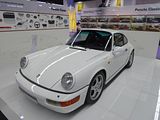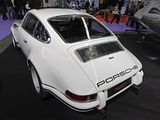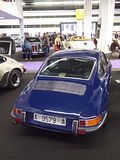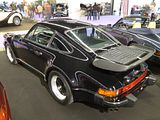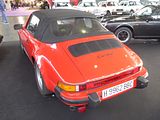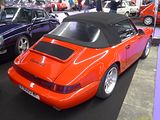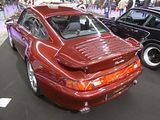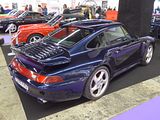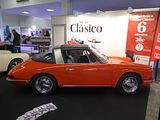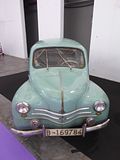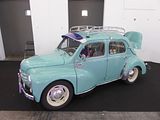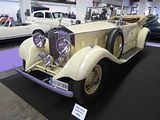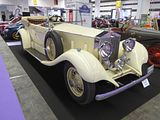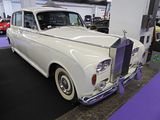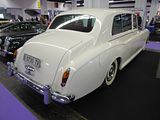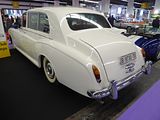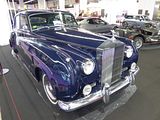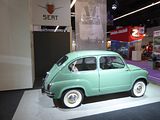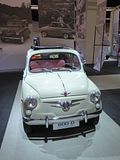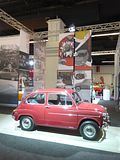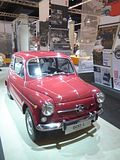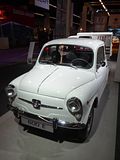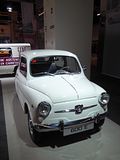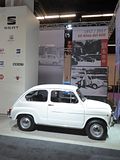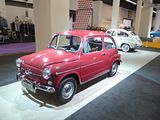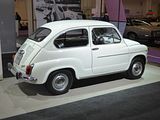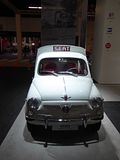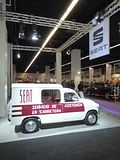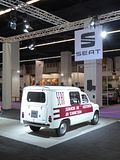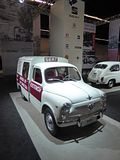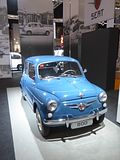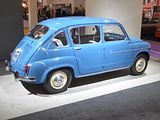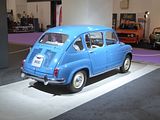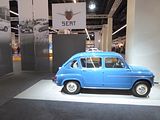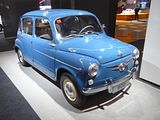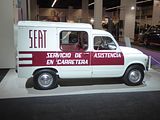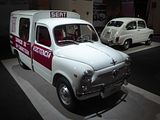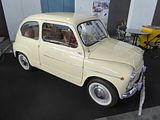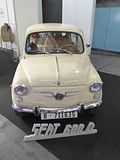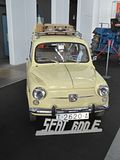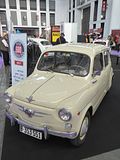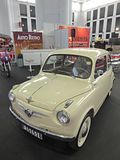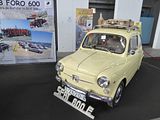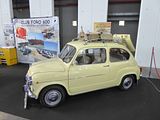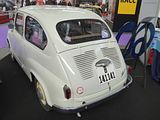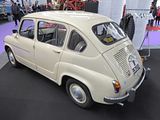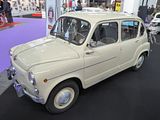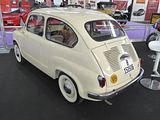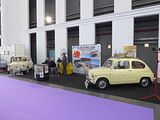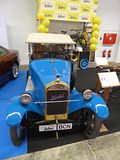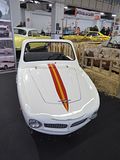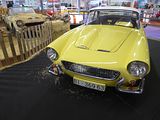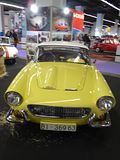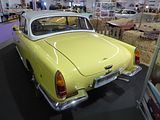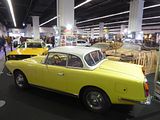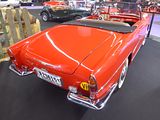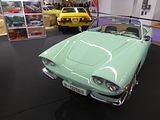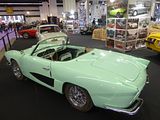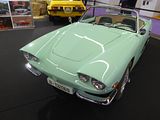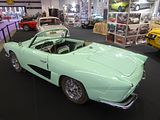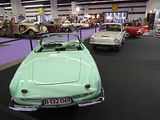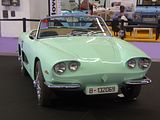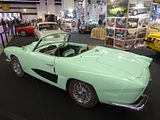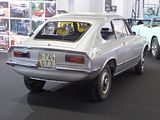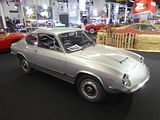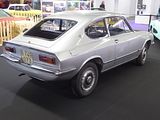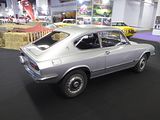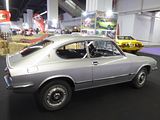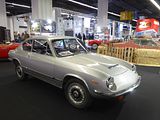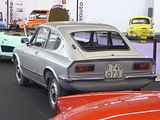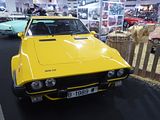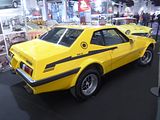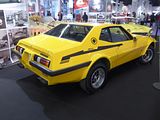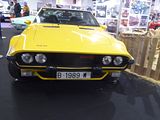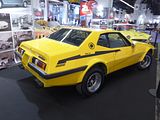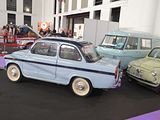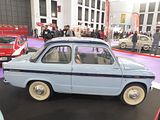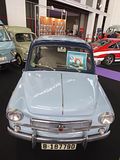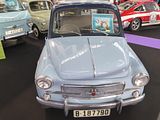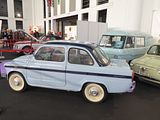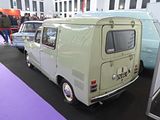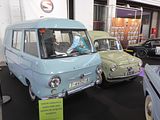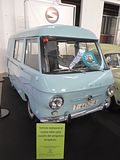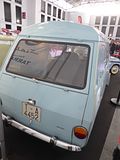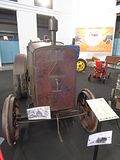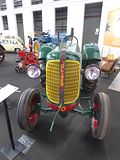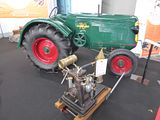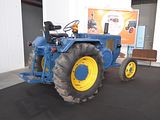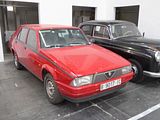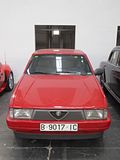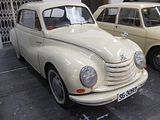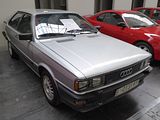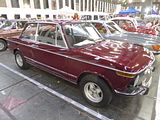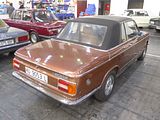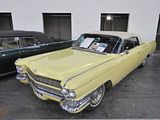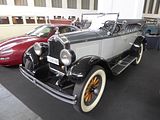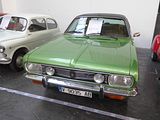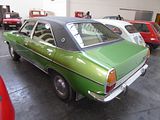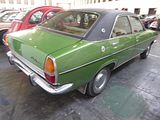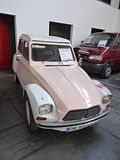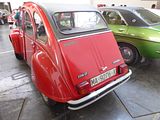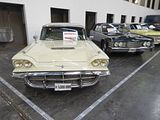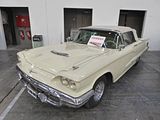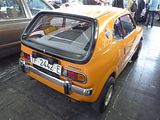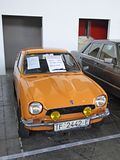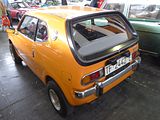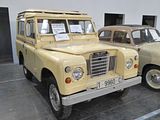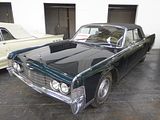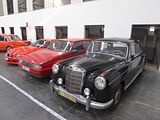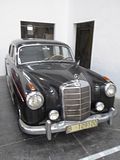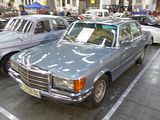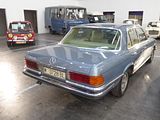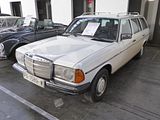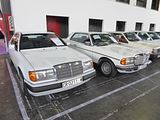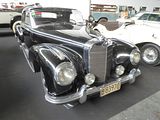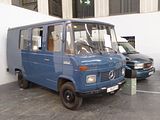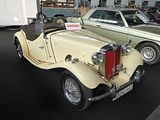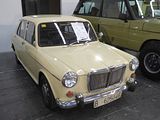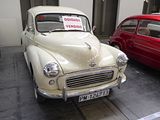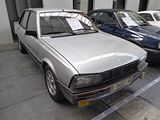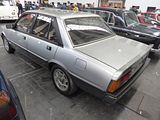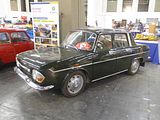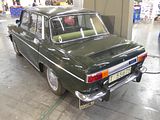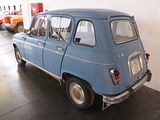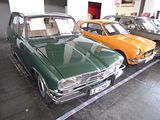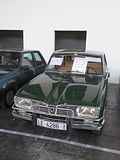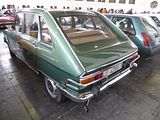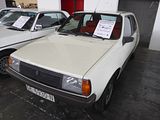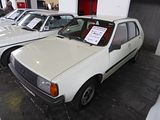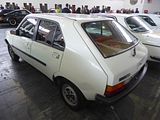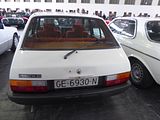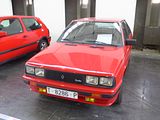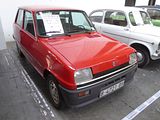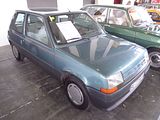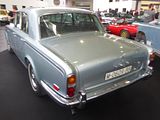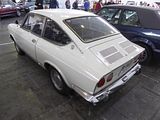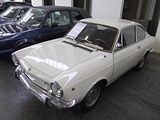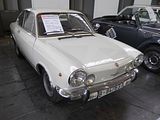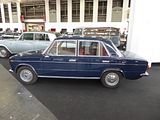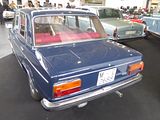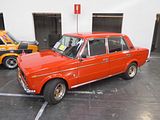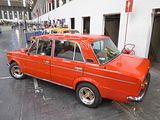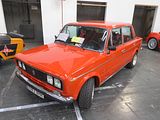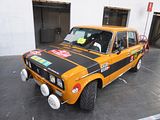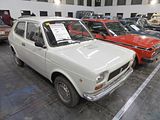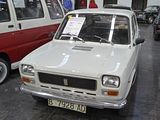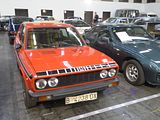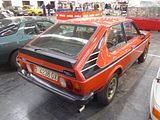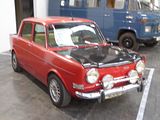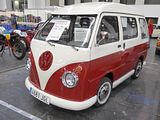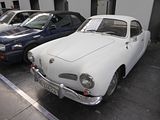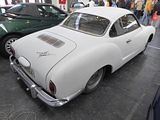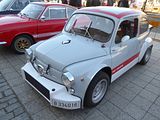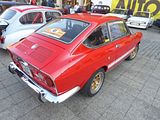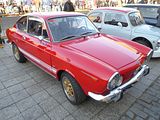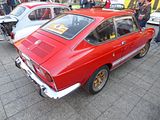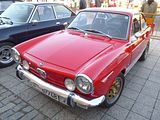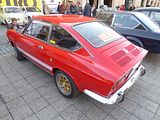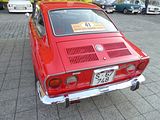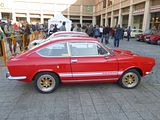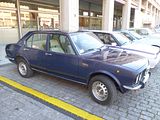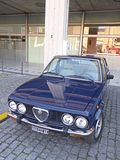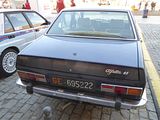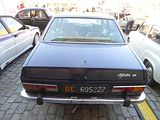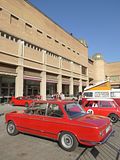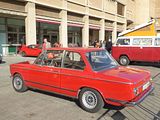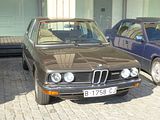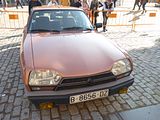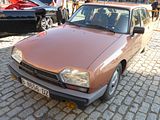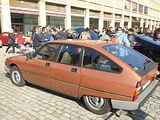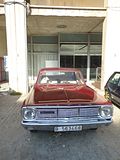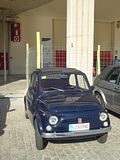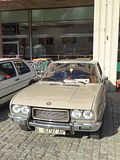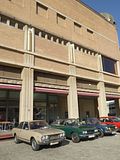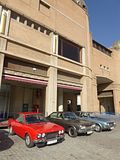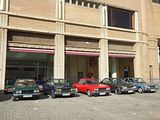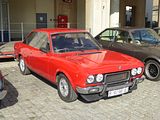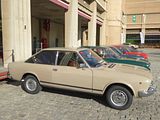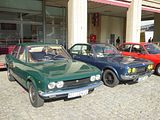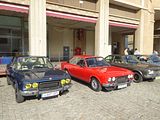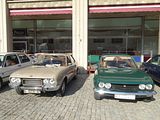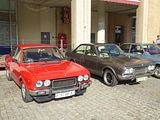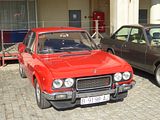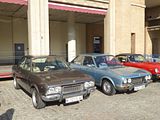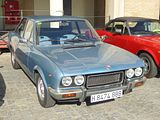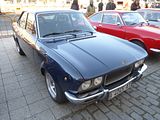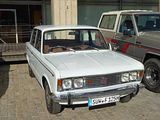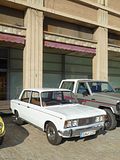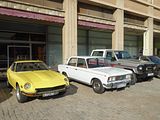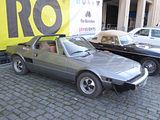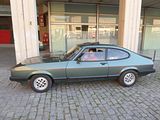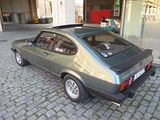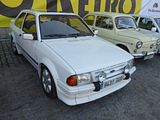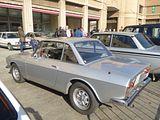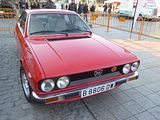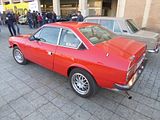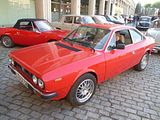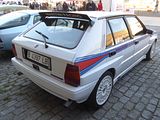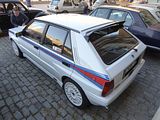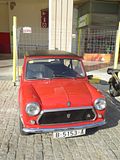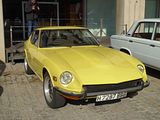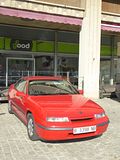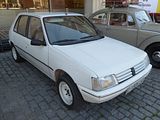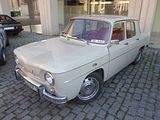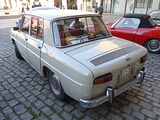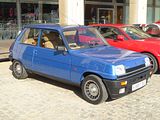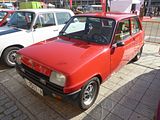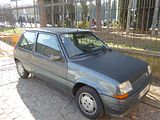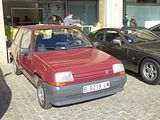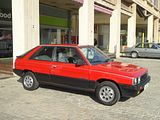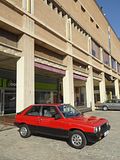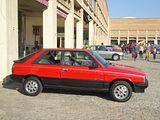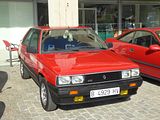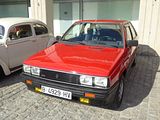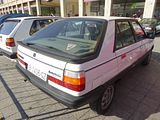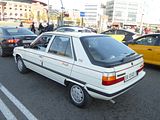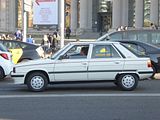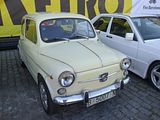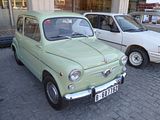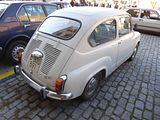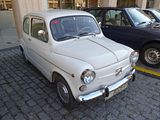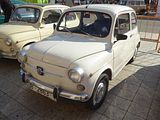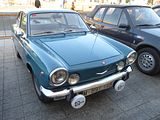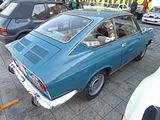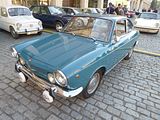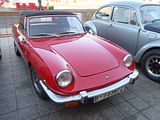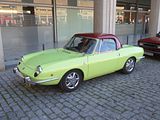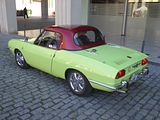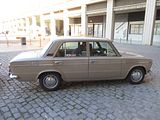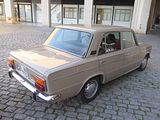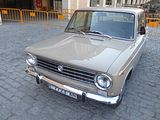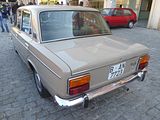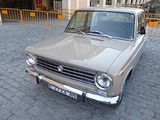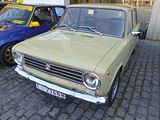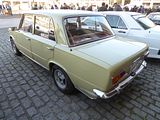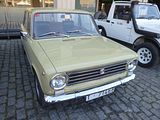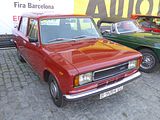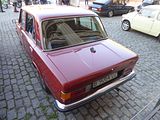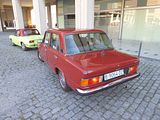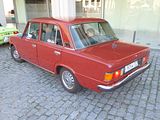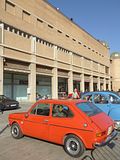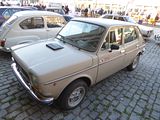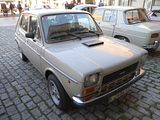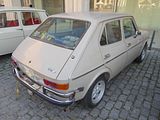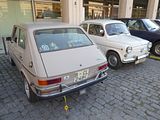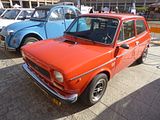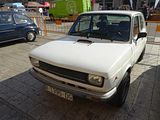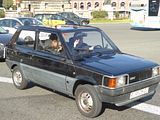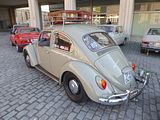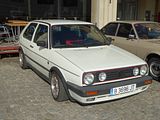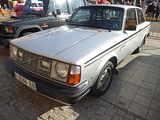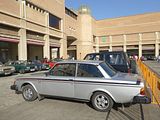The Auto Retro show, which is held at the Fira exhibition centre in Barcelona just by the old Bull Ring (now converted into a shopping centre!) off the Placa Espanya in the Montjuic district of the city, is the largest Classic Car event in Spain. It’s been going a long time, with the 2017 event marking the 34th occasion that it has been held. Whilst nothing like as big as the international shows held in the UK, France, Germany or Italy), it is large enough to hold plenty of interest for a visit, with the added benefit that the event manages to combine displays both of well known classics that you see at many an event with the far less familiar, many of them with a Spanish connection. I paid the event a first visit in 2010, and enjoyed it, and indeed the weekend in Barcelona that included the trip, so much that I returned the following year. Since then, I seem to have been able to include it in my schedule only in every odd-numbered year. That meant that I was due a 2017 visit, but when I saw that the Los Angeles Auto Show had been moved from a mid November timing to one in the first few days of December, it looked like there would be a clash that would make this difficult, and then I spotted that the Barcelona event had been brought forward a couple of weeks, to the middle of November. Not only did that clear the Los Angeles dates, it also proved to be the weekend after the UK’s NEC Classic Show, so I was able to include all three of these events in my plans for the closing weeks of the year.
THE INDOOR DISPLAYS
The Fira has exhibition halls on both sides of the Avenida Reina Maria Cristina road, and the last time I attended, in 2015, the event was held in the large one, Hall 8, to the west of the site, but this time, it was back on the other side of the road. There’s a collection of interconnected halls here, arranged in a U shape, which means there is a large courtyard area in front of them, which was being put to good use, as will be evidenced later in this report. There is a good mix of stands ranging from manufacturer supported displays, to those from some of the larger Car Clubs in Spain, a number of dealers (all of them Spanish, as far as I could tell), some local Museums, a couple of Classic Car magazines, and then there is a large autojumble, so there is plenty of variety, and more than a few surprises.
ABARTH
There were no stands dedicated to the brand, but classic Abarths were to be found on a number of stands, as well as on show outside the event. The most popular and common of these are the cars based on the Fiat/SEAT 6000 and with a ready supply of the latter in the country, it is generally the case that most of the ones you see are recreations rather than the originals from the 1960s, but most have been meticulously created and so are still very nice indeed.
For the 595 SS, which was based on the smaller Fiat 500, Abarth increased the engine capacity to 594 cc, just under the limit for the European 600cc racing sedan class. High compression 10:1 pistons were used together with a special camshaft, a specific alloy sump, Abarth valve covers and air filter, propped up engine lid and wheels were fitted and of course the exhaust system was a special in house model. This package together with lowered suspension, flared arches and 10 inch rims amounted to what was known as the Assetto Corsa SS model. These cars have become very rare as many were crashed in competition or simply rotted away due to bad rust protection in the 70s A number of recreations have been built, and this is likely one such. So, not original, but still nice and still a lot of fun.
Seen on the SEAT 600 Owners Club stand was an example of the larger 850TC, a model which in its original guise actually predates the 595/695 cars. Officially known as the Fiat-Abarth 850TC Berlina (Turismo Competizione, or “touring competition”), it was introduced towards the end of 1960, using Fiat 600 bodywork with some modifications, most notably a boxlike structure ahead of the front bumper which held the engine’s oil cooler. The rear wings were usually blistered, to accommodate larger wheels. The engine is a four-cylinder model based on a Fiat unit, with 847 cc capacity and 51 hp. Overall length is 3,090 mm (122 in), overall width is 1,400 mm (55 in), height is 1,380 mm (54 in), wheelbase is 2,000 mm (80 in), and its front and rear track are 1,160 mm (46 in). The fuel tank holds 5.9 imperial gallons, and its empty weight was 793 kg (1,748 lb). The 850TC remained in the price lists until 1966. In 1962 the 850TC Nürburgring was introduced, with 55 PS at 6500 rpm. The name was intended to celebrate the class victory of an Abarth 850TC at the 1961 Nürburgring 500 km race. There followed the 850TC/SS with two more horsepower; this was renamed the 850TC Nürburgring Corsa towards the end of the year. Between 1962 and 1971 the 850cc and 1000cc class cars won hundreds of races all over the World and were commonly called “Giant Killers” due to their superior performance over much larger cars, culminating in a famous dispute with SCCA authorities in the USA when Alfred Cosentino (FAZA) was banned from running his 1970 Fiat Abarth Berlina Corsa 1000 TCR “Radiale” engine because his car was faster (mainly in wet conditions) to many V8 Mustangs, AMC AMX’s and Chev Camaro’s etc.The SCCA authorities dictated FAZA and Cosentino be forced to use an early design engine a non “Radiale” engine from 1962 model in his cars but still achieved 51 Victories from 53 races. The most victories in SCCA racing history, Thereby cementing the superiority of the Fiat Abarth Berlina Corsa over larger and more powerful cars.
This Abarth 131 Rally was on a stand with some fabulous photos of the history of the Rallye Costa Brava. In 1976, 400 examples of the Fiat Abarth 131 Rally were built for homologation purposes. These cars were built in a co-operation between Fiat, Bertone and Abarth. Bertone took part-completed two door standard bodyshells from the production line in Mirafiori, fitted plastic mudguards front and rear, a plastic bonnet and bootlid and modified the metal structure to accept the independent rear suspension. The cars were fully painted an trimmed and then delivered back to the Fiat special Rivalta plant where they received the Abarth mechanicals. The street version of the car used a 16-valve DOHC derivative of the standard DOHC engine, which equipped with a double Weber downdraught carburettor produced 140 PS. The street cars used the standard gearbox with no synchromesh (Rally type regulations required the use of the same type of synchromesh on the competition cars as on the street versions) and the hopelessly underdimensioned brake system of the small Fiat 127. Competition cars used dry sump lubrication and eventually Kugelfischer mechanical fuel injection. In race specifications, the engine produced up to 240 PS in 1980, being driven to World Championship status by Walter Röhrl. Original Rally cars are rare these days, and most of the ones you see are, like this one, in fact a recreation.
ALFA ROMEO
Although sales of new Alfa Romeo models in Spain are not that great, and never have been, the marque is held in high esteem and is very popular among enthusiasts. In previous years there has been a factory-supported presence here, but while that was not the case in 2017, there were several stands either dedicated to the marque or where at least some of the cars on show were Alfa models.
Oldest of the Alfas were a number of 105 Series Coupe models, with plenty of examples of this much loved, and now highly valued car on display. The first car was called the Alfa Romeo Giulia Sprint GT, and was revealed at a press event held at the then newly opened Arese plant on 9 September 1963, and displayed later the same month at the Frankfurt Motor Show. In its original form the Bertone body is known as scalino (step) or “step front”, because of the leading edge of the engine compartment lid which sat 1/4 an inch above the nose of the car. The Giulia Sprint GT can be distinguished from the later models by a number of features including: Exterior badging: Alfa Romeo logo on the front grille, a chrome script reading “Giulia Sprint GT” on the boot lid, and rectangular “Disegno di Bertone” badges aft of the front wheel arches; flat, chrome grille in plain, wide rectangular mesh without additional chrome bars; single-piece chrome bumpers; no overriders. Inside the cabin the padded vinyl dashboard was characterised by a concave horizontal fascia, finished in grey anti-glare crackle-effect paint. Four round instruments were inset in the fascia in front of the driver. The steering wheel was non-dished, with three aluminium spokes, a thin bakelite rim and a centre horn button. Vinyl-covered seats with cloth centres and a fully carpeted floor were standard, while leather upholstery was an extra-cost option. After initially marketing it as a four-seater, Alfa Romeo soon changed its definition of the car to a more realistic 2+2. The Giulia Sprint GT was fitted with the 1,570 cc version of Alfa Romeo’s all-aluminium twin cam inline four (78 mm bore × 82 mm stroke), which had first debuted on the 1962 Giulia Berlina. Breathing through two twin-choke Weber 40 DCOE 4 carburettors, on the Sprint GT this engine produced 105 hp at 6,000 rpm. Like all subsequent models, the Sprint GT was equipped with an all-synchromesh 5-speed manual transmission. The braking system comprised four Dunlop disc brakes and a vacuum servo. The rear brakes featured an unusual arrangement with the slave cylinders mounted on the axle tubes, operating the calipers by a system of levers and cranks. According to Alfa Romeo the car could reach a top speed of “over 180 km/h (112 mph)”. In total 21,902 Giulia Sprint GT were produced from 1963 to 1965, when the model was superseded by the Giulia Sprint GT Veloce. Of these 2,274 were right hand drive: 1,354 cars fully finished in Arese, and 920 shipped in complete knock-down kit form for foreign assembly. For 1966, the Giulia Sprint GT was replaced by the Alfa Romeo Giulia Sprint GT Veloce, which was very similar but featuring a number of improvements: a revised engine—slightly more powerful and with more torque—better interior fittings and changes to the exterior trim. Alongside the brand new 1750 Spider Veloce which shared its updated engine the Sprint GT Veloce was introduced at the 36th Geneva Motor Show in March 1966, and then tested by the international specialist press in Gardone on the Garda Lake. Production had began in 1965 and ended in 1968. The Giulia Sprint GT Veloce can be most easily distinguished from other models by the following features: badging as per Giulia Sprint GT, with the addition of round enamel badges on the C-pillar—a green Quadrifoglio (four-leaf clover) on an ivory background—and a chrome “Veloce” script on the tail panel; black mesh grille with three horizontal chrome bars; the grille heart has 7 bars instead of 6; stainless steel bumpers, as opposed to the chromed mild steel bumpers on the Giulia Sprint GT. The bumpers are the same shape, but are made in two pieces (front) and three pieces (rear) with small covers hiding the joining rivets. Inside the main changes from the Giulia Sprint GT were imitation wood dashboard fascia instead of the previous anti-glare grey finish, front seats revised to a mild “bucket” design, and a dished three aluminium spoke steering wheel, with a black rim and horn buttons through the spokes. The Veloce’s type 00536 engine, identical to the Spider 1600 Duetto’s, featured modifications compared to the Giulia Sprint GT’s type 00502—such as larger diameter exhaust valves. As a result it produced 108 hp at 6,000 rpm, an increase of 3 hp over the previous model, and significantly more torque. The top speed now exceeded 185 km/h (115 mph). Early Giulia Sprint GT Veloces featured the same Dunlop disc brake system as the Giulia Sprint GT, while later cars substituted ATE disc brakes as pioneered on the GT 1300 Junior in 1966. The ATE brakes featured an handbrake system entirely separate from the pedal brakes, using drum brakes incorporated in the rear disc castings. Though the Sprint GT Veloce’s replacement—the 1750 GT Veloce—was introduced in 1967, production continued throughout the year and thirty final cars were completed in 1968. By then total Giulia Sprint GT Veloce production amounted to 14,240 examples. 1,407 of these were right hand drive cars, and 332 right hand drive complete knock-down kits. The Alfa Romeo 1750 GT Veloce (also known as 1750 GTV) appeared in 1967 along with the 1750 Berlina sedan and 1750 Spider. The same type of engine was used to power all three versions; this rationalisation was a first for Alfa Romeo. The 1750 GTV replaced the Giulia Sprint GT Veloce and introduced many updates and modifications. Most significantly, the engine capacity was increased to 1779 cc displacement. Peak power from the engine was increased to 120 hp at 5500 rpm. The stroke was lengthened from 82 to 88.5 mm over the 1600 engine, and a reduced rev limit from 7000 rpm to 6000 rpm. Maximum torque was increased to 137 lb·ft at 3000 rpm. A higher ratio final drive was fitted (10/41 instead of 9/41) but the same gearbox ratios were retained. The result was that, on paper, the car had only slightly improved performance compared to the Giulia Sprint GT Veloce, but on the road it was much more flexible to drive and it was easier to maintain higher average speeds for fast touring. For the United States market, the 1779 cc engine was fitted with a fuel injection system made by Alfa Romeo subsidiary SPICA, to meet emission control laws that were coming into effect at the time. Fuel injection was also featured on Canadian market cars after 1971. Carburettors were retained for other markets. The chassis was also significantly modified. Tyre size went to 165/14 from 155/15 and wheel size to 5 1/2J x 14 instead of 5J x 15, giving a wider section and slightly smaller rolling diameter. The suspension geometry was also revised, and an anti-roll bar was fitted to the rear suspension. ATE disc brakes were fitted from the outset, but with bigger front discs and calipers than the ones fitted to GT 1300 Juniors and late Giulia Sprint GT Veloces. The changes resulted in significant improvements to the handling and braking, which once again made it easier for the driver to maintain high average speeds for fast touring. The 1750 GTV also departed significantly from the earlier cars externally. New nose styling eliminated the “stepped” bonnet of the Giulia Sprint GT, GTC, GTA and early GT 1300 Juniors and incorporated four headlamps. For the 1971 model year, United States market 1750 GTV’s also featured larger rear light clusters (there were no 1970 model year Alfas on the US market). Besides the chrome “1750” badge on the bootlid, there was also a round Alfa Romeo badge. Similar Quadrofoglio badges to those on the Giulia Sprint GT Veloce were fitted on C pillars, but the Quadrofoglio was coloured gold instead of green. The car also adopted the higher rear wheelarches first seen on the GT 1300 Junior. The interior was also much modified over that of earlier cars. There was a new dashboard with large speedometer and tachometer instruments in twin binnacles closer to the driver’s line of sight. The instruments were mounted at a more conventional angle, avoiding the reflections caused by the upward angled flat dash of earlier cars. Conversely, auxiliary instruments were moved to angled bezels in the centre console, further from the driver’s line of sight than before. The new seats introduced adjustable headrests which merged with the top of the seat when fully down. The window winder levers, the door release levers and the quarterlight vent knobs were also restyled. The remote release for the boot lid, located on the inside of the door opening on the B-post just under the door lock striker, was moved from the right hand side of the car to the left hand side. The location of this item was always independent of whether the car was left hand drive or right hand drive. Early (Series 1) 1750 GTV’s featured the same bumpers as the Giulia Sprint GT Veloce, with the front bumper modified to mount the indicator / sidelight units on the top of its corners, or under the bumper on US market cars. The Series 2 1750 GTV of 1970 introduced other mechanical changes, including a dual circuit braking system (split front and rear, with separate servos). The brake and clutch pedals on left hand drive cars were also of an improved pendant design, instead of the earlier floor-hinged type. On right hand drive cars the floor-hinged pedals were retained, as there was no space for the pedal box behind the carburettors. Externally, the series 2 1750 GTV is identified by new, slimmer bumpers with front and rear overriders. The combined front indicator and sidelight units were now mounted to the front panel instead of the front bumper, except again on the 1971-72 US/Canadian market cars. The interior was slightly modified, with the seats retaining the same basic outline but following a simpler design. 44,269 1750 GTVs were made before their replacement came along. That car was the 2000GTV. Introduced in 1971, together with the 2000 Berlina sedan and 2000 Spider, the 2 litre cars were replacements for the 1750 range. The engine displacement was increased to 1962 cc. Oil and radiator capacities remained unchanged. The North American market cars had fuel injection, but everyone else retained carburettors. Officially, both versions generated the same power, 130 hp at 5500 rpm. The interior trim was changed, with the most notable differences being the introduction of a separate instrument cluster, instead of the gauges installed in the dash panel in earlier cars. Externally the 2000 GTV is most easily distinguished by its grille with horizontal chrome bars, featuring protruding blocks forming the familiar Alfa heart in outline, smaller hubcaps with exposed wheel nuts, optional aluminium alloy wheels of the same size as the standard 5. 1/2J × 14 steel items, styled to the “turbina” design first seen on the alloy wheels of the Alfa Romeo Montreal, and the larger rear light clusters first fitted to United States market 1750 GTV’s were standard for all markets. From 1974 on, the 105 Series coupé models were rationalised and these external features became common to post-1974 GT 1300 Junior and GT 1600 Junior models, with only few distinguishing features marking the difference between models. 37,459 2000 GTVs were made before production ended and these days they are very sought after with prices having sky-rocketed in recent years. Among the cars to be seen here were an early Giulia Sprint, as well as later 1750 GTV and GT Junior 1.6.
As was still the practice in the 1970s, Alfa followed up the 1972 launch of the Alfetta Berlina with a very pretty coupe. Styled by Giugiaro, this car, initially called the GT, and premiered in the autumn of 1974, looked completely unlike the saloon on which it was based. The first cars had 1.8 litre four cylinder engines and there was one of those on show. In 1976 the range was expanded both up and down with a 1.6 and a 2.0 model, the latter adopting the legendary GTV name. A rare SE model from this period was part of the display, complete with period vinyl roof (look closely), and although the pain does appear a bit like a lot of older Alfa reds, having gone rather pink, this was the actual shade when the car was new. In 1981, with the 2.5 litre V6 engine that had been developed for the ill-fated Alfa 6 luxury saloon available, Alfa was able to create a true rival for the 2.8 litre Capri with the GTV6. A facelift modernised the look of the car with plastic bumpers front and rear and a new interior looked rather better as well as being more ergonomically logical. There was a good mix of the earlier chrome bumpered and later plastic bumpered models, the last with 2.0 and 2.5 GTV6 versions both represented. There was also a car sporting 3.0 badging and right hand drive. This is a South African car. From 1974 South African Alfetta’s were manufactured at Alfa Romeo’s own Brits plant. South Africa was one of two markets to have a turbocharged GTV6, with a Garrett turbocharger and a NACA intake. An estimated 750 were assembled before all production ceased in 1986. The South African range included a 3.0 litre GTV-6, predating the international debut of the factory’s 3.0 litre engine in 1987 (for the Alfa 75). and 212 of these were built in South Africa for racing homologation. The last 6 GTV-6 3.0’s were fuel injected. To this day, the GTV-6 remains the quintessential Alfa Romeo for South Africans. That model was represented here as well some of the smaller-engined versions, with a pre-facelift GTV being a nice complement to the plastic-bumpered models.
There were a couple of nice examples of the AlfaSud Sprint here.There was a much longer wait for a Coupe version of the AlfaSud than there had been for the larger Alfetta, the Alfasud Sprint being presented to the press in September 1976 in Baia Domizia and shown at the Turin Motor Show in November some five years after the launch of the saloon. Designed by Giorgetto Giugiaro like the AlfaSud, whose mechanicals it was based on, it had a lower, more angular design, featuring a hatchback, although there were no folding rear seats. The AlfaSud Sprint was assembled together with the AlfaSud in the Pomigliano d’Arco plant, located in southern Italy—hence the original “Sud” moniker. Under the Alfasud Sprint’s bonnet there was a new version of the AlfaSud’s 1186 cc four-cylinder boxer engine, stroked to displace 1,286 cc, fed by a twin-choke carburettor and developing 75 hp at 6,000 rpm. Mated to the flat-four was a five-speed, all-synchromesh gearbox. The interior was upholstered in dark brown Texalfa leatherette and tartan cloth. Options were limited to alloy wheels, a quartz clock and metallic paint. In May 1978 the AlfaSud Sprint underwent its first updates, both cosmetic and technical. Engine choice was enlarged to two boxers, shared with the renewed AlfaSud ti, a 78 hp 1.3 (1,350 cc) and a 84 hp 1.5 (1,490 cc); the earlier 1286 cc unit was not offered anymore, remaining exclusive to the AlfaSud. Outside many exterior details were changed from chrome to matte black stainless steel or plastic, such as the wing mirrors, window surrounds and C-pillar ornaments; the B-pillar also received a black finish, the side repeaters changed position and became square, and the front turn signals switched from white to amber lenses. In the cabin the seats had more pronounced bolsters and were upholstered in a new camel-coloured fabric. Just one year later, in June 1979, another engine update arrived and the AlfaSud Sprint became the AlfaSud Sprint Veloce. Thanks to double twin-choke carburettors (each choke feeding a single cylinder) and a higher compression ratio engine output increased to 85 hp and 94 hp, respectively for the 1.3 and 1.5. In February 1983 Alfa Romeo updated all of its sports cars; the Sprint received a major facelift. Thereafter the AlfaSud prefix and Veloce suffix were abandoned, and the car was known as Alfa Romeo Sprint; this also in view of the release of the Alfa Romeo 33, which a few months later replaced the AlfaSud family hatchback. The Sprint also received a platform upgrade, which was now the same as that of the Alfa Romeo 33; this entailed modified front suspension, brakes mounted in the wheels instead of inboard like on the AlfaSud, and drum brakes at the rear end. Three models made up the Sprint range: 1.3 and 1.5, with engines and performance unchanged from the AlfaSud Sprint Veloce, and the new 1.5 Quadrifoglio Verde—1.5 Cloverleaf in the UK. A multitude of changes were involved in the stylistic refresh; there were a new grille, headlamps, wing mirrors, window surrounds and C-pillar ornaments. Bumpers went from chrome to plastic, and large plastic protective strips were added to the body sides; both sported coloured piping, which was grey for 1.3 cars, red for the 1.5 and green for the 1.5 Quadrifoglio. At the rear new trapezoidal tail light assemblies were pieced together with the license plate holder by a black plastic fascia, topped by an Alfa Romeo badge—never present on the AlfaSud Sprint. In the cabin there were new seats with cloth seating surfaces and Texalfa backs, a new steering wheel and changes to elements of the dashboard and door panels. Sprint 1.3 and 1.5 came with steel wheels with black hubcaps from the AlfaSud ti. The newly introduced 1.5 Quadrifoglio Verde sport variant was shown at the March 1983 Geneva Motor Show. Its engine was the 1,490 cc boxer, revised to put out 104 hp at 6,000 rpm; front brake discs were vented and the gearing shorter. In addition to the green bumper piping, also specific to the Quadrifoglio were a green instead of chrome scudetto in the front grille, a rear spoiler and 8-hole grey painted alloy wheels with metric Michelin TRX 190/55 tyres. Inside a three-spoke leather-covered steering wheel, green carpets and sport seats in black cloth with green embroidery. In November 1987 the Sprint was updated for the last time; the 1.3 variant was carried over, while the 1.5 engine was phased out and the 1.5 QV was superseded by the 116 hp Sprint 1.7 Quadrifoglio Verde. The 1,286 cc engine was directly derived from the 33 1.7 Quadrifoglio Verde, and could propel the Sprint from 0 to 100 km/h in 9.3 seconds; to cope with the increased engine power, the 1.7 QV adopted vented brake discs upfront. the coloured piping and side plastic strips were deleted, and the Quadrifoglio had alloy wheels of a new design. A fuel injected and 3-way Catalytic converter-equipped 1.7 variant, with an engine again derived from a 33, was added later for sale in specific markets. There were a total of 116,552 Sprints produced during its lifespan, which lasted from 1976 to 1989. 15 of these formed the basis of the Australian-built Giocattolo sports car, which used a mid-mounted Holden 5.0 group A V8 engine. The Sprint had no direct predecessor or successor.
There was a rather nice Alfa 75 here, too, the last Alfa model to be developed before the company was bought by Fiat. It was introduced in May 1985, to replace the 116 Series Giulietta with which it shared many components. It was named to celebrate Alfa’s 75th year of production. The body, designed by head of Alfa Romeo Centro Stile Ermanno Cressoni, was styled in a striking wedge shape, tapering at the front with square headlights and a matching grille. The 75 was only ever sold as a four door saloon, though at the 1986 Turin Auto Salon, a prototype 75 estate was to be seen, an attractive forerunner of the later 156 Sportwagon. This version was, however, never listed for sale, being cancelled after Fiat took control of Alfa Romeo. The car, dubbed the 75 Turbo Wagon, was made by Italian coachbuilder Rayton Fissore using a 75 Turbo as the basis. Two estate versions were to be found at the later 1987 Geneva Motor Show; one was this Turbo Wagon and the other was a 2.0 litre version named the Sportwagon. The 75 featured some unusual technical features, most notably the fact that it was almost perfectly balanced from front to rear. This was achieved by using transaxle schema — mounting the standard five-speed gearbox in the rear connected to the rear differential (rear-wheel drive). The front suspension was a torsion bar and shock absorber combination and the rear an expensive de Dion tube assembled with shock absorbers; these designs were intended to optimise the car’s handling; moreover the rear brake discs were fitted at the centre of the rear axle, near the gearbox-differential group. The engine crankshaft was bolted directly to the two-segment driveshaft which ran the length of the underside from the engine block to the gearbox, and rotated at the speed of the engine. The shaft segments were joined with elastomeric ‘doughnuts’ to prevent vibration and engine/gearbox damage. The 2.0 litre Twin Spark and the 3.0 litre V6 were equipped with a limited slip differential. The 75 featured a then-advanced dashboard-mounted diagnostic computer, called Alfa Romeo Control, capable of monitoring the engine systems and alerting the drivers of potential faults. The 75 engine range at launch featured four-cylinder 1.6, 1.8 and 2.0 litre petrol carburettor engines, a 2.0 litre intercooled turbodiesel made by VM Motori, and a 2.5 litre fuel injected V6. In 1986, the 75 Turbo was introduced, which featured a fuel-injected 1779 cc twin-cam engine using Garrett T3 turbocharger, intercooler and oil cooler. In 1987, a 3.0 litre V6 was added to the range and the 2.0 litre Alfa Romeo Twin Cam engine was redesigned to have now two spark plugs per cylinder, the engine was named as Twin Spark. With fuel injection and variable valve timing this engine produced 146 hp. This was the first production engine to use variable valve timing. In North America, where the car was known as the Milano, only the 2.5 and 3.0 V6s were available, from 1987 to 1989. The North American 2.5-litres were fundamentally different from their European counterparts. Due to federal regulations, some modifications were required. Most noticeable from the outside were the ‘America’ bumpers, with the typical rubber accordions in them. Furthermore, these bumpers had thick (and heavy) shock-absorbing material inside them and in addition, they were mounted to the vehicle on shock absorbers. To accommodate these shock absorbers, the ‘America’-bodies were slightly different from the European ones. The North American cars also had different equipment levels (depending on the version: Milano Silver, Milano Gold or Milano Platinum). electrically adjustable outside mirrors, electrically reclining seats and cruise control were usually optional in Europe. The car was also available with a 3-speed ZF automatic gearbox option for the 2.5 V6. Other, more common options such as electrically operated rear windows and an A/C system were standard in the USA. The USA-cars also had different upholstery styles and of course different dashboard panels also indicating speed in mph, oil pressure in psi and coolant temperature in degrees F, and as a final touch the AR control was different, including a seat belt warning light. The European-spec 2.5 V6 (2.5 6V Iniezione or 2.5QV) was officially sold only between 1985 and 1987, although some of them were not registered until 1989. Relatively few of them were sold (about 2800 units), especially when the 155 PS 1.8 Turbo was launched, which in some countries was cheaper in taxes because of its lower displacement. To create a bigger space between the V6 and the inline fours, the 2.5 was bored out to 2959 cc’s to deliver 188 PS and this new engine was introduced as the 3.0 America in 1987. As its type designation suggests, the 3.0 only came in the US-specification, with the impact-bumpers and in-boot fuel tank. However, the European ‘America’s’ were not equipped with side-markers or the door, bonnet and boot lid fortifications. Depending on the country of delivery, the 3.0 America could be equipped with a catalytic converter. In 1988 engines were updated again, the 1.8 litre carburettor version was replaced with fuel injected 1.8 i.e. and new bigger diesel engine was added to the range. In the end of 1989 the 1.6 litre carburettor version was updated to have fuel injection and 1990 the 1.8 Turbo and 3.0i V6 got some more power and updated suspension. The 3.0 V6 was now equipped with a Motronic system instead of an L-Jetronic. The 1.8 Turbo was now also available in ‘America’-spec, but strangely enough not available for the USA market. The 3.0 V6 did make it to the United States, and was sold as Milano Verde. The UK never particularly warmed to the 75 when it was new, but its reputation has got ever stronger as the car ages. Many UK cars were snapped up by the owners of driving schools at racing circuits, thanks to its handling characteristics, but there are also some nice road cars left and there were a number here.
Bringing things up to date was a 4C Competizione. First seen as a concept at the 2011 Geneva Show, the production model did not debut for a further 2 years. Production got underway later that year at the Maserati plant in Modena, and the first deliveries were late in 2013. Production was originally pegged at 1000 cars a year and a total of just 3500, which encouraged many speculators to put their name down in the hope of making a sizeable profit on selling their cars on. That plan backfired, and in the early months, there were lots of cars for sale for greater than list price. Press reaction to the car has been mixed, with everyone loving the looks, but most of them feeling that the driving experience is not as they would want. Owners generally disagree – as is so often the case! For sure, it has no radio, and no carpets and no luggage space to speak of, but you know that when you buy it. It won’t be the car everyone, but if you can live with these limitations, you are sure to enjoy it. Indeed, all owners I have ever spoke to do love their car. I know I would if I could find space (and funds!) for one in my garage!
AUTOBIANCHI
There was a nice example of the Autbianchi A112 here. This was a supermini, developed using a shrunken version of the contemporary Fiat 128’s platform. The mechanicals of the A112 subsequently underpinned the Fiat 127. It was introduced in November 1969, as a replacement for the Bianchina and Primula, and was built until 1986, when it made way for the more modern Autobianchi Y10 (branded in most export markets as the Lancia Y10). Over 1.2 million A112s were produced in Autobianchi’s Milan factory. The A112 was available only with a 3-door body. It was offered with the OHV engine of 903 cc from the Fiat 850 capable of attaining 42 PS. The Autobianchi represented the first appearance of this engine in a front-engine, front-wheel drive configuration which would later become familiar to a wider range of drivers in the top selling Fiat 127 and its derivatives. Claimed power increased to 47 PS in 1971, but without any mechanical changes having taken place. The A112 reached a very particular market; by 1984 female buyers represented 35% of A112 owners and about a third were in the 18-24 age range. In September 1971 the A112 E (“E” for Elegant, which also became its name after the 1973 facelift) was introduced. This featured improved seats, higher grade trimming and equipment, as well as a five-speed gearbox later in life. The mechanics were originally identical to the regular version, now referred to as the Normale, but from 1975 until 1977 the Normale’ received a less powerful engine. A performance edition “Abarth” was introduced too. In March 1973 the A112 received a makeover. The grille was new, with a larger mesh, and the bumpers were now of rubber with chrome insert (although the Normale retained the old metal bumpers with rubber strips). A new style of alloys were also available, and the seats and dashboard underwent some changes. The Abarth received a new chess pattern upholstery. In 1975 the third series arrived. The insides in the rear were recontoured, so that the car now became a five-seater (instead of four). The easiest way to spot a third series is that it received new, much larger vents on the C-pillars, as well as redesigned taillights – with integrated reversing lights on the Elegant and Abarth. The Abarth also received a new larger 1050 cc engine (“70HP”), while the Normale’s output dropped to 42 PS in July 1975. All engines were still pushrod units, derived from the old tipo 100 engine first introduced in the Fiat 600. In 1976, due to new emissions standards, the Elegant lost two horsepower, now down to 45 PS. Third series Normales still received metal bumpers, but from now on they were painted black (instead of being chromed) and no longer had a rubber strip. This was the last model to have the diamond shaped turn signals on the front fenders, with later models receiving more orthodox rectangular ones. In November 1977 the “Nuova A112” (new A112) was introduced: The most obvious difference is a slightly taller roof, with a marked edge around the sides. This improved interior habitability considerably. Autobianchi also at this time modified the upmarket version branded as the “A112 Elegant” with an engine enlarged to 965 cc, now promising 48 PS and improved torque. Later, there were also “A112 Elite” and “A112 LX” versions which received even more comfortable equipment. The 903 cc engine of the lesser A112 Normale remained unchanged. In July 1979 the car underwent another styling modification, receiving large black plastic cladding on the rear, surrounding new taillights, and new side trim and bumpers. The grille was also new, and there was black plastic wheelarches to link all of the plastic parts together. The extractor vents behind the rear side windows were also larger, of black plastic, and wrapped around the pillar. In terms of transmissions, a five-speed transmission now became available on certain models. The fifth gear was an overgear, while the ratios of the four lower speeds and the final gearing remained unchanged. The front turn signals were moved from the front of the fenders to a spot just in front of the leading edge of the doors, while a small badge denoting the trim level appeared in the turn signal’s old place. The Normale now became the Junior, and the Elite version was added, a notch above the Elegant in the lineup. There were some very light modifications to the interior. A large, rollback canvas sunroof became available on the Junior, and a rear window wiper became optional across the range. Aside from the new transmission there were no notable mechanical changes. Power outputs remained at 42, 48, and 70 PS. The Abarth also received the new five-speed gearbox, as well as new alloy wheels and foglights as standard. A lot of the plastic excesses of the fifth series were reversed for the sixth series, which was introduced in the autumn of 1982. New smoother bumpers, removal of the wheelarch trim, and a less heavy grille treatment brought back some of the original elegance of the A112, while the interior was also completely renovated. Another new version arrived, the top-of-the-line LX, which featured tinted windows, velvet seat trimming, power windows, metallic paintwork, and a digital clock amongst other creature comforts. Mechanically, the LX was identical to the Elite, with the five-speed transmission and 965 cc engine. The Elegant version was discontinued, with the Elite taking its position in the lineup. The sixth series also received new body-coloured vents on the C-pillar, and the front corner lights were incorporated into the top of the bumper. The seventh series, presented in 1984, only saw minor changes, largely remaining the same as the sixth. The taillights were again redesigned and were now joined by a reflective strip. The rear license plate was relocated to the bumper and the dashboard received modifications, more noticeable in the better equipped Elite and LX versions. The Abarth received standard front foglights, which were optional on the other versions. The Abarth also has red seatbelts. While the Junior retained small hubcaps, and the Abarth received alloys, the rest of the range now received full-face hubcaps. The front corner lights were now white, instead of orange as before. The engines remained as before, all models except the lowest-priced Junior now used five-speed transmissions. By this time, only France, Italy and Israel still used the “Autobianchi” badge; all others had switched to calling the car a Lancia. At the time of the seventh series introduction, a total of 1,115,000 A112s had been built. As the new Autobianchi Y10 was introduced in 1985, the A112 range was cut down considerably, with only the Junior remaining on sale as a low-priced alternative. It was no longer called Junior, however, now being marketed simply as the “Autobianchi A112”. Other than the name change, there were no design changes to the car. Production continued into 1986, at which point 1,254,178 Autobianchi A112s had been built. The most interesting version was the A112 Abarth, introduced in September 1971 at the same time as the Elegant. It was prepared by the motorsports division of the Fiat Group, at first with a 982 cc engine, obtained by increasing the stroke, coupled to a sportive exhaust, a twin carburettor, and a different camshaft. In 1975, displacement was increased to 1,050 cc, while power climbed from 58 HP to 70 HP at 6600 rpm, for a weight of only 700 kg (1,540 lb). The two engines were offered in parallel until production of the smaller unit ended in late 1976. The 1975 model was also the first A112 to use a 5-speed manual gearbox. These changes turned the A112 into a nervous machine, much admired by young performance enthusiasts. The car was entered in various rallying events throughout Europe and even spawned a one-make trophy: the Campionato A112 Abarth spanned eight editions, from 1977 to 1984, and adopted contemporary Group 1 rules, which meant nearly-stock cars. Some famous Italian rally drivers, including Attilio Bettega, Fabrizio Tabaton and Gianfranco Cunico, were among the winners of the championship. The increasing popularity of the A112 in historic rallies and hillclimbs led to the reintroduction of a one-make trophy, called Trofeo A112 Abarth, in 2010. Abarths have often led hard lives, having been preferred by young owners with aggressive driving styles!
BOND
You don’t see a Bond Bug very often these days, anywhere, and Barcelona certainly was not the place I expected to come across one. The Bond Bug was built from 1970 to 1974. Following the purchase of Bond Cars Ltd., Reliant commissioned Tom Karen of Ogle Design to design a fun car. The Bond Bug was based on chief engineer John Crosthwaite’s newly designed chassis and some Reliant Regal running gear. The original concept was explored by chopping down a production Regal vehicle, the rear of the car being shortened to end over the rear axle. The engine is the front-mounted 700 cc (later uprated to 750 cc) Reliant light-alloy four-cylinder unit, developed from the Austin 7, and which protruded into the passenger cabin. At launch 29 bhp was claimed for the less expensive 700 and 700E models. The more up-market 700ES incorporates a redesigned cylinder head which permitted the compression ratio to be increased from 7.35:1 to 8.4:1. This provided a power increase to 31 bhp as well as improved torque for the then range-topping 700ES. The Bond Bug 700ES also offers more supportive seats as well as more padding over the engine cowl, twin mudflaps, an ashtray, a rubber front bumper and a spare wheel. The car enjoyed an upbeat launch, at which Reliant’s Ray Wiggin stated: “The fact it has three wheels is quite incidental. It’s a new form of transport. So now, in fact, we think it’s going to appeal to a much wider section of the market than we originally envisaged.” The Bug was available in a bright orange tangerine colour, although six white Bugs were produced for a Rothmans cigarette promotion – one of which was also used in an advertisement for Cape Fruit. Only three Rothmans bugs are known to exist. In contrast to the image of three-wheeled Reliants as being slow, the Bond Bug was capable of 76 mph, in excess of the UK 70 mph national speed limit, and comparable to small saloon cars such as the basic 850 cc Mini (72 mph) and the Hillman Imp (80 mph). However, it could not match the speed of the Mini Cooper S (96 mph) or larger saloons such as the Ford Cortina Mark III (104 mph). The Bond Bug was sold as being fun to drive, with the low seating position giving a similar exaggerated impression of speed as in a go-kart, while the actual speed was similar to that reached by high performance cars only a few years earlier (indeed, earlier versions of the Lotus 7 had a top speed of 76 mph/122 km/h right up until 1968, and their trim level, e.g. side curtains instead of windows, was also similar). The Bug was, however, no cheaper than more practical cars. It cost £629, while a basic 850 cc Mini, a four-seater much faster round corners but with considerably inferior acceleration, cost £620. Production ceased in 1974, after 2270 had been built. The car’s fame was helped by a distinctive Corgi Toys die-cast toy car, and it has a dedicated following today.
BUSES
Empresa Sagales, a coaching operator had two fabulous historic buses on show. In fact to call these a “bus” probably sells them short, as these are perhaps more accurately described as “charabanc”. The older one is based on a Hispano Suiza chassis whilst the later one is a Chevrolet.
CITROEN
Just to the left of the main entrance was a stand for a company called Lovautos, who are a vehicle rental agency, and they had some beautifully presented classics on display, which included both the Citroen 2CV and Mehari. The unexpected feature of them is that they have been converted to run on battery power, so they are now all-electric, yet retaining the classic looks of the original designs.
Much like the way the 1959 Mini became the 1964 Mini Moke, the Mehari was based on an existing model, in this case, the 2CV/Dyane. 144,953 Méharis were built between the car’s French launch in May 1968 and 1988 when production ceased. A méhari is a type of fast-running dromedary camel, which can be used for racing or transport. A méhariste was a French Armée d’Afrique and Army of the Levant cavalryman that used these camels. The Méhari was based on the Citroën Dyane 6, and had a body made of ABS plastic with a soft-top. It also employed the 602 cc flat twin engine shared with the 2CV6 and Citroën Ami and because the standard Méhari weighed just 535 kg (1,179 lb), performance was respectable though very far from brisk. The vehicle also had the interconnected fully independent long-travel 2CV suspension used by all of the Citroën ‘A-Series’ vehicles. The colour was integrated into the ABS plastic material in production, and as a utilitarian vehicle, the options chart was quite limited. Only the Vert Montana remained in the catalogue for all the 18 years of production. Except for Azur blue, the official names of colours all refer to desert regions. Ultraviolet rays from the Sun impact the colourfastness of ABS plastic, so unrestored cars have a faded appearance. New bodies for restorations are only supplied in white colour, and now require painting on top of a specialist primer. .A four-wheel drive version of the Méhari was produced from 1980 to 1983 and had excellent off-road qualities, due to the lightness of the vehicle. Unlike the earlier four wheel drive 2CV Sahara, which had two engines, this car only had one. Only 1300 were produced and so these cars are now both rare and highly sought after. The Méhari was sold in the United States in 1969 and 1970, where the vehicle was classified as a truck. As trucks had far more lenient National Highway Traffic Safety Administration safety standards than passenger cars in the US, the Méhari did not have seat belts. The Mehari did have limited sales success. Budget Rent-A-Car bought a number of them and offered them as rentals in Hawaii. Hearst Castle, in San Simeon, California, used them as groundskeeper cars. The cars had some differences from those sold elsewhere, with an altered front panel with larger 7″ sealed-beam headlamps being the most obvious.
You really don’t see the Dyane very often these days. Launched on its home market in August 1967, it was, of course, a development of the Citroën 2CV, and was intended as an answer to the increasingly popular Renault 4, which after its introduction in 1961 had affected 2CV sales. The Renault 4 incorporated many ideas copied from the Citroën Traction Avant, but on a smaller scale. Like the Renault 4, the Dyane was designed from the outset as a hatchback with some other styling differences, such as conventional round headlamps set into the front wings with a squared stainless steel trim ring – as opposed to the old-fashioned separate units found on the 2CV – and stainless steel wheel embellishments as standard. It was often asserted that the Dyane was intended to replace the 2CV, and although this had been the original idea, by the time the car was launched it was positioned to fill a small niche between the manufacturer’s 2CV and Ami models. The 2CV had been developed and, in 1948, launched at a time of austerity and low wages. More than twenty years later, with the much more modern Renault 4 selling strongly against the Citroën offerings, it was thought that buyers must be ready for a less aggressively basic approach. During the years since 1948 production technology had become more streamlined, as auto-industry wages grew ahead of the overall growth in the French economy, and production of the 2CV was, by the standard of more recent models, a very labour-intensive process. At the time of the Dyane’s development, the Citroën design department was busy on updates of the key DS and Ami models: design of the Dyane was therefore initially subcontracted to the Panhard design department, Panhard’s non-military business having in 1965 been absorbed into Citroën’s car business. The Panhard team under Louis Bioner (who had designed every Panhard model introduced between the late 1920s and the mid 1960s) produced a proposal that at a detailed level proved controversial with Citroën’s design chief, Robert Opron: the car was significantly reworked ahead of launch. The Dyane’s Panhard associations are also reflected in its name, Panhard having registered a copyright on the name Dyane along with Dyna, Dynavia and Dynamic. At launch the car was offered with two levels of equipment and trim: The Basic “Luxe” and the slightly better equipped “Confort”. The “Confort” version was differentiated from the outside through the inclusion of hub-caps on the wheels. The spare wheel and jack were mounted in a special cradle under the bonnet rather than both simply being placed loose on the floor of the luggage area at the back. The interior of the “Confort” was slightly less basic, with plastic moulded door panels rather than flat, vinyl covered hardboard. The steering wheel was less “rustic” than that which the less expensive “Luxe” version of the Dyane shared with the Citroën 2CV. The extra 615 francs in the 1967 domestic market listed price for the Dyane “Confort” represented a supplement of just over 10% when compared to the list price for the more basic “Luxe”. As with the 2CV, the engine was air-cooled, with a hemispherical combustion chamber and flat-topped pistons. and for the first five months only the 2CV’s 425cc engine was fitted. The “Dyane 6” was announced at the Brussels Motor Show in January 1968, fitted with the Ami’s 602cc M4 engine. This came with an advertised maximum output of 28 bhp, supporting a claimed top speed of 71 mph, which was a useful improvement over the 21 bhp of power and the claimed top speed of 100 km/h (62 mph) with which the Dyane had been launched. The 602cc engined Dyane did not replace the original 425cc engined car. However, two months later, in March 1968, the 425cc unit was replaced, in a car now described as the “Dyane 4”, by an improved 435cc engine providing 26 bhp. The extra power came from changes including not merely the slightly claimed cylinder dimensions, as well as an extra 2 mm of carburettor diameter and a raised compression ratio. Although there was a price to be paid in terms of higher fuel consumption, the listed top speed went up to 105 km/h (66 mph) and acceleration was measurably less anæmic. In September 1968 the M4 was replaced by an improved 602cc engine featuring higher compression pistons and forced induction from the engine fan giving slightly more power. As with the 2CV and Ami, cooling air was ducted straight to the heater, giving excellent demisting and heating. Mechanical contact-breakers were mounted at the front of the camshaft and located behind the cooling fan. The Fan was mounted on a tapered shaft and secured with a bolt at the bottom of a deep tube (the top of which engaged the starter handle). As the location of the points was not obvious to the uninformed, there were often neglected. The Coil fired both cylinders simultaneously (wasting one spark) and the spark plug wear was faster than it ought to have been; 6000 miles was not uncommon for a spark plug. Cylinder heads were held on with three studs and barrels slipped over the pistons. No cylinder-head gasket was used, and since the wings unbolted in a few minutes, it was possible to remove the cylinder heads and barrels, change the pistons or piston-rings and reassemble the top end very quickly, using only a few tools. The Dyane was based on the same platform chassis as the 2CV, sharing its advanced independent front to rear interconnected suspension. This comprised a central springing unit, running fore-and-aft in a tube on each side; each suspension arm on that side was linked to the spring, by a tie-rod and a ‘knife-edge’ pivot-pin. Early cars did not have conventional shock absorbers. The squeak you hear from most 2CVs and Dyanes as they go by over bumps is due to lack of lubrication either inside the spring tubes or to the ‘knife-edges’. The front hubs kingpins need to be greased every 600 miles. Since this is often overlooked, the king-pins can be prone to wear, although some movement is acceptable. During the Dyane’s first full year of production, supported by the interest and marketing activity generated by new-car launch, 98,769 Dyanes were produced which meant that it was indeed produced, even at this stage, in greater volumes than the 2CV with just 57,473 cars produced. In 1969 the Dyane was again produced at a higher rate, this time with 95,434 units as against 72,044 for the older car. However, the 2CV refused to die, and with 121,096 2CVs produced in 1970, the older car was back in front. The Dyane soldiered on, with French production rates remaining more than respectable, for more than another decade. However, the Dyane’s annual volumes would never again beat those of the 2CV and the car was deleted in 1980, several years before its older brother ended production. Few further changes were made, though from 1969, the Dyane 6 did gain a third side window, and a new grille was fitted from 1976. Minor trim updates were made, but the car remained resolutely utilitarian, and even the limited edition models such as the Code D’Azur of 1978 could not get away from the fact, not that enthusiastic owners really wanted anything else. 1,443,583 examples were made, but survival rates are low, and this car is far rarer than the 2CV.
There was a nice example of the H Van here. Known as the Type H, H-Type or HY, this panel van was produced between 1947 and 1981. It was developed as a simple front wheel driven van after World War II. A total of 473,289 were produced in 34 years in factories in France and Belgium. In France, this van is known as “Nez de Cochon” (“Pig Nose”). When used by the police, it was called “panier à salade” (“salad basket”). The basic design changed very little from 1947 to 1981. Vehicles left the Citroën factory with only three body styles: the standard enclosed van, a pick-up version, and a stripped-down body which went to non-Citroën coach-builders and formed the basis for the cattle-truck and other variants. The basic version had an overall length of 4.26m, but vehicles were also available in a LWB version with an overall length of 5.24m. In September 1963 the earlier style rear window – a narrow vertical window with curved corners – was replaced with a square window the same height but wider, 45 cm on each side. The bonnet was modified to give two additional rectangular air intakes at the lower edges, one for a heater, the other a dummy for symmetry. In early 1964, the split windscreen used since 1947 was replaced with a single windscreen, while in late 1964 the chevrons on the radiator grille, previously narrow aluminium strips similar to those on the Traction Avant, were replaced with the shorter, pointed style of chevrons as used on most Citroen vehicles in the last decades of the twentieth century. In November 1969 the small parking lights were discontinued, the front indicators were recessed into the wings, and the shape of the rear wings was changed from semi-circular to rectangular. Rear hinged ‘Suicide’ cab doors were used until the end of production in 1981, except on vehicles manufactured for the Dutch market where conventionally hinged doors were available from 1968.
There was also an example of the fabulous DS here. It is hard to imagine just how revolutionary this car must have seemed when it was unveiled at the Paris Show in 1955. 18 years in secret development as the successor to the Traction Avant, the DS 19 stole the show, and within 15 minutes of opening, 743 orders were taken. By the end of the first day, that number had risen to 12,000. Contemporary journalists said the DS pushed the envelope in the ride vs. handling compromise possible in a motor vehicle. To a France still deep in reconstruction after the devastation of World War II, and also building its identity in the post-colonial world, the DS was a symbol of French ingenuity. It also posited the nation’s relevance in the Space Age, during the global race for technology of the Cold War. Structuralist philosopher Roland Barthes, in an essay about the car, said that it looked as if it had “fallen from the sky”. An American advertisement summarised this selling point: “It takes a special person to drive a special car”. Because they were owned by the technologically aggressive tyre manufacturer Michelin, Citroën had designed their cars around the technically superior radial tyre since 1948, and the DS was no exception. The car featured a novel hydropneumatic suspension including an automatic levelling system and variable ground clearance, developed in-house by Paul Magès. This suspension allowed the DS to travel quickly on the poor road surfaces common in France. In addition, the vehicle had power steering and a semi-automatic transmission (the transmission required no clutch pedal, but gears still had to be shifted by hand though the shift lever controlled a powered hydraulic shift mechanism in place of a mechanical linkage, and a fibreglass roof which lowered the centre of gravity and so reduced weight transfer. Inboard front brakes (as well as independent suspension) reduced unsprung weight. Different front and rear track widths and tyre sizes reduced the unequal tyre loading, which is well known to promote understeer, typical of front-engined and front-wheel drive cars. As with all French cars, the DS design was affected by the tax horsepower system, which effectively mandated very small engines. Unlike the Traction Avant predecessor, there was no top-of-range model with a powerful six-cylinder engine. Citroën had planned an air-cooled flat-6 engine for the car, but did not have the funds to put the prototype engine into production. The 1955 DS19 was 65% more expensive than the car it replaced, the Citroën Traction Avant. This did impact potential sales in a country still recovering economically from World War II, so a cheaper submodel, the Citroën ID, was introduced in 1957. The ID shared the DS’s body but was less powerful and luxurious. Although it shared the engine capacity of the DS engine (at this stage 1,911 cc), the ID provided a maximum power output of only 69 hp compared to the 75 hp claimed for the DS19. Power outputs were further differentiated in 1961 when the DS19 acquired a Weber-32 twin bodied carburettor, and the increasing availability of higher octane fuel enabled the manufacturer to increase the compression ratio from 7.5:1 to 8.5:1. A new DS19 now came with a promised 83 hp of power. The ID19 was also more traditional mechanically: it had no power steering and had conventional transmission and clutch instead of the DS’s hydraulically controlled set-up. Initially the basic ID19 was sold on the French market with a price saving of more than 25% against the DS, although the differential was reduced at the end of 1961 when the manufacturer quietly withdrew the entry level ID19 “Normale” from sale. An estate version was introduced in 1958. It was known by various names in different markets: Break in France, Safari and Estate in the UK, Wagon in the US, and Citroën Australia used the terms Safari and Station-Wagon. It had a steel roof to support the standard roof rack. ‘Familiales’ had a rear seat mounted further back in the cabin, with three folding seats between the front and rear squabs. The standard Break had two side-facing seats in the main load area at the back. During the 20 year production life, improvements were made on an ongoing basis. In September 1962, the DS was restyled with a more aerodynamically efficient nose, better ventilation and other improvements. It retained the open two headlamp appearance, but was available with an optional set of driving lights mounted on the front bumpers. A more luxurious Pallas trim came in for 1965 Named after the Greek goddess Pallas, this included comfort features such as better noise insulation, a more luxurious (and optional leather) upholstery and external trim embellishments. The cars were complex, and not always totally reliable, One of the issues that emerged during long term use was addressed with a change which came in for 1967. The original hydropneumatic system used a vegetable oil liquide hydraulique végétal (LHV), similar to that used in other cars at the time, but later switched to a synthetic fluid liquide hydraulique synthétique (LHS). Both of these had the disadvantage that they are hygroscopic, as is the case with most brake fluids. Disuse allows water to enter the hydraulic components causing deterioration and expensive maintenance work. The difficulty with hygroscopic hydraulic fluid was exacerbated in the DS/ID due to the extreme rise and fall in the fluid level in the reservoir, which went from nearly full to nearly empty when the suspension extended to maximum height and the six accumulators in the system filled with fluid. With every “inhalation” of fresh moisture- (and dust-) laden air, the fluid absorbed more water. For the 1967 model year, Citroën introduced a new mineral oil-based fluid liquide hydraulique minéral (LHM). This fluid was much less harsh on the system. LHM remained in use within Citroën until the Xantia was discontinued in 2001. LHM required completely different materials for the seals. Using either fluid in the incorrect system would completely destroy the hydraulic seals very quickly. To help avoid this problem, Citroën added a bright green dye to the LHM fluid and also painted all hydraulic elements bright green. The former LHS parts were painted black. All models, including the Safari and ID, were upgraded at the same time. The hydraulic fluid changed to the technically superior LHM (Liquide Hydraulique Minéral) in all markets except the US and Canada, where the change did not take place until January 1969, due to local regulations. Rarest and most collectable of all DS variants, a convertible was offered from 1958 until 1973. The Cabriolet d’Usine (factory convertible) were built by French carrossier Henri Chapron, for the Citroën dealer network. It was an expensive car, so only 1,365 were sold. These DS convertibles used a special frame which was reinforced on the sidemembers and rear suspension swingarm bearing box, similar to, but not identical to the Break/Safari frame.
Final Citroen here was a targa-roofed SM. Called the SM Espace, this was built by Heuliez and featured a two-part folding roof. This roof, made up of slats, was designed to slide sideways into the central spine to create a targa-type vehicle. The other advantage of this technology was that the spine was an integral part of the roof, thus avoiding the need to reinforce the structure of the SM in order to maintain its original stiffness. Two examples were built.
DARRACQ
This one dates from 1900
DELAGE
ELIZALDE
This is one of those long since defunct Spanish (Catalan!) marque which few will have heard of. I first came across it at this event a few years ago, and needless to say, have not seen another example since. The history is as follows: Arturo Elizalde Rouvier opened a garage in Barcelona in 1909, and used it to manufacture automobile parts. He and his brother-in-law, Rafael Biada Navarro, were co-managers of the company they had formed with J. M. Vallet y Arnau, under the name “Sociedad Mercantil J. M. Vallet y Cia”. Vallet provided the company with a workshop at 149 Paseo de San Juan in Barcelona. Elizalde soon received backing from the Biada brothers, who began building complete cars. The first prototype, called the Tipo 11, made its debut in July 1914. It covered the route between Barcelona, Zaragoza, Guadalajara and Madrid in 13 hours. By 1915, Alfonso XIII owned a 20cv Biada-Elizalde Cabriolet Tipo 20. A 25cv sports version of the same car was marketed, with Alfonso’s blessing, as the Reine Victoria. It was claimed to be the first Spanish automobile to feature four-wheel brakes. The Reine Victoria was first shown at the Salón del Automóvil de Barcelona of 1919. In 1920, the company announced production of a 19/30 cv model, the Model 29; it would have an ohv 3817cc four-cylinder engine. Similar models would be built until 1927. Elizalde caused a sensation in 1920, by beginning production of a 50/60cv straight-eight known as the Tipo 48 – one of the first cars in this configuration to go into production. Its 8143cc power unit had four valves per cylinder and incorporated a tyre pump. This pump doubled as a vacuum cleaner to be used on the car’s interior. A 5181 cc straight-eight Gran Sport version of this model, capable of reaching 160 km/h (99 mph), was also offered. In addition to producing cars, Elizalde built trucks and aircraft engines.
FERRARI
This is the 70th anniversary year for Ferrari, something which surely no enthusiast needs to be reminded about now, as there have been special events and displays in honour of this around the world throughout the year. The occasion was not missed here, with a stand containing a number of classics from the back catalogue. Whilst it was nice to see them, I have to say I thought the display was pretty unimaginative, and the cars were positioned such that it was very hard to get decent photos of them. I did what I could.
Oldest of the cars on show was a 246 GT Dino. This car was created to honour Alfredo ‘Dino’ Ferrari, Enzo Ferrari’s only legitimate son, who sadly died of muscular dystrophy in 1956. Unlike any previous road-going Ferrari, the Dino utilised a V6 engine, the Tipo 156, which Alfredo himself had helped develop and strongly advocated during his working life. Following continued motor racing success and in order to homologate Ferrari’s 1966 Formula Two campaign, a new line of mid-engined production V6 coupés with Fiat running gear went on sale in 1967 in two litre 206 GT form. However, in 1969 a larger 2.4 litre Dino was introduced, named the 246 GT or GTS in the case of the Spider. Only 3,913 definitive Dinos were built before the introduction of the completely restyled V8 engined 308 in 1973. The voluptuous bodywork of the 246, which many regard as the prettiest ever to grace a road-going Ferrari, was designed by Pininfarina and built by Scaglietti. It clothed a tubular chassis which carried wishbone independent suspension at each corner. The compact four-cam, 190bhp. engine was mounted transversely above the five-speed gearbox and just ahead of the rear axle, allowing for both a comfortable cockpit and some usable boot space.
The Dino was replaced by the 308GTB and later 308 GTS, first appearing at the 1975 Paris Show. There was one of the later 328 versions here, representing one of the prettier Ferrari models produced. Introduced at the 1985 Frankfurt Show alongside the Mondial 3.2 series, the Ferrari 328 GTB and GTS (Type F106) were the successors to the Ferrari 308 GTB and GTS which had first been seen in October 1975. While mechanically still based on the 308 GTB and GTS respectively, small modifications were made to the body style and engine, most notably an increase in engine displacement to 3185 cc for increased power and torque output. As had been the case for a generation of the smaller Ferraris, the model name referred to the total cubic capacity of the engine, 3.2 litres, and 8 for the number of cylinders. Essentially the new model was a revised and updated version of the 308 GTS, which had survived for eight years without any radical change to the overall shape, albeit with various changes to the 3-litre engine. The 328 model presented a softening of the wedge profile of its predecessor, with a redesigned nose that had a more rounded shape, which was complemented by similar treatment to the tail valance panel. The revised nose and tail sections featured body colour bumpers integral with the valance panels, which reflected the work done concurrently to present the Mondial 3.2 models, with which they also shared a similar radiator grille and front light assembly layout. Thus all the eight-cylinder cars in the range shared fairly unified front and rear aspects, providing a homogeneous family image. The exhaust air louvres behind the retractable headlight pods on the 308 series disappeared, coupled with an increase in the size of the front lid radiator exhaust air louvre, which had been introduced on the 308 Quattrovalvole models, whilst a new style and position of exterior door catch was also provided. The interior trim also had a thorough overhaul, with new designs for the seat panel upholstery and stitching, revised door panels and pulls, together with more modern switchgear, which complemented the external updating details. Optional equipment available was air conditioning, metallic paint, Pirelli P7 tyres, a leather dashboard, leather headlining to the removable roof panel plus rear window surround, and a rear aerofoil (standard on Japanese market models). In the middle of 1988 ABS brakes were made available as an option, which necessitated a redesign of the suspension geometry to provide negative offset. This in turn meant that the road wheel design was changed to accommodate this feature. The original flat spoke “star” wheels became a convex design, in the style as fitted to the 3.2 Mondial models, whether ABS was fitted or not. The main European market 328 GTS models had a tubular chassis with a factory type reference F 106 MS 100. Disc brakes, with independent suspension via wishbones, coil springs, and hydraulic shock absorbers, were provided all round, with front and rear anti roll bars. There were various world market models, each having slight differences, with right and left hand drive available. The V8 engine was essentially of the same design as that used in the 308 Quattrovalvole model, with an increase in capacity to 3185 cc. The engine retained the Bosch K-Jetronic fuel injection system of its predecessor, but was fitted with a Marelli MED 806 A electronic ignition system, to produce a claimed power output of 270 bhp at 7000 rpm. As with the preceding 308 models the engine was mounted in unit with the all synchromesh five-speed manual transmission assembly, which was below, and to the rear of the engine’s sump. The 328 GTS continued in production for four years, until replaced by the 348 ts model in the autumn of 1989, during which time 6068 examples were produced, GTS production outnumbering the GTB (1344 produced) version almost five to one.
Representing the four seater models were a couple of the long-lived model that started as the 365 GT4 2+2, an elegant model that has languished in the doldrums of affection for far too long, but which is gradually gaining new fans, as people realise that it is not just worthy of the Ferrari badge on the front, but also an elegant and surprisingly practical Grand Tourer. The 400 was an evolution of the 365 GT4 2+2, which was first seen at the 1976 Paris Motor Show. It proved quite controversial, as this was the first Ferrari to be offered with an automatic gearbox, a Borg Warner 3-speed unit, though a five speed manual was also offered. The 365’s V12 engine had been stroked to a displacement of 4.8 litres and given six 38 DCOE 110-111 Webers, and now produced 340 PS. 0-60 mph took 7.1 seconds. Other changes compared to the 365 GT4 included five-stud wheels to replace the knock-off hubs (Borrani wheels weren’t offered anymore), a revised interior, the addition of a lip to the front spoiler, and double circular tail light assemblies instead of triple. A total of 502 examples were produced, 355 of which were Automatics and 147 GTs before a further upgrade in 1979 which saw the addition of fuel injection. It was replaced by the visually similar 412i in 1985. which had a larger 5 litre engine. Production of this version ran for 4 years, meaning that by the time the model was deleted from the range, this elegant Pininfarina design had been produced for 17 years, the longest run of any Ferrari bodystyle ever. It was some years before another 4 seater V12 Ferrari would join the range, the 456 GT in 1994.
Object of many a poster on a young enthusiast’s bedroom wall when the car was new was the Testarossa and there was one in this display and another one elsewhere in the show. A replacement for the BB512i, the final iteration of Ferrari’s first ever mid-engined road car, the Testarossa was launched at the Paris Show in October 1984. The Pininfarina-designed car was produced until 1991, with the same basic design then going through two model revisions, with the 512 TR and later F512 M which were produced from 1992 to 1996 before the model was replaced by the front-engined 550 Maranello. Almost 10,000 Testarossas, 512 TRs, and F512 Ms were produced, making it one of the most-produced Ferrari models, despite its high price and exotic design. The Testarossa followed the same concept as the BB512, but was intended to fix some of the criticisms of the earlier car, such as a cabin that got increasingly hot from the indoor plumbing that ran between the front-mounted radiator and the midships-mounted engine and a lack of luggage space. This resulted in a car that was larger, and at 1,976 millimetres (78 in) wide the Testarossa was half a foot wider than the Boxer and immediately condemned for being too wide, though these days it does not appear anything like as wide as it did when new. This resulted in an increased wheelbase that stretched about 64 mm (2.5 in) to 2,550 mm (100 in) which was used to accommodate luggage in a carpeted storage space under the front forward-opening lid. The increase in length created extra storage space behind the seats in the cabin. Headroom was also increased with a roofline half an inch taller than the Boxer. The design came from Pininfarina with a team of designers led by design chief Leonardo Fioravanti, the designer of many contemporary Ferraris. The design was originated by Nicosia, but the guidance of Fioravanti was equally important. Being a trained aerodynamicist, Fioravanti applied his know-how to set the aerodynamics layout of the car. This meant the large side intakes were not only a statement of style but actually functional – they drew clean air to cool the side radiators and then went upward and left the car through the ventilation holes located at the engine lid and the tail. As a result, the Testarossa did not need a rear spoiler like Lamborghini’s Countach yet produced zero lift at its rear axle. The aerodynamic drag coefficient of 0.36 was also significantly better than the Lamborghini’s 0.42. Pininfarina’s body was a departure from the curvaceous boxer—one which caused some controversy. The side strakes sometimes referred to as “cheese graters” or “egg slicers,” that spanned from the doors to the rear wings were needed for rules in several countries outlawing large openings on cars. The Testarossa had twin radiators in the back with the engine instead of a single radiator up-front. In conjunction the strakes provided cool air to the rear-mounted side radiators, thus keeping the engine from overheating. The strakes also made the Testarossa wider at the rear than in the front, thus increasing stability and handling. One last unique addition to the new design was a single high mounted rear view mirror on the driver’s side. On US based cars, the mirror was lowered to a more normal placement in 1987 and quickly joined by a passenger side rear view mirror for the driver to be able to make safe easy lane changes. Like its predecessor, the Testarossa used double wishbone front and rear suspension systems. Ferrari improved traction by adding 10-inch-wide alloy rear wheels. The Testarossa drivetrain was also an evolution of the BB 512i. Its engine used near identical displacement and compression ratio, but unlike the BB 512i had four-valve cylinder heads that were finished in red. The capacity was 4,943 cc, in a flat-12 engine mid mounted. Each cylinder had four valves, lubricated via a dry sump system, and a compression ratio of 9.20:1. These combined to provide a maximum torque of 490 Nm (361 lb/ft) at 4500 rpm and a maximum power of 390 hp at 6300 rpm. That was enough to allow the Testarossa to accelerate from 0–60 mph in 5.2 seconds and on to 100 mph. The original Testarossa was re-engineered for 1992 and released as the 512 TR, at the Los Angeles Auto Show, effectively as a completely new car, with an improved weight distribution of 41% front: 59% rear. The F512 M was introduced at the 1994 Paris Auto Show, with the M standing for “modificata”. That car is easy to spot as it lost the pop-up headlights and gained awkward glazed in units.
Firmly placed in Ferrari’s history as one of their finest big GTs, the 550 Maranello’s combination of stylish Pininfarina lines and front mounted 12-cylinder engine meant this car had the potential to become an instant classic, following in the footsteps of its forebear, the 365 GTB/4 ‘Daytona’, and if you look at the way the prices are steading to go, it’s clear that the potential is being realised. Launched in 1996, and with modern styling cues, a 5.5 litre V12 engine producing around 485bhp and a reported top speed of 199mph, the 550 Maranello was a serious motor car. A less frenetic power delivery, the six speed manual box and excellent weight distribution were all factors in the 550 becoming the perfect European Grand Tourer. Ferrari updated the car to create the 575M which was produced until 2006.
FIAT
The Fiat 501 was the company’s first model after World War I. It was produced from 1919 to 1926. Fiat introduced the S and SS sports versions in 1921. A total of 47,600 501s were made.
This is an 1100 TV Coupe from the mid 50s. The Fiat 1100 was a family-sized car that had evolved from the pre-war car and continued to do so throughout the 1950s. The range is bewilderingly complex, even before you add in numerous models that were bodied by the Italian coachbuilders of the time. And this is one such. Fom 1954 to 1956 Italian coachbuilder Carrozzeria Pinin Farina independently built and sold a 2-door 2+2 coupé based on 1100 TV mechanicals, in a small series of about 780 examples. The design was first seen on a one-off displayed at the 1953 Paris Motor Show and entered by Umberto Agnelli at a race event held in 1954 near Turin, the Orbassano 6 hours Cup. The hand-built body was steel with aluminium doors, bonnet and boot lid; starting from 1955 a panoramic rear window was used, similar to the one found on several Pinin Farina-bodied Ferraris.
FIRE TRUCKS
One of the most impressive displays, and one which attracted big crowds was the one put on by the local “Museo de Bomberos”, with some historic fire fighting vehicles and equipment. The two massive Magirus fire tenders from the 1920s were a particular highlight.
FORD
Sole Ford in this part of the show was an American car, a Model A, the range which appeared in 1927 taking over from the long-running Model T. It was produced until 1932 with a vast array of bodies from 2 and 4 door closed Sedans to open-bodied tourers and numerous utility versions.
HISPANO-SUIZA
Another long-defunct Spanish marque, but rather better known is the Hispano-Suiza. Technically, as the name suggests, this is a hybrid of Spanish and Swiss “Spanish-Swiss”, with the Swiss connection coming from Marc Birkigt, the Chieg Engineer, who was Swiss. That his nationality was honoured in naming the Barcelona company in 1904 was an act of supreme prescience. Not only would the then 26-year-old Birkigt be responsible for every Hispano-Suiza design for the next three decades, but he would ever after be regarded as among the most talented automobile engineers in history. Alfonso XIII was Birkigt’s patron. Spain’s last monarch – whose exile in 1931 heralded in a 44-year-long republican interregnum punctuated by a bitter civil war – began acquiring Hispanos for the royal garage in 1907, although the “carriage trade” cars the firm was producing were a bit tame for his taste. Luckily, Birkigt was thinking similarly, and in 1909 designed a long-stroke T-head four-cylinder engine for use in voiturette racing, dominated at that time by French one-and two-cylinder cars. In 1910 Hispano won the prestigious Coupe de l’Auto race in Boulogne at a speed 8 mph faster than the year previous. The victory spelled the end for singles and twins in voiturette competition henceforth and suggested the wisdom of marketing a production version of the winner. Alfonso XIII cheerfully agreed to lend his name to the new Hispano-Suiza model. Whatever one’s definition of a sports car, the Alfonso was among Europe’s first. It was a purpose-built, high performance, two-seater production automobile – not a former Grand Prix car sold to a sportsman or a sports tourer with room for five. A genuine 75 mph car off the showroom floor, the Alfonso was capable of 90 mph in race tune – and many an Alfonso owner raced his. While King Alfonso himself did not, he relished fast drives into the countryside “like a cannonball in a cloud of smoke”, sometimes with a thoroughly frightened chauffeur at his side, other times alone for pursuits that had nothing to do with the affairs of state.
Subsequent Hispano Suiza models would get larger, more luxurious and more expensive, and this H6B is just such an example.
HURTAN
It would be quite understandable if you had not heard of this marque, and having looked at what was on show, you may wish to have kept it that way, as these cars are definitely going to divide opinion! Hurtan Desarrollos S.L, also known as Hurtan Automóviles., is a Spanish artisanal automobile company, founded in 1991 by Juan Hurtado González. Hurtado had worked at SEAT in the 1960s but always aspired to design his own cars for his own company, which is based in Santa Fe, near Granada in the Province of Granada, within the Andalusia region of southern Spain. Their focus is on “exclusive vehicles in retro style, made to measure, as a coach atelier”. The cars are hand-built by a small team, and are custom to the requirements of each customer. The first product was called the Albaycin, and was a pastiche-styled roadster, that was produced in a number of 2 and 4 seater versions. The cars seen here are called the Author, and were first seen earlier this year. I guessed correctly from the look of it, that it is indeed based on a Chrysler PT Cruiser chassis. The similarities are most obvious in the doors and roll hoop. Hurtan retains the Chrysler’s original mechanical parts, which means this retro-inspired convertible has amenities like power steering, air conditioning, heated seats, and a power top. Customers can choose between a 143 bhp naturally aspirated 2.4-litre four-cylinder or 223-hp turbocharged version. It is offered from a starting price of €35,000 before tax, though this will rise if you choose from the list of options which include things such as leather upholstery and a wire luggage rack.
JAGUAR
Mendieta Sports Cars, a dealer, had an interesting array of classic Jaguar models on show, all of them for sale.First one to attract my attention was this very elegant XJC. First shown in September 1973, at the same time as the Series 2 versions of the Jaguar XJ6/12 and related Daimler models, it soon became clear that this version was not ready for production, with problems surrounding the window sealing. The economic troubles unfolding in the western world at this time seem to have reduced further any sense of urgency about producing and selling the cars, so it was a further two years before XJ Coupés finally started to appear in Jaguar showrooms. The Coupé was based on the short-wheelbase version of the XJ. The elongated doors were made out of a lengthened standard XJ front door, with the weld seams clearly visible under the interior panels where two front door shells were grafted together with a single outer skin. Even with the delay, these cars suffered from water leaks and wind noise. All coupes came with a vinyl roof as standard. Since the coupe lacked B-pillars, the roof flexed enough that the paint used by Jaguar at the time would develop cracks. More modern paints do not suffer such problems, so whenever a coupe is repainted it is viable to remove the vinyl. Today many XJ-Cs no longer have their vinyl roof, also removing the threat of roof rust. Some owners also modified their XJ-C by changing to Series III bumpers. This lifted the front indicators from under the bumper and provided built in rear fog lights. Both six and twelve-cylinder models were offered, along with Daimler badged versions. However, the delayed introduction, the labour-intensive work required by the modified saloon body, the higher price than the four-door car, and the focus on the new XJ-S all contributed to a short production run of just two years. 6,505 of the 4.2 and 1,873 of the V12 Jaguar models were made, along with 1677 Daimler Sovereign and 477 Double Six models, making a total of 10,426. Nowadays, the cars are much respected for their elegant design.
Successor to the much-loved E Type was the XJ-S, launched in September 1975, and to a not universally approving public. This was a very different sort of sporting Jaguar, more boulevard cruiser than sports car, even though the car had plenty of appeal with its smooth V12 engine which gave it genuine 150 mph performance. Press reports were favourable, but a thirsty V12 and a car with inconsistent build quality and styling that not everyone warmed to meant that sales were slow, and they got slower as the decade passed, leading questions to be asked as to whether the car should continue. As well as sorting the saloon models, Jaguar’s Chairman, John Egan, put in place a program to improve the XJ-S as well, which also benefitted from the HE engine in early 1981. A Cabrio model and the option of the new 3.6 litre 6 cylinder engine from 1984 widened the sales appeal, and the volumes of cars being bought started to go up. A fully open Convertible, launched in 1988 was the model many had been waiting for, and by this time, although the design was over 10 years old, it was now brimming with appeal to many. 1991 saw an extensive facelift which changed the styling details as well as incorporating the latest mechanical changes from the Jaguar parts bin, making the XJS (the hyphen had been dropped from the name in 1990) a truly desirable car. Seen here were a couple of examples of the convertible, one with the US market round headlights.
Final car on this stand was a very pretty XK120 open two seater. Launched in open two-seater form at the 1948 London Motor Show, the XK120 was a testbed and show car for the new Jaguar XK engine. The roadster caused a sensation, which persuaded Jaguar founder and design boss William Lyons to put it into production. Beginning in 1948, the first 242 cars wore wood-framed open 2-seater bodies with aluminium panels. Production switched to the 112 lb heavier all-steel in early 1950. The “120” in the name referred to the aluminium car’s 120 mph top speed, which was faster with the windscreen removed. This made it the world’s fastest production car at the time of its launch. Indeed, on 30 May 1949, on the empty Ostend-Jabbeke motorway in Belgium, a prototype XK120 timed by the officials of the Royal Automobile Club of Belgium achieved an average of runs in opposing directions of 132.6 mph with the windscreen replaced by just one small aeroscreen and a catalogued alternative top gear ratio, and 135 mph with a passenger-side tonneau cover in place. In 1950 and 1951, at a banked oval track in France, XK120 roadsters averaged over 100 mph for 24 hours and over 130 mph for an hour, and in 1952 a fixed-head coupé took numerous world records for speed and distance when it averaged 100 mph for a week. Roadsters were also successful in racing and rallying. The first production roadster, chassis number 670003, was delivered to Clark Gable in 1949. The XK120 was ultimately available in two open versions, first as an open 2-seater described in the US market as the roadster (and designated OTS, for open two-seater, in America), and from 1953 as a drophead coupé (DHC); as well as a closed, or fixed head coupé (FHC) from 1951. A smaller-engined version with 2-litres and 4 cylinders, intended for the UK market, was cancelled prior to production. The car would be replaced by the broadly similar XK140 in 1954.
Final Jaguar was this example of the Mark 2 Saloon. One of the most loved Jaguars of all time, both when it was new, and still now, many will tell you that it is not the 3 Series BMW that “invented” the “compact sports saloon” car class, but this model, which dates back to 1959. A thorough revision of the small Jaguar saloon that had joined the range in 1955, the Mark 2 was notable in that it was the first car to use the Arabic numeral in its name, as opposed to the Roman numerals of the larger Jaguar models. At launch, the earlier model which had hitherto been known by its engine size was christened the Mark 1. Although clearly based on that car, the updated car looked significantly different, with an increase of 18% in cabin glass area greatly improving visibility. The car was re-engineered above the waistline. Slender front pillars allowed a wider windscreen and the rear window almost wrapped around to the enlarged side windows now with the familiar Jaguar D-shape above the back door and fully chromed frames for all the side windows. The radiator grille was amended and larger side, tail and fog lamps repositioned. Inside a new heating system was fitted and ducted to the rear compartment (although still notoriously ineffective). There was an improved instrument layout that became standard for all Jaguar cars until the XJ Series II of 1973. As well as the familiar 2.4 and 3.4 litre engines, what made this car particularly special was that it was also offered with the potent 220 bhp 3.8 litre unit that was fitted to the XK150 and which would later see service in the E Type. This gave the car a 0 – 60 time of around 8.5 seconds and a top speed of 125 mph. No wonder that the Mark 2 became popular as a get-away car for the criminal fraternity, and to keep up with and catch them, many police forces bought the car as well. With revised suspension and standard four wheel disc brakes, the car was effective on the track, taking plenty of class wins when new, and it is still popular in historic racing circles today. The quickest and most successful private entries came from John Coombs, a man with significant race experience who operated a large Jaguar dealership in Guildford. Coombs would undertake modifications to meet the demands of his customers, so not all the cars that he worked on are the same. Jaguar replaced the Mark 2 with simplified and slightly more cheaply finished 240 and 340 models, as an interim measure until an all-new model was ready to take over from them. The 3.8 litre disappeared from the range at this time, but in the 7 years it had been in production, it had been the best seller of the range, with around 30,000 cars produced, as compared to 28,666 of the 3.4 litre and 25,741 of the 2.4 litre model. Seen here was a nice of example of the 3.8 model.
MASERATI
There seemed to be just one Maserati in the entire event, a 224 24v Coupe, one of a large number of variants of the BiTurbo family. Maserati replaced their entire range in 1981 with the BiTurbo. Introduced initially as a single model, a 2 door coupe with a 2 litre twin-turbo V6 engine, over the next 15 years, it would evolve into a complex range of different models, and three basic bodystyles, as well as the special low-volume Karif and V8 engined Shamal cars. The car was designed by Pierangelo Andreani, Chief of Centro Stile Maserati up to 1981, and was somewhat influenced by the design of the recent Quattroporte III. The BiTurbo marked quite a change of direction for the Modense firm, a consequence of its acquisition by Alejandro de Tomaso in 1976. de Tomaso’s ambitious plans for the marque were to combine the prestige of the Maserati brand with a sports car that would be more affordable than the earlier high-priced models that had traditionally made up the Maserati range. The Biturbo was initially a strong seller and brought Italian prestige to a wide audience, with sales of about 40,000 units, but it quickly became apparent that the quality of the car was way off what the market expected, and the car is not regarded as one of the marque’s better models. Indeed, the Biturbo is number 28 in the BBC book of “Crap Cars” and in 2007 was selected as Time Magazine’s worst car of 1984, although they ranked the Chrysler TC by Maserati as a “greater ignominy”. Between 1987–89 a facelift was phased in, which helped to soften the sharp bodylines. The redesign included a taller and more rounded grille with mesh grille and bonnet, aerodynamic wing mirrors and 15″ disc-shaped alloy wheels, now mounted on 5-lug hubs. Some models received the wraparound bumpers with integral foglights and the deep sills introduced with the 2.24v. In 1991 the entire lineup was restyled for a second time, again by the hand of Marcello Gandini; the design features introduced with the Shamal were spread to the other models. Gandini, the Shamal’s designer, developed an aerodynamic kit that included a unique spoiler at the base of the windscreen hiding the windshield wipers, a rear spoiler, and side skirts. The new two-element headlights used poli-ellypsoidal projectors developed by Magneti-Marelli. Inset in body-colour housings, they flanked a redesigned grille, slimmer and integrated in the bonnet; the 1988 bumpers were adopted by all models. The 15″ disc-shaped alloys were replaced by new 16″ seven-spoke wheels, with a hubcap designed to look like a centerlock nut. The second facelift was referred to as “nuovolook”. The engines underwent change, too. As well as being the first ever production car with a twin-turbocharged engine, it was also the first production car engine with three valves per cylinder. The aluminium 90-degree SOHC V6 engine was roughly based on the 2.0 litre Merak engine, itself based on earlier V8 Formula One Maserati engines, designed by Giulio Alfieri. Because in Italy new cars with engine displacement over 2000 cc were subjected to a 38% value added tax, against 19% on smaller displacement cars, throughout the Biturbo’s production life there were both two-litre models aimed mainly at the domestic market and “export” versions, initially with a 2.5 litre V6. The carburettor 2.5 unit produced 185 hp and 208 lb·ft of torque in North American spec and slightly more elsewhere. Fuel injection was fitted in 1987 raising power to 187 hp. In 1989 the enlarged 2.8 litre engine bumped power to 225 hp and 246 lb·ft of torque for North America and 250 PS for Europe. In 1988, with the coupés being restyled, the Biturbo name was dropped in favour of 222—meaning 2-door, 2-litre engine and 2nd generation. The car carried all the visual clues of Gandini’s first facelift, with a more rounded grille and bonnet, different wing mirrors and rear spoiler. The engine size of the 222 E export model grew from the Biturbo’s 2.5- to 2.8-litres. A mixed velour-leather interior was standard on the domestic models, while export markets got leather upholstery as standard. 1990 saw the arrival of the 2.8 litre 222 SE, heir to the Biturbo ES. It inherited the latter’s limited paint finish availability (red, silver or black) and the dark trim and grille, while modern aprons and side skirts (blacked out as well) came from the 2.24v. After just a year the 222 SE was replaced by the 1991-restyled 222 SR; the SR offered adaptive suspension as an option. Simultaneously the very similar 222 4v. joined the lineup; it was a 222 SR with a 2.8 litre four-valve engine, the first DOHC car in the direct Biturbo E lineage. It used wider, 16″ 7-spoke wheels.
MERCEDES-BENZ
The Mercedes-Benz Club of Espana is a loyal supporter of this event, and they’ve always a significant stand at the event whenever I have visited. This year was no exception. Tucked away at the back of the display was their L319 Van, which no doubt is used to bring a lot of the stand material, but which is an interesting classic in its own right. These were built between 1955 and 1967. Larger than a standard delivery van, but smaller than a conventional light truck of the period, it was the manufacturer’s first model in this class. The vehicle was offered with a range of van and truck bodies, special application and minibus (O 319) variants were also available. By 1955 Daimler-Benz was well represented in the passenger car market, and also offered commercial operators an extensive range of conventional trucks. The smallest of the trucks, offered in its then current form since 1945, was the Mercedes-Benz L 3500 range. As regards smaller commercial vehicles, during the war, Mercedes was compelled by government imposed rationalisation to manufacture the Opel Blitz truck of its leading competitor, but the company had featured no commercial vehicle of its own below the 3 tonne level since before the war. However, during the early 1950s the success of the Volkswagen panel van and rejuvenated Opel Blitz persuaded Mercedes-Benz that the category was too important to be ignored. The van that premiered at the Frankfurt Motor Show in September 1955 had a gross weight of 3.6 tonnes and a maximum load capacity of 1.6 or 1.8 tonnes according to version. A wide range of body permutations included a panel van, a standard level light truck, a low level light flat-bed truck and various increasingly diverse and elaborate types of minibus. Mercedes did not follow the Volkswagen rear-engined configuration, but the van nevertheless featured a modern “cab over cabin”, without the sort of protruding front bonnet/hood characteristic of the Opel Blitz and larger Mercedes commercial vehicles of the time. Placing the driver at the front of the vehicle ensured a good view out and gave the vehicle a contemporary look as well as maximising load space. But the retention of the forward mounted engine left the driver sharing his cabin with the engine which occupied the floor space between the drive and his passenger, and the body designers also had to take account of a drive-shaft which connected to the rear wheels. Leaf springing and rigid axles had the merit of simplicity and development costs were also kept down by using engines directly from the company’s passenger car range. The original L319s shared the 43 hp engine of the Mercedes-Benz 180D. Subsequently slightly more powerful diesel alternatives were offered along with petrol engined variants. Initially the vans were assembled at the company’s Sindelfingen plant. However, in 1958 the company acquired Auto Union in a package of assets that included the Düsseldorf plant where that company had built cars following the loss of its original Zwickau plant to the Soviet occupation zone of Germany in 1945. Mercedes progressively transferred Auto Union car production to a new plant at Ingolstadt and the Düsseldorf facility became (and remains) a plant for Mercedes-Benz commercial vehicle production. The van was also assembled at Vitoria in Spain and in Port Melbourne Australia from CKD kits.
The theme for the stand was the 50 year anniversary of AMG. Clearly there was nothing like enough space to show the vast array of models that have been AMG-ed over the years, even before the brand was diluted somewhat by all the current “Engineered by AMG and other triumphs of branding over engineering”, so the display had to be limited to a quartet of cars. The cars chosen were an R230 SL63, an R171 SLK55 and a W202 C43.
Bringing things right up to date was the current GT-S, the top model in the AMG range.
Elsewhere was a rather nice 230SL “Pagoda” model.
MG
Oldest MG here was this J2 from 1934. The J-type was produced from 1932 to 1934. This 2-door sports car used an updated version of the overhead camshaft, crossflow engine, used in the 1928 Morris Minor and Wolseley 10 and previously fitted in the MG M-type Midget of 1929 to 1932, driving the rear wheels through a four-speed non-synchromesh gearbox. The chassis was from the D-Type with suspension by half-elliptic springs and Hartford friction shock absorbers all round with rigid front and rear axles. The car had a wheelbase of 86″ and a track of 42″. Most cars were open two-seaters, but a closed salonette version of the J1 was also made, and some chassis were supplied to external coachbuilders. The open cars can be distinguished from the M type by having cut-away tops to the doors. Small numbers of J3 and J4 models, designed for racing, were made and the J1 was the four seater model in the range, but by far the most common were the J2 models, such as this one. The 847cc engine gave the car a top speed of 65 mph, although The Autocar managed to get nearly 20 mph more than that from a specially prepared one that they tested in 1933. The most serious of the J2’s technical failings is that has only a two-bearing crankshaft, which could break if over-revved. The overhead camshaft is driven by a vertical shaft through bevel gears, which also forms the armature of the dynamo. Thus any oil leak from the cambox seal goes into the dynamo brushgear, presenting a fire hazard. Rather than hydraulic brakes the car has Bowden cables to each drum. Although requiring no more pedal force than any other non-power-assisted drum brake if they are well maintained, the drums themselves are small, and even in period it was a common modification to replace them with larger drums from later models. Nonetheless, the car was quite popular, and at £199, was relatively affordable.
Final version of the popular T Series sports car was the TF, launched on the 15 October 1953. Although it looked quite a bit different, this was really just a facelifted TD, fitted with the TD Mark II engine, headlights faired into the wings, a sloping radiator grille concealing a separate radiator, and a new pressurised cooling system along with a simulated external radiator cap. This XPAG engine’s compression ratio had been increased to 8.1:1 and extra-large valves with stronger valve springs and larger carburettors increased output to 57.5 bhp at 5,500 rpm. In mid-1954 the engine capacity was increased by 17 per cent to 1466 cc and designated XPEG. The bore was increased to 72 mm and compression raised to 8.3:1 giving 63 bhp t 5,000 rpm and a 17 per cent increase in torque. The car was now designated TF1500, and externally distinguished by a cream background enamel nameplate on both sides of the bonnet, placed just to the rear of the forward bonnet-release buttons. Production ended at chassis number TF10100 on 4 April 1955 after 9,602 TFs had been manufactured, including two prototypes and 3,400 TF1500s. The TF was superceded by the MGA. A number of replica models have been built in more recent years, with the Naylor of the mid 1980s being perhaps the best known.
The MGA replaced the long running T Series sports cars and presented a complete styling break from MG’s earlier sports cars. Announced on 26 September 1955, the car was officially launched at the Frankfurt Motor Show. A total of 101,081 units were sold through the end of production in July 1962, the vast majority of the 58.750 cars made were exported. Only 5869 cars were sold on the home market, the lowest percentage of any British car. It was replaced by the MGB. The MGA design dates back to 1951, when MG designer Syd Enever created a streamlined body for George Philips’ TD Le Mans car. The problem with this car was the high seating position of the driver because of the limitations of using the TD chassis. A new chassis was designed with the side members further apart and the floor attached to the bottom rather than the top of the frame sections. A prototype was built and shown to the BMC chairman Leonard Lord. He turned down the idea of producing the new car as he had just signed a deal with Donald Healey to produce Austin-Healey cars two weeks before. Falling sales of the traditional MG models caused a change of heart, and the car, initially to be called the UA-series, was brought back. As it was so different from the older MG models it was called the MGA, the “first of a new line” to quote the contemporary advertising. There was also a new engine available, therefore the car did not have the originally intended XPAG unit but was fitted with the BMC corporate B-Series type allowing a lower bonnet line. The MGA convertible had no exterior door handles, however the coupe did. It was a body-on-frame design and used the straight-4 1489cc “B series” engine from the MG Magnette saloon driving the rear wheels through a 4-speed gearbox. Suspension was independent with coil springs and wishbones at the front and a rigid axle with semi-elliptic springs at the rear. Steering was by rack and pinion. The car was available with either wire-spoked or steel-disc road wheels. The 1489 cc engine fitted with twin H4 type SU Carburettors produced 68 hp at first, but was soon uprated to 72 hp. Lockheed hydraulic drum brakes were used on all wheels. A high-performance Twin-Cam model was added for 1958. It used a high-compression (9.9:1 later 8.3:1) DOHC aluminium cylinder head version of the B-Series engine producing 108 hp. Due to detonation problems, a 100 bhp low-compression version was introduced later. Four-wheel disc brakes by Dunlop were fitted, along with Dunlop peg drive knock-off steel wheels similar to wheels used on racing Jaguars, unique to the Twin-Cam and “DeLuxe” MGA 1600 and 1600 MkII roadsters. These wheels and chassis upgrades were used on a small number of the “DeLuxe” models built after Twin-Cam production came to a halt. Aside from the wheels, the only outside identifier was a “Twin-Cam” logo near the vent aside the bonnet. A careful look at the rear wheel vents would also reveal another feature unique to Twin-Cam and DeLuxe: those 4 wheel Dunlop disc brakes . The temperamental engine was notorious for warranty problems during the course of production, and sales dropped quickly. The engine suffered from detonation and burnt oil. Most of the problems with the Twin-Cam engine were rectified with the low-compression version, but by then the damage had been done. Many restored Twin-Cams are running more reliably today than they ever did during production. The Twin-Cam was dropped in 1960 after 2,111 had been produced. Production ended in April 1960, but had slowed to a trickle long before. In May 1959 the standard cars also received an updated engine, now at 1588 cc producing 79.5 bhp . At the front disc brakes were fitted, but drums remained in the rear. Externally the car was very similar to the 1500 with differences including: amber or white (depending on market) front turn indicators shared with white parking lamps, separate stop/tail and turn lamps in the rear, and 1600 badging on the boot and the cowl. 31,501 of these were produced in less than three years. A number of 1600 De Luxe versions were produced with leftover special wheels and four-wheel disc brakes of the departed Twin-Cam, or using complete modified Twincam chassis left redundant by the discontinuance of that model. Seventy roadsters and 12 coupés were built. The engine size was increased again to 1622 cc by increasing the bore from 75.4 mm to 76.2 mm for the 1961 Mark II MGA. The cylinder head was also revised with larger valves and re-engineered combustion chambers. Horsepower increased to 90 bhp. It also had a higher ratio 4:1 rear axle, which made for more relaxed high-speed driving. An inset grille and Morris Mini tail lamps appearing horizontally below the deck lid were the most obvious visual changes. 8,198 Mark II roadsters and 521 coupés were built. As with the 1600 De Luxe, there were also some Mark II De Luxe versions; 290 roadsters and 23 coupés were produced.
MICRO CARS
There was quite a grouping of MicroCars, crammed into a small space at one end of the main hall. There was a mix of models here, some more familiar than others. First up was a Berkeley T-60. Surprisingly late-on in the British microcar boom of the 1950s, Berkeley’s only three-wheeler model was not introduced until September 1959. It was an instant success in the UK where three-wheelers could legally be driven on a motorcycle licence, so were suitable for a motorcyclist with family. Another advantage was that the purchase and road tax fees for three-wheelers cost considerably less than four-wheeled vehicles. Thus at its launch, the T60 only cost £400. They were fitted with the 328cc Excelsior Talisman engine like the older SE328, and the four speed and reverse type VR gearbox, and were available as both soft and hardtops. The chassis plate, mounted on the bulkhead above the brake master cylinder, was the printed SE328 type but with ‘T60’ stamped in the chassis number block along with the chassis number. Chassis numbers run from 1 to approximately 1800. The first 600 cars (approximately) had a bench seat with an umbrella-type pull handbrake and aluminium reinforcement sections in the punt body section. Cars thereafter had steel punt chassis sections, bucket seats and a floor-mounted handbrake lever. Drive was still to the front wheels through a four-speed gearbox, but a trailing arm replaced the swing axle independent suspension of the four-wheeled cars. The very last cars had a revised ‘unit’ front and rear suspension layout, presumably to stop the bridge over the differential from breaking and the rear damper top mount detaching itself from the car. The T60/4 was produced from October 1960 and are mechanically and outwardly similar to the late T60. It was the same length and width as the standard T60, but differed in having extra room in the back for two seats, the additional space being created by a revised rear body moulding, thus creating proper seats in the back for two children. The rear bench seat was fastened to the car and the centre backrest had a bulge in it because of the revised rear wheel arch. The Car was available in both soft-top and hardtop forms. These cars used the revised front and rear suspension layouts used on the very late T60s. The T60/4 had its own series of chassis numbers, prefixed “T60.4” and followed by a serial number. About 50 were made. Both variants of T60 were in production at the time the company was declared insolvent in December 1960.
I’ve only ever seen examples of the Biscuter Zapatilla at this show, and when you look at it, perhaps it is not hard to see why, as this diminutive micro-car would only ever had a very limited appeal. Like other cars of its genre, Raw material shortages and general economic difficulties in Europe following the Second World War made very small, economical cars popular in many countries. In Spain, following the Spanish Civil War and the embargo declared by the United Nations against General Francisco Franco’s dictatorship, the situation was even worse. The combination of relative underdevelopment, war devastation and an international trade embargo meant that the country operated at a much lower economic level than the rest of Western Europe for nearly two decades and was forced to develop domestic substitutes for hard-to-get imported products and technologies. The Biscúter, tiny, simple, and cheap even by microcar standards, was a product of this economic environment and was well suited to its time and market. The car had its origins in France in the late 1940s, where aircraft and car designer and manufacturer Gabriel Voisin had designed a minimal car called the Biscooter for Avions Voisin. The playful name implied that it was about the size of two motorscooters, or a scooter with four wheels. The design drew no interest from either manufacturers or consumers there, however, and he eventually licensed it to Spanish firm Autonacional S.A. of Barcelona. By the time it was introduced in 1953, the marque had been hispanicised to Biscúter. The first car had no formal model name and was called simply the Series 100, but it soon became known as the Zapatilla, or little shoe (clog), after a low-heeled peasant slipper popular at the time. The Zapatilla was minimal indeed, with no doors or windows or reverse gear. The 1 cylinder, 197 cc, two-stroke motor produced 9 horsepower, had a crank starter, and drove only the right front wheel. Braking was by an unusual three-point system involving the transmission and cable ties to the two rear wheels. One genuinely advanced feature was an all-aluminium body, although steel was later used. Biscúter flourished for about ten years and the cars became a common sight on Spanish roads, as well as a part of popular culture. (“Ugly as a Biscúter” was a common joke.) Amenities such as doors and windows did eventually appear, and several different bodystyles were produced, including trucks, an elegant woodie station wagon, and a toy-like sports car called the Pegasín (little Pegaso). In 1950 the Spanish auto maker SEAT was set up as the country’s national car manufacturer, but at first even the most inexpensive of its designs were considered luxury cars, out of reach of the average Spanish consumer. As time went on and a greater degree of prosperity developed, though, SEATs began to take more of the market and crowd out the cheaper marques. In 1957 the company attempted to produce a sports car, the Biscuter Pegasin in an attempt to attract the wealthier buyers. The styling was similar to the Pegaso Z-102, but it didn’t help much. By the early 60s, Biscúter sales and production stopped, after a total production run of about 12,000. It is thought that almost all of the cars were eventually scrapped.
Next up was a Bond Minicar. This was from a series of economical three-wheeled microcars which were manufactured by the British car manufacturer Sharp’s Commercials Ltd (the company was renamed Bond Cars Limited in 1964), in Preston, Lancashire, between 1949 and 1966. The basic concept for the minicar was derived from a prototype built by Lawrence “Lawrie” Bond, an engineer from Preston. During the war, Bond had worked as an aeronautical designer for the Blackburn Aircraft Company before setting up a small engineering business in Blackpool, manufacturing aircraft and vehicle components for the government. After the war he moved his company to Longridge where he built a series of small, innovative racing cars, which raced with a modest amount of success. In the early part of 1948, he revealed the prototype of what was described as a new minicar to the press. Described as a “short radius runabout, for the purpose of shopping and calls within a 20-30-mile radius”, the prototype was demonstrated climbing a 25 per cent gradient with driver and passenger on board. It was reported to have a 125 cc Villiers two-stroke engine with a three-speed gearbox, a dry weight of 195 pounds and a cruising speed of around 30 mph (48 km/h). At the time of the report (May 1948), it was stated that production was “expected to start in three months’ time”. The prototype was built at Bond’s premises in Berry Lane, Longridge where it is now commemorated with a blue plaque. Sharp’s Commercials was a company contracted by the Ministry of Supply to rebuild military vehicles.[9] Knowing that the Ministry were ending their contract in 1948, and recognising the limitations of his existing works as a base for mass production, Bond approached the Managing Director of Sharp’s, Lt. Col. Charles Reginald ‘Reg’ Gray, to ask if he could rent the factory to build his car. Gray refused, but said that instead, Sharp’s could manufacture the car for Bond and the two entered into an agreement on this basis. Bond carried out some further development work on the Minicar, but once mass production was underway, left the project and sold the design and manufacturing rights to Sharp’s. The prototype and early cars utilised stressed skin aluminium bodywork, though later models incorporated chassis members of steel. The Minicar was amongst the first British cars to use fibreglass body panels. Though retaining much of Lawrie Bond’s original concept of a simple, lightweight, economical vehicle, the Minicar was gradually developed by Sharp’s through several different incarnations. The majority of cars were convertibles, though later, hardtop models were offered, along with van and estate versions. Minicars were generally available either in standard or deluxe form, though the distinction between the two was largely one of mechanical detail rather than luxury. The cars were powered initially by a single-cylinder two-stroke Villiers engine of 122 cc. In December 1949 this was upgraded to a 197 cc unit. The engine was further upgraded in 1958, first to a single-cylinder 247 cc and then to a 247 cc twin-cylinder Villiers 4T. These air-cooled engines were developed principally as motorcycle units and therefore had no reverse gear. However, this was a minimal inconvenience, because the engine, gearbox and front wheel were mounted as a single unit and could be turned by the steering wheel up to 90 degrees either side of the straight-ahead position, enabling the car to turn within its own length. A method of reversing the car was offered on later models via a reversible Dynastart unit. The Dynastart unit, which doubled as both starter motor and dynamo on these models incorporated a built-in reversing solenoid switch. After stopping the engine and operating this switch the Dynastart, and consequently the engine, would rotate in the opposite direction. The car seen here was the Model F which was launched the November 1958 London Motorcycle show. As with the change from the Mark C to D, the designation was primarily to denote significant mechanical progression from the Mark E rather than any notable difference in the cars external appearance. Three versions of the new model were shown, the Mark F Tourer, the Mark F Saloon Coupe and the Mark F 4-Seater Family Saloon. The Tourer and Coupe were identical to the Mark E versions but the 197 cc Villiers 9E engine was replaced by a 247 cc Villiers 31A. Though this engine boasted 12 bhp at 4,500 rpm (an increase of 3.6 bhp), the fuel consumption, dimensions and weight of the unit were almost identical to the 9E. Tests during the summer of 1958 included climbing a 28 per cent gradient “without a struggle” and stop and restart tests two-up on the same slope. Top speed was given as 55 mph (89 km/h) with an average fuel consumption of 60 mpg. The 4-Seater Family Saloon was identical to the Coupe from the outside, but inside, the rear deck was cut back to allow space for a forwards facing hammock style rear seat, just big enough for two children. Unlike the similar seats in the Mark D Family, this could be completely detached for load carrying. All three models offered optional reverse gear. A fourth model, the Bond Ranger light van was introduced in March 1960. This utilised the body with the cut out behind the front seats from the Family Saloon and married it with a similar hardtop roof without side windows, but with the addition of an opening flap around the rear window. Very much an economy model, in standard form it came finished in primer with topcoat as an optional extra. A total of 39 cars of this type were recorded in factory production records as a Van rather than a Ranger. This is believed to denote that they were only fitted with a single driver’s front seat to increase load capacity, much like the 1952 Minitruck. U.K. law at the time also meant that this type of lightweight, single-seat three-wheeler could be driven unaccompanied on learner L-plates without the need to pass a driving test.
Not quite so basic was this Goggomobil TS250. The Goggomobil was a series of microcars produced by Hans Glas GmbH in the Bavarian town Dingolfing between 1955 and 1969. Glas produced three models on the Goggomobil platform: the Goggomobil T sedan, the Goggomobil TS coupé, and the Goggomobil TL van. The engine was an air-cooled, two-stroke, two-cylinder unit originally displacing 250 cc, but later available in increased sizes of 300 cc and 400 cc. It had an electric pre-selective transmission built by Getrag and a manual clutch. The engine was behind the rear wheels. Suspension was independent all round using coil springs with swing axles. The Goggomobil TS 2+2 coupe was introduced at the 1957 IFMA show alongside the improved T sedan. It was available as the TS250, the TS300, and the TS400, the number reflecting the approximate engine size in cubic centimeters. The only major design change to the TS coupe was the change from rear-hinged suicide doors to front-hinged conventional doors in 1964. The TS coupe was always ten to twenty percent more expensive than the T sedan. 214,313 sedans, 66,511 coupés, and 3,667 Transporter vans and pickups were built from 1955 to 1969.
MINI
The endearing looking little Moke was the other model on the Lovauto stand, also converted to electric power. A second example was to be found elsewhere in the show.
I was quite surprised to find this Mini Crayford Convertible on show, making it the second one to see in the space of a week, as there had been one at the NEC Classic Car Show the weekend before. First introduced in 1963, the convertible Mini was the model that made Crayford’s name, attracting wide publicity on the back of the general success of the Mini itself, and the Cooper models in particular. The Crayford story starts back in 1959/60 with David McMullan (sales manager) and Jeff Smith (R & D) who were working together at Lambretta-Trojan in Croydon, near South East London. They initially worked on various Lambretta projects together, and then even more closely together under the supervision of the Group Chief Engineer, Ian Williams, on Kart racing projects. Finally they were both closely involved in the development of the Elva Courier sportscar at Lambretta Trojan. They worked by day at Lambretta, and in the evening worked in a garage owned by a brother in law at Throwley House, Strood. David had a flat at Bexleyheath. The flat telephone was on the Crayford exchange, and answering the phone with the word ‘Crayford’, the name soon stuck and so Crayford became the name of their unborn Company, as they both had a dream to produce a car of their own making. At that time the revolutionary Mini was still new so they sketched out the idea of producing the world’s first convertible Mini. Unable to afford a brand new car, they started work on a 1959-registered car, AFO 887, supplied by Jeff Smith’s brother-in-law Tony Brookes who owned Central Garage in Brecon, Wales. By the end of 1961 the convertible Mini, AFO 887 was completed, it was finished the same night that David’s first baby, Sean was born. On June 3rd 1963, Crayford launched the Mini convertible to the world in the national press. It cost just £129 if you supplied the car. David and Jeff give up their day jobs to set up on their own as Crayford Auto Developments, with a toolbox each and a joint investment of £20. It was an immediate success and it by 1964, the conversions were being performed under licence in Australia. By that time, the firm had diversified into further conversions, with a convertible version of the Ford Cortina soon being joined by an estate Morris 1100. There were two different types of Mini: one retaining the rear side windows, the other dispensing with them. In all, approximately 800 Minis were converted by Crayford. During the 1960s, the Crayford conversion could be ordered through the Chelsea-based firm Motortune Ltd, who added a few special touches of their own.
This is an example of the first generation MINI John Cooper Works GP, the last Mk I MINI variant to be produced using the supercharged Tritec engine. This was sold as a light-weight, quasi-race-prepped John Cooper Works model, hand-finished by Bertone in Italy. It was offered as a limited-production run of 2000 cars during the 2006 model year, with 444 of those originally intended for the UK market, although ultimately, 459 were sold, even though the price was somewhat eye-watering. The GP featured more bolstered Recaro front seats but had no rear seats, which along with reduced sound-deadening, removal of the rear wash-wipe system, optional air-conditioning and radio, and other weight-reduction steps, resulted in a weight saving of around 40 kg (88 lb) compared to a Cooper S. Mechanically, it featured a less restrictive intercooler, recalibrated engine management, high-volume injector nozzles, and a freer-flowing exhaust system. Extra cooling capabilities lets the supercharged engine run longer on cooler temperatures for better track performance. This resulted in an output of 218 hp from a faster revving engine. Additionally, the car had enhanced braking, suspension, and a smooth under-body for better aerodynamics. The whole geometry of the rear axle was modified with parts from the Mini Challenge race car to enhance the handling. In place of the rear seats there is a metal bar for a stiffer chassis performance. The car also offered many unique styling points, such as the red door mirrors, a carbon fibre rear spoiler, unique body kit, bespoke, 2 kg lighter four-spoke alloy wheels, and specialised badging. Available in just one colour scheme (Thunder Blue with a Pure Silver roof), each car was individually numbered and featured a decal on the roof along with a plaque on the dashboard. Although they were costly when new, they have held their value very well, and rarely come up for sale even now, nearly 10 years after they were new.
PARIS-DAKAR
The Paris-Dakar rally celebrates its 40th anniversary in a few week’s time, the first one having been held in 1978. To mark this, there was a special display, with a number of bikes and a Nissan Patrol – a car that was locally made – on show.
PEUGEOT
The Peugeot models on display were all 205s – the so-called “Sacred Number”, as a limited edition version was badged towards the end of the car’s production life. Best known of the variants is the GTi, actually the second Peugeot to bear the iconic three letters, but certainly the one that everyone remembers now is the 205 GTi. Peugeot launched their new “supermini”, the 205 in January 1983, just one day after Fiat had presented the Uno, one of the car’s principal rivals. It was an immediate hit, with smart styling and a range of engines which combined with sharp handling made it good to drive. Mindful of the success of the Golf GTi, in the class above, and how a small car with good handling could take more power, as the Mini Cooper had proved, Peugeot came up with the GTi in early 1984. The first models had a 1.6 litre XU5J engine, producing 105 PS, which was uprated in 1987 with a cylinder head with larger valves thus becoming XU5JA, which took the power output up to 115 bhp. Visually the car retained the good looks of the 3 door version of the regular models, but it featured plastic wheel arch extensions and trim, beefier front and rear bumper valances and judicious use of red badging and trim. The shell also underwent some minor changes, including larger wheel arches (to suit the larger wheels , and the suspension was redesigned and sat lower on the GTI with stiffer springs, different wishbones and a drop-linked anti-roll bar. Red was a dominant colour inside. The car was an instant hit. At the end of 1986, Peugeot followed up with a more potent model, the 1.9 GTi, whose XU9JA engine produced 128 PS. Internally the engine of this car and the 1.6 model are very similar, the main differences on 1.9 litre versions being the longer stroke, oil cooler, and some parts of the fuel injection system. The shorter stroke 1.6 litre engine is famed for being revvy and eager, while the 1.9 litre feels lazier and torquier. Outside the engine bay the main differences between the 1.6 GTi and the 1.9 GTi are half-leather seats on the 1.9 GTi vs. cloth seats and disc brakes all-round (1.9 GTi) vs. at the front only; as well as the 14-inch Speedline SL201 wheels on the 1.6 GTi vs. 15 inch Speedline SL299 alloys on the 1.9 GTi. The 205 is still often treated as a benchmark in group car tests of the newest GTI models or equivalent. Peugeot itself has never truly recreated this success in future GTI models, although they came very close with the highly regarded GTI-6 variant of the Peugeot 306.
Joining it were a pair of 205 Rallye cars. These were produced from 1988 to 1992, having been engineered and produced by Peugeot-Talbot Sport. This edition of the 205 was positioned as a cost effective alternative to the 205 GTI, retaining its sporty character, but being less expensive to buy or maintain. To achieve this, Peugeot used a derivative of the TU-series engine used in the post-1987 205s, which was designated TU24. The engine is essentially the same engine as was in the 1.1 litre 205 with the cylinders bored out to a total engine displacement of 1294 cc, a sports camshaft and twin Weber carburettors. The 1.3 litre engine produced 102 hp at 6800 rpm. The car got the 1.6 GTI front suspension with ventilated brake discs, and the 1.6 GTI rear axle with drum brakes. The 205 Rallye was completely stripped of almost all soundproofing, electrical systems or other luxury items, bringing down the weight to no more than 794 kg (1,750 lb). Its minimalistic equipment, together with the high revs needed to unleash all of the engine’s horsepower gives the 205 Rallye a very spartan character and makes it a difficult but rewarding car to drive hard, which is one of the reasons it is now very popular among 205 GTI enthusiasts. Peugeot expected to build around 5000 Rallyes. In the end 30,111 Rallyes were produced, even though they were only sold in certain mainland European markets (including France, Belgium, Portugal, Spain, Italy and The Netherlands). The distinctive aesthetic features of the 205 Rallye include the squarer wheel arches (which are different from GTI arches), the steel body-coloured wheelrims and the rainbow-coloured Peugeot-Talbot sport decals on the front grille and the tailgate. They were only available in white. The Rallye was sold with a reduced-weight interior with the Peugeot-Talbot sport logo embroidered in the front seats. From 1990 to 1992 Peugeot also built a 1.9 litre version of the 205 Rallye. Only about 1000 of them were produced and they were only sold in Germany, because the 1.3 litre version did not meet German road regulations. The 1.9 Rallye is just a 105 bhp 1.9 GTI with the Rallye bodyshell and the new-style clear indicators and rear light units. Although they are even rarer than the 1.3 Rallye, they are less popular among Peugeot enthusiasts, because they lack the raw and spartan character of the 1.3 Rallye and are 150 kg (331 lb) heavier. In 1994 Peugeot introduced the Rallye to the UK market, it was available in two colours (500 white, 250 yellow) and was essentially a re-badged XT. It came equipped with black cloth seats embroidered with the Peugeot-Talbot Sport logo, the Peugeot-Talbot sports colours behind the front arches and over the back arches, as well as the same markings on the grille and tailgate of its European brother. It was powered by an iron-blocked 1360 cc TU3.2 engine with the same twin-choke solex carburettor found on the earlier XS engine. It produced 75 bhp and achieved 107 mph (172 km/h) with a 0-60 mph of 11.7 seconds. After the 205 Rallye, Peugeot again used the ‘Rallye’ designation for some of its 106 and 306 models.
PORSCHE
There was a big presence of Porsche models here. Indeed, this is getting to be so noticeable at most events, that people are starting to “complain”, and, nice though the cars are, I can see why, if it squeezes out other cars and greater variety. There was a large stand here for Porsche Classico, populated with lots of 911s, ranging from the 911T of the late 1960s, to the iconic 911 Carrera and 930 Turbo of the 70s and 80s as well as a 964 Carrera.
There was another large stand with a similar array of 911 models, but also including a 993 Turbo.
The Spanish classic car magazine “Moto Classico” had three classic 911 models on their small stand. These were all early models, and included a 1965 911, a 1967 911S and a 1968 911 Targa.
RENAULT
There was a lone examples of the 4CV on display here. There seem to be several different accounts surrounding the conception of the car, one being that it was originally conceived and designed covertly by Renault engineers during the World War II German occupation of France, when the manufacturer was under strict orders to design and produce only commercial and military vehicles, in defiance of the direction of the boss, Louis Renault, whereas another version says that in 1940, he had directed his engineering team to “make him a car like the Germans’. Regardless, the truth is that work did go on during the war, with the occupying Germans who were keeping a watch on the company turning a blind eye to what came to be known as Project 106E. Certainly those working on the project were looking closely at the Volkswagen and their new car had a similar overall architecture to that, while recalling the modern designs of the fashionable front-engined passenger cars produced in Detroit during the earlier 1940s. The first prototype had only two doors and was completed in 1942, and two more prototypes were produced in the following three years. An important part of the 4CV’s success was due to the new methodologies used in its manufacture, pioneered by Pierre Bézier, who had begun his 42-year tenure at Renault as a tool setter, moving up to tool designer and then becoming head of the Tool Design Office. As Director of Production Engineering in 1949, he designed the transfer lines (or transfer machines) producing most of the mechanical parts for the 4CV. The transfer machines were high-performance work tools designed to machine engine blocks. While imprisoned during World War II, Bézier developed and improved on the automatic machine principle, introduced before the war by GM. The new transfer station with multiple workstations and electromagnetic heads (antecedents to robots), enabled different operations on a single part to be consecutively performed by transferring the part from one station to another. The 4CV was ultimately presented to the public and media at the 1946 Paris Motor Show and went on sale a year later. Volume production was said to have commenced at the company’s Billancourt plant a few weeks before the Paris Motor Show of October 1947, although the cars were in very short supply for the next year or so. Renault’s advertising highlighted the hundreds of machine-tools installed and processes adopted for the assembly of the first high volume car to be produced since the war, boasting that the little car was now no longer a prototype but a reality. On the 4CV’s launch, it was nicknamed “La motte de beurre” (the lump of butter); this was due to the combination of its shape and the fact that early deliveries all used surplus paint from the German Army vehicles of Rommel’s Afrika Korps, which were a sand-yellow colour. Later it was known affectionately as the “quatre pattes”, “four paws”.The 4CV was initially powered by a 760 cc rear-mounted four-cylinder engine coupled to a three-speed manual transmission. In 1950, the 760 cc unit was replaced by a 747 cc version of the “Ventoux” engine producing 17 hp. Despite an initial period of uncertainty and poor sales due to the ravaged state of the French economy, the 4CV had sold 37,000 units by mid-1949 and was the most popular car in France. Across the Rhine 1,760 4CVs were sold in West Germany in 1950, accounting for 23% of that country’s imported cars, and ranking second only to the Fiat 500 on the list. The car remained in production for more than another decade. Claimed power output increased subsequently to 21 hp as increased fuel octanes allowed for higher compression ratios, which along with the relatively low weight of the car (620 kg) enabled the manufacturers to report a 0–90 km/h (0–56 mph) time of 38 seconds and a top speed barely under 100 km/h (62 mph) The engine was notable also for its elasticity, the second and top gear both being usable for speeds between 5 and 100 km/h (3 and 62 mph); the absence of synchromesh on first gear would presumably have discouraged use of the bottom gear except when starting from rest. The rear mounting of the engine meant that the steering could be highly geared while remaining relatively light; in the early cars, only 2¼ turns were needed from lock to lock. The unusually direct steering no doubt delighted some keen drivers, but road tests of the time nonetheless included warnings to take great care with the car’s handling on wet roads. In due course, the manufacturers switched from one extreme to the other, and on later cars 4½ turns were needed to turn the steering wheel from lock to lock. Early in 1953, Renault launched a stripped-down version of the 4CV bereft of anything which might be considered a luxury. Tyre width was reduced, and the dummy grille was removed from the front of the car along with the chrome headlamp surrounds. The seats were simplified and the number of bars incorporated in the steering wheel reduced from three to two. The only colour offered was grey. The car achieved its objective of retailing for less than 400,000 Francs. With the Dauphine already at an advanced stage of development it may have made sense to try and expand the 4CV’s own market coverage downwards in order to open up a clearer gap between the two models which would be produced in parallel for several years, but reaction to the down-market 4 CV, branded as the “Renault 4CV Service”, must have disappointed Renault as this version disappeared from the Renault showrooms after less than a year. The poor sales performance may have been linked to the growing popularity of the Citroën 2CV: although at this stage powered by an engine of just 375 cc and offering sclerotic performance, the 2CV was bigger than the Renault and in 1952 came with a starting price of just 341,870 francs The 4CV’s direct replacement was the Dauphine, launched in 1956, but the 4CV in fact remained in production until 1961. The 4CV was replaced by the Renault 4 which used the same engine as the 4CV and sold for a similar price.
ROLLS ROYCE
Oldest Rolls Royce on display was this rather elegant 1928 Phantom II. The Phantom II was the third and last of Rolls-Royce’s 40/50 hp models, replacing the New Phantom in 1928. It used an improved version of the Phantom I engine in an all-new chassis. The Phantom II used a refinement of the Phantom I’s 7,668 cc pushrod-OHV straight-6 engine with a new crossflow cylinder head. Unlike on previous 40/50 hp models, the engine was bolted directly to the 4-speed manual transmission. Synchromesh was added on gears 3 and 4 in 1932 and on gear 2 in 1935. Power was transmitted to the rear wheels using an open driveshaft, a hypoid bevel final drive, and Hotchkiss drive, replacing the torque tube from a remotely mounted gearbox used on earlier 40/50 hp models. The chassis of the Phantom II was completely new. The front axle was mounted on semi-elliptical leaf springs as on earlier 40/50 hp models, but the rear axle was now also mounted on semi-elliptical springs instead of cantilever springs. This, along with the drivetrain changes, allowed the frame to be lower than before, improving the handling. The 4-wheel servo-assisted brakes from the Phantom I were continued, and the Bijur centralised lubrication system from the Springfield-built Phantom I was included on all Phantom II chassis. The standard wheelbase of the Phantom II was 150 inches. A “Continental” 144 inches short-wheelbase chassis was also available. Only the chassis and mechanical parts were made by Rolls-Royce. The body was made and fitted by a coachbuilder selected by the owner. Some of the most famous coachbuilders who produced bodies for Rolls Royce cars are Park Ward, Thrupp & Maberly, Mulliner, Carlton, Henley, and Hooper. A total of 1,281 Phantom II chassis of all types were built.
There was also a Phantom VI here. Fundamentally an updated Phantom V, these were made as an ultra-exclusive rolling chassis made from 1968-1990. From 1968 to 1973 it was manufactured by Rolls-Royce Ltd, and 1973-1990 by its successor Rolls-Royce Motors. Based on the Phantom V, they were primarily bodied as limousines, along with a few landaulettes. The Phantom VI had a re-styled dashboard and was powered by an engine derived from the current Rolls-Royce Silver Shadow. Most of the coachwork was created by Mulliner Park Ward, usually in limousine form, though a few landaulettes were made. The Phantom VI was the last Rolls-Royce with a separate chassis. It featured coil springs in front, leaf springs and live axle in rear, and drum brakes on all four wheels. The car was powered by a 6,230 cc 90 degree V8 with twin SU carburettors, coupled to a 4-speed automatic gearbox. In a 1979 upgrade the engine capacity was increased to 6,750 cc, a 3-speed automatic gearbox with torque converter was substituted, and separate front and rear air conditioning units were provided. Inclusion of the engine from the Rolls-Royce Silver Spirit in 1982 increased engine displacement once more, to 6,750 cc. In 1990 the last Rolls-Royce Phantom VI chassis were built, however as the completion of the coachwork by Mulliner Park Ward took around 18 months the last cars were made in the period of the next two years. The very last Rolls-Royce Phantom VI, a landaulette, was completed and delivered to the customer in summer of 1992. A total of 374 Phantom VIs were made.
Almost as imposing was this Silver Cloud II. The Silver Cloud was introduced in 1955 and was, with its later iterations the Cloud II and III, to prove the core of Rolls-Royce production until the arrival of the monocoque Silver Shadow in 1966. Construction of all Cloud models was body-on-frame, which allowed a number of creative coach-builders to work their magic, but over the course of its eleven years of production the vast majority were built with the standard Pressed Steel shell. The Silver Cloud II was notable for introducing a new engine, the essence of which is still used by Bentley today. The Silver Cloud III was the final version and deliveries to customers commenced in mid 1963. External dimensions were slightly altered with a one and a half inch reduction in grille height and by necessity, a slightly more sloping bonnet, but the most distinctive difference was the grouping of the headlights in a four headlamp unit which was sufficiently attractive to be carried over to the new Shadow. The car’s weight was reduced by over 100kg, and performance was improved by fitting 2″ SU carburettors and increasing the compression ratio to 9:1. One of the respected coach-builders who created something different on the Cloud III chassis was H.J.Mulliner (later Mulliner Park Ward), who offered a supremely elegant two door Drophead Coupe. These cars are now very sought after and are few and far between.
SEAT
SEAT is Spain’s only surviving national car manufacturer, and is headquartered in Martorell, which is just to the north of the city, so they are an important brand, and the manufacturer always supports this event, with a large stand, which they populate with cars from their extensive heritage collection. As they do not currently have a museum, this is the best chance that most people are going to have to see some of their older models, and I’ve always enjoyed seeing what they bring to this event. It probably was not that hard to choose what it should be for 2017, as this is the year which marks 60 years of the SEAT 600, and as this really is the car that put Spain on wheels, and is a much loved classic, then a tribute to it was entirely appropriate. The SEAT 600 was from May 1957 to August 1973 under licence by Fiat and it certainly helped to start the economic boom, the Spanish miracle (1959–1973), that came at the end of the slow recovery from the Spanish Civil War. It was a relatively inexpensive vehicle (then 60,000 Spanish pesetas) and was the first car that came within the modest but rapidly growing economic means of most Spanish families from the mid-1960s to the early 1970s. The vehicle has become an icon of the period. Technically, the car was basic and not very modern. It had a rear-engine/rear-wheel-drive layout, and a 4-cylinder, water-cooled engine initially with a displacement of 633 cc producing 19 hp and later 767 cc, yielding 21.5 hp. There were two initial series: 600 and 600 D 2-door saloon, distinguishable by the use of “suicide doors”. The third series, the 600 E, had conventional doors, bigger headlamps, a different plastic grille and other improvements. The final production run was the 600 L Especial, produced only for a few months in 1973. By the end of production, 797,319 SEAT 600s and 18,000 SEAT 800s had been made. They were exported to Argentina, Mexico, Poland and Finland. The Fiat version enjoyed far less success in its homeland than the Spanish model, probably because the Italian market was more advanced than the Spanish at the time. Among the reasons for ending production were the thin and weak b pillars, which made seat belt installation very difficult. The SEAT 600 was replaced by the far less successful SEAT 133, a modernised derivative of the SEAT 850 designed by SEAT. The stand featured an example of each of the different versions from its lengthy production run, as well as some period memorabilia.
Also included was an 800. This was a slightly longer 4-door version, launched in September 1963 and built up to 1968. In all ways apart from the extra length and extra doors, it was the same as the SEAT 600. This car was only built in Spain, with no Fiat equivalent . It was joined in the display by a Siata Formichetta, the van derivative.
Not surprisingly, there were lots of other 600s on stands elsewhere in the halls, as well as another 800.
SENECHAL
Robert Sénéchal (1892-1985) was a racing driver, an aviation pioneer and an industrialist. He was also the grand-father of the journalist and motor-sport innovator Patrick Zaniroli. In 1921 Sénéchal founded the automotive business that bore his name at Courbevoie. The origins of the business went back to the “Eclair” cyclecar business in which Sénéchal had briefly been involved. Sénéchal was himself a celebrity in the automotive world, and his cycle cars were an immediate success. It was impossible to satisfy demand for the vehicles from the manufacturer’s small premises at Courbevoie, and Sénéchal therefore negotiated a deal with Chenard & Walcker, who had no model of their own in the cyclecar class and from 1923 agreed to take on the manufacturing of the Sénéchal models. As the economy grew the cyclecar boom that had driven the earlier “Eclair” and “Sénéchal” businesses, and Sénéchal moved up a notch to become a producer of light cars in the voiturette class The company manufactured small open-topped two seaters. Engines were bought in from specialists such as Ruby, and, less frequently, Train or Chapuis-Dornier. By the time of the 19th Paris Motor Show in October 1924, the Sénéchal range comprised two cyclecars. These were a 6 HP model with a 972cc engine and a 7HP with a 1100 cc power unit. The two of them sat respectively on wheelbases of 2,300 mm (90.6 in) and 2,450 mm (96.5 in), and were priced by the manufacturer at 12,600 francs and 14,900 francs. In 1925 the name of the business changed from Sénéchal to Société Industrielle et Commerciale, and the business was taken over by Chenard & Walcker. Voiturettes continued to be produced, powered by Chenard & Walcker engines. There was again a Sénéchal stand at the 22nd Motor Show in October 1928, now advertising two voiturettes fitted with Chenard & Walcker engines of 7HP (1100 cc) and 9HP (1500 cc).However, this was Sénéchal’s final motor show appearance, as production came to an end during 1929. Robert Sénéchal himself suffered a serious racing accident in 1931, after which he moved away from the world of motor racing and automobile manufacturer, embarking instead on a career as an aerial photographer.
SERRA
Centrepiece of the main display hall was an expansive stand which show-cased the many varied and distinctive cars of Pedro Serra, the man considered the best Spanish coachbuilder of all time, with 10 of his creations on show. Born in Barcelona in 1926, the young Pedro Serra became interested in cars because his father was engaged in the construction and repair of carriages. When he was fifteen years old – in 1941 – he started as an apprentice in his father’s workshop of Sant Joan de Barcelona. In the late forties he completed one of his first commissions, which consisted of providing a sports body to a 1927 Amilcar, belonging to a friend. The decades of the fifties and sixties were the period of his greatest activity and creativity, during which he produced over 350 coachbuilt vehicles, based on disparate brands such as Armstrong-Siddeley, Bugatti, Hispano-Suiza, Lancia, Rolls Royce Pegaso and Seat.
Perhaps the best known is the work he carried out on Pegaso chassis, and there was an example of his Pegaso Z103 Serra Spider here. The Pegaso is a “local” car, but they are so rare that seeing one even on home turf must count as unusual, Pegaso came about thanks to a man called Wilfredo Ricart, who had been the technical director at Alfa Romeo from 1936 to 1945. During that time, he took a profound dislike to Enzo Ferrari, who was still racing Alfa models through his own Scuderia Ferrari team. When Ricart’s contract at Alfa ran out, he went to Spain, a country which had suffered not just the ill-effects of the War, but also under civil conflict following the rising of General Franco prior to that. Spain needed to mobilise itself, literally to stand any chance of economic growth. So in 1946, when ENASA was formed to produce Pegaso lorries, Ricart was engaged as the technical director. The new company was based in Barcelona, in the former Hispano Suiza works, and indeed the first models used a Hispano chassis. It was not long before Ricart was working not just on the lorries and buses for which Pegaso was initially known, but also on a luxury sports car, with which he intended to compete against Ferrari. The first prototypes were revealed in 1951, called the Z-102. There were two: a coupe and a drophead, powered by an all alloy quad cam 2.5 litre V8 engine which generated 165 hp with a five speed transaxle, mounted behind the diff for better weight distribution. The coupe and convertible had dumpy steel bodies, and weight was an issue to the extent that Pegaso made the decision to revert to alloy for the coachwork. Coachbuilder Touring then ‘beautified’ the design, replacing the grille with a two-piece cross, lowering the car, repositioning the foglights, and simplifying various details to give it a clean profile, similar to the contemporary Aston-Martin DB2 and Lancia Aurelia. The Z-102 employed racing-car technology in its chassis and alloy body. Everything was produced in-house, with the exception of the external coachwork, with bodies made by Touring, Saoutchik or Serra, although the very early Z-102 cars do have Pegaso-made bodies. The first Z-102s had an all alloy 4 cam 2.5 litre engine as used in the prototypes, though later there were variants with 2.8 and 3.2 DOHC 32 valve V8s, with multiple carburettors and the option of a optional supercharger. Power output ranged from 175 to 360 bhp. and there was a five-speed gearbox. The fastest could reach 155 mph, making it the world’s fastest production car at the time. The base model had an 120 mph (192 km/h) top speed. However, the cars were heavy and brutish to drive and competition success was virtually non-existent. Because the cars were built on a cost-no-object basis, this caused financial difficulty in the company. A simplified and cheaper version, the Z-103 with 3.9, 4.5 and 4.7 litre engines, was put into production, but to no avail, and the Z-102 was discontinued after 1958. Just 86 of the Z-102 cars were produced, and out of these, only a handful of cabriolets were built, and there were a further 26 Z-103 models, a grand total of 112 Pegaso models. Serra got involved as in 1955, the owner of a broken Z-102 requested the manufacturing of a new body type red spider Serra. This model has been listed as Serra Spider Prototype (SSP). That same year Serra received a commission from the company Enasa to coachbuild Pegaso convertible from Z-102 chassis in order to present it at the Paris Motor Show, this vehicle being listed as the Spider Serra series 1 (SS1). The following year he received a new assignment to coachbuilt another chassis Z-102 with the same line of SS1. The second series of Spider Serra (SS2) is distinguished by its dual vertical headlights in the same plane, housed in a cavity designed for them being both somewhat sunken headlights. Three units of this second series were built in 1956. The fact of working for Pegaso raised Serra’s profile in the international arena of automotive design, as this meant he was now working on a similar footing to great masters such as Touring and Saoutchik.
In 1957 Pedro Serra created for Biscuter a bold body design reminiscent of the Pegaso Z-102. It was made of fibreglass with a removable hardtop, and was popularly known as “Pegasín” and officially as the 200-F. It made a contrast with the “standard” Biscuter that was on show with the other Micro Cars, and which is depicted elsewhere in this report.
Serra maintained a close cooperation with local company SEAT, for whom, over three decades, he made a series of convertibles based on the 1400A, 1400B, 1400C, 1500, 124 and 131. SEAT supplied the platform with the suspension, wheels and mechanics. From there, and with a few sketches and script, Serra elaborated his body designs, all done by hand and worked on until he was happy with the result. Serra finished his designs with his own specific bumpers and headlights, a panoramic windshield, dashboard and special instrumentation, seats, upholstery and corresponding hood.
On the chassis of the Seat 1400 B, Serra made a third series consisting of two cabriolets and a four-door sedan. One of the cabriolets was bought by the Barreiros company for the use of Celso, Eduardo’s younger brother. The Barreiros C24 engine with supercharging was coupled to that car. The design is very extravagant, breaking the previous line of Serra models. Both cabriolets have survived.
After Enrique Coma-Cros overturned his Renault 4CV in Barcelona, which left it with a badly damaged roof, he decided to instruct Serra to create this Spider in 1957. The work started from sketches of his own and was developed on the fly without formal plans, resulting in a very different looking Renault. The body is made of sheet steel with the exception of the doors and the engine cover which are made of aluminium. As a last touch Serra designed and manufactured a canvas folding roof. This unique car passed through several hands before returning to its original owner who has now got it back to perfect working order after a three-year restoration.
The only clue to this car comes from the Double Chevrons on the rear pillars, suggesting it was a Citroen. And so it proved to be. Built in 1969, it is based on the much more familiar Dyane, and was conceived as a rival to other small French Coupe models such as the Simca 1000/1300 Coupe and the Peugeot 204 Coupe. A handful were made. I confess I had no idea on the day what it was, having never even seen a picture of it, and there is not much information that I found online subsequently.
When I first saw this car, I thought it was a Siata Spring, but on researching some background for this article, I found out that in fact it is not. and is instead a 1968 Serra Crazy, a model that was based on the contemporary MG 1300, using that car’s chassis and hydrolastic suspension. A revised version was shown in 1971. It was relatively expensive, so did not sell in any great quantity.
In the late sixties, Serra made one of his last cars: the Dodge 3700 Boulevard, also known as the Dodge Serra Coupé. This was a sports car made of fibreglass, Serra’s first job with this material, and it used the mechanical part of the locally built Dodge 3700 GT. With this project Serra went further than he had done before, for as well as making the body, he also designed the chassis. Difficulties with the Ministry of Industry for approval of the result meant that the project finished early in 1974, with only 18 copies made. Before that happened, there was one final twist. In 1973 the Boulevard MM30 evolution was presented at the Barcelona Motor Show, of which only one unit was manufactured. The name suggested that power had increased 30 bhp, to 192 bhp which was achieved by a number of changes including a revised exhaust and caburettor. The car had bold black side stripes in the style of American Muscle Cars. The car was bought on the first day of the Show by Florencio Sánchez (builder and autocross driver) who had been waiting for months to be finished it and had to wait a few more days to take it when the Show ended.
SIATA ESPANOLA
Siata, which is an acronym for the Società Italiana Auto Trasformazioni Accessori , or the Italian Society of Transformation and Accessories for Automobiles, was a modification workshop turned into a car manufacturer founded in 1926 by the amateur racing driver Giorgio Ambrosini. Initially, Siata sold parts to modify and refine cars manufactured by Fiat . After World War II, the company began manufacturing its own sports cars under the Siata brand until its bankruptcy after the oil crisis in the mid-1970s. Siata Española, SA was the Spanish subsidiary of Siata, created in Barcelona and with a factory in Tarragona. Between the years 1960 and 1973 the focus was on special bodies, as well as engine upgrades and the production of car accessories. Siata Española mainly developed special bodies for SEAT, most of them to their own design, based on the SEAT 600, except the prototype Siata Barcino coupe presented at the Barcelona trade fair in 1960, which was built on the platform of the SEAT 1400 C in Coupe format with an increase in displacement to 1,700cc. There were three Siata Espanola models on show here. All of these are rare, with the small saloon, the Ampurias 750 perhaps the least known of the lot. Dating from 1960, this small car was based on the SEAT 600, but to cope with the extra weight of the 15cm longer three-box saloon body, it featured an enlarged and more powerful 750cc engine, which gave it a true top speed of around 120 km/h. The interior was pretty much the same as the SEAT on which it was based. Built by the subsidiary Siata Española SA in its factory located in Tarragona, the name of the model originates from the ancient Roman Greek city Ampurias, which was located in the North East of the Iberian Peninsula. The car was expensive. At the time, a basic SEAT 600 listed for 70,000 Pesetas, but if you wanted one of these, the total bill would be 107,000 Pesetas, a sum of money which would buy you a larger car such as a Renault Dauphine. Accordingly, just 24 of them were made. This is the only known survivor.
Also on show was the Siata Formichetta, a small panel van based on the SEAT 600, using the mechanicals of the 600D, and built between 1960 and 1968. This practical model had a cargo capacity of around 300kg. Two different versions were offered, and it proved very popular,. with around 7000 built.
Third model on show was the Siata Minivan. This was also based on the SEAT 600, and had a long life, built initially by Siata Espaonla in its factory located in Tarragona, and later by Iberian Motor after the bankruptcy of the first. It was in production from 1967 to 1980. This model arose in response to the competitors of its Formichetta , such as the Citroën Acadiane , which had front engines instead of the rear engine of the SEAT 600, a feature which adversely affected the volume of cargo space. In this new development, the SEAT 600 remained the base, but the packaging was changed, putting the front seats over the driveshafts, freeing space for cargo and causing an increase in the front overhang. Mechanically, the suspension was reinforced and the steering system was modified. It was marketed with cargo, passenger and mixed versions under the name of Minivan 2850, in reference to its maximum cargo volume. A legislative change made in 1969 that began to consider industrial vehicles as such only when they exceeded 180 cm in height, exempting them from the luxury tax, led to the design of a new version called Minivan 3000, 15 cm higher than the initial one. Also from this moment began to offer as an option to mount the engine of the SEAT 850 , with 6 hp more power. At this time, 23 units were being produced daily, with 8,000 already having been made. In 1972 the Siata company went bankrupt, and Motor Ibérica acquired the patents related to this model. They began to replace different components with the SEAT 850 and the model was renamed the Ebro Siata 40. When the production of the SEAT 600 was stopped in 1973 , Motor Iberica began to use the frames of the 850 and the model was renamed Ebro Siata 50. It can be distinguished by a fuel filler at the rear. Again, the donor model for this van was discontinued in 1975 , replaced by that of the SEAT 133. The name changed again to Ebro Siata 50S. When Motor Ibérica acquired the company Avia in 1977 , the Siata 50S also began to be sold under the Iberica brand, differentiating itself by a black plastic front grid. Towards the end of production, in 1980, components of the SEAT 127 began to be adopted , with large black plastic bumpers, as was the fashion at the time, making them recognisable. By now known as the Avia Siata 500, it did not have the same success as previous versions and a large number of units went to the Civil Guard or the Army.
TRACTORS
There is a vintage tractor museum in Castellbisbal, a small town just 25km west of Barcelona, for which I picked up a leaflet, as I’d never heard of. It would appear to have a vast collection on display, and a small selection of them had been shipped to this event. They were an impressive sight, with plenty of marques I’d not even heard of, such as Lanz, Eagle and Oliver, as well as a Renault.
THE INDOOR SALE
One of the halls contains an autojumble, but around the perimeter, there were also a few complete cars that were sale. There was another hall which was fill solely with further classics that were available to buy. Just as with the display stands, there was an interesting mix of the familiar and the much rarer. Most of the cars on show were on Spanish plates. Unlike many European countries, Spanish cars keep their plates for life, and older ones had a system where the first letter or letter indicated the province where the car was first registered. Not surprisingly, there was some bias towards the sort of cars that Spaniards were buying many years ago, when the local product – often built under by licence by the local subsidiary – tended to be French or Spanish. But there were plenty of exceptions to this, too, and a couple of real surprises.
ALFA ROMEO
There was another example of the Alfa 75 here, offered for sale.
AUDI and AUTO UNION
This is an Auto Union 1000, a far cry from the Audi models of today which are its contemporary successors. The Auto Union 1000 was sold between 1958 and 1965 and was the first (and in many markets the last) model branded as an Auto Union by the manufacturer since the 1930s: it replaced the paradoxically named DKW 3=6, although the latter continued in production, reassuringly now branded as the DKW 900, for another year. The two cars were broadly similar, but the new car had its two-stroke engine enlarged to 981 cc yielding a 10% – 37% (according to model) power increase. Apart from the enlarged engine, which now provided in the base model 44 bhp, the 1000 featured the old four ring Auto Union badge across the air grille along with the ‘Auto Union’ name above it, in place of the ‘DKW’ badge that had adorned the nose of the earlier model. In addition to the two- and four-door saloons, there was a ‘pillarless’ coupé which shared the profile of the saloons apart from the absence of any fixed B pillar. A three-door estate version was also offered, branded as the ‘Universal’, between 1959 and 1962. For the new decade, the saloon was renamed Auto Union 1000S and received, in August 1959, an eye catching wrap around windscreen. Neither the windscreen nor the name changes entirely concealed the fact that at a time when competitor designs employed the modern ponton, three box form, this Auto Union’s body along with most of its technical features descended directly from that of the Zwickau developed DKW F9 prototype of 1938. Fortunately in 1938 the front-wheel-drive DKW design had been an innovative one.
The Audi Coupé (B2, Typ 81/85) was produced from 1980 to 1988, as a less expensive version of its turbocharged, permanent four-wheel drive Audi Quattro without turbocharger(s) or four wheel drive. Later, quattro was added as an option (Typ 85). Typ 81 was the internal model code for front-wheel drive Audi Coupés. The Coupé, first displayed at the Paris Salon 1980, featured a similar body shape to the Quattro, but without the knife-edged fender flares of the more expensive car. Mechanically, the biggest changes from the Quattro to the Coupé were the use of a naturally aspirated 1.9-litre carburettor petrol engine, 2.0-litre, 2.1-, 2.2-, or 2.3-litre fuel injected inline five-cylinder engine and a front-wheel drive drivetrain. Some lesser Coupés were also fitted with a 1.8-litre inline four-cylinder engine, injected or carburetted, and for the very first year of production a 1.6-litre “YN” 75 PS engine was available. The short-lived 1.6 was the only Coupé not to be fitted with a black rear spoiler. The Coupé was available as just plain “Coupé” or GL (four-cylinders only), “Coupé GT”, and “Coupé quattro” (without the GT tag). From 1986 until the end of production in late 1988, the Coupé GT was also available with the 110–112 PS 1.8-litre PV/DZ inline-four best known from the Golf GTi. For the last model year, the new 2,309 cc “NG” five cylinder was available, offering 136 PS at 5,600 rpm. This engine became available during 1987 for the last of the Audi Coupés sold in the US, where it produced 130 hp at 5,700 rpm as opposed to the 110 hp at 5,500 rpm available from the 2.2-litre five which had been used since the facelift for model year 1985. The Coupé had originally gone on sale in the US late in model year 1981 with the 100 hp 2,144 cc five-cylinder also used in the 5000 (Audi 100). The updated Coupé, introduced after the German industrial holidays in the autumn of 1984, was given new, slightly sloped radiator grille and headlights, a large wrap-around bumper with integrated spotlights and turn signals, plastic sill covers, and the large rear spoiler from the Audi Quattro. These changes brought the drag coefficient down to 0.36. A new dashboard was also introduced, as was a new interior. GL and standard versions were cancelled for model year 1987 and all FWD Coupés were from then referred to as “Coupé GT”. For the 1986 model year, the Coupés (as with all Audis) were available with more catalysed engine options. Also, the entire B2 range (Audi 80/90/Coupé) received stainless steel exhausts (for European markets at least). Also in September 1984, Audi made available the option of the quattro permanent four-wheel drive system to produce the Audi Coupé quattro, a model which was rarer than the turbocharged Quattro model. While most common with the 2.2-litre engine (also 2.3 for the last year, introduced 1987 for the US), in some markets the 1.8-litre four-cylinder models (90 and 112 PS engines) were also available with four-wheel drive. The Coupé and Coupé quattro models appear almost identical from the outside except for a few minor “quattro” specifics. While the GT had “COUPE GT” on the rear side windows, the CQ had the “quattro” decal as used on the Ur-Quattro. Similarly at the rear, the badging was “GT” and “quattro” respectively. The quattro versions also used the Ur-Quattro rear windscreen with “quattro” written into the heater elements (very obviously so on a cold and frosty morning), and the front grille was also adorned with the “quattro” badge from the Ur-Q. Inside, the cabin was identical except that the centre console received a differential lock switch, and LED bargraph displays in place of the GT’s three analogue-style gauges. Some Coupé quattros were distinguished by a body-coloured rear spoiler. Mechanically, the Coupé quattro depended on a combination of components from the GT and the Audi 80 quattro. The quattro permanent four-wheel drive drivetrain was almost identical to that used on the Ur-Quattro – the main differences being the use of the Coupé GT front struts, smaller 256 mm (10 in) diameter front brake disks, and lower ratios in the gearbox and rear differential. The damper and spring rates were also different from the Ur-Q. It was thus largely identical to the Audi 90 quattro and the North American Audi 4000 quattro. Wheels were 6.0Jx14″, with steel or aluminium alloy rims dependent on the market. 7.0Jx15″ Ronals, almost identical to the Ur-Quattro wheels, were also available. The CQ/90Q/4000Q also received their own exhaust manifold and downpipe. From September 1980 to September 1987, 174,687 Typ 81 Coupés were built. Quattro production ran from late 1984 to 1988, and was in the total region of 8,000 cars. The car seen here is an early pre-facelift model.
BMW
There were a couple of examples of the 02 Series here, a 1602 and a 2002 Cabrio. The 1600-2, as the first “02 Series” BMW was designated, was an entry-level BMW, and was smaller, less expensive, and less well-appointed than the New Class Sedan on which it was based. BMW’s design director Wilhelm Hofmeister assigned the two-door project to staff designers Georg Bertram and Manfred Rennen. The 9.1 in shorter length and wheelbase and lighter weight of the two-door sedan made it more suitable than the original New Class sedan for sporting applications. As a result, the two door sedan became the basis of the sporting 02 Series. The 1600-2 (the “-2” meaning “2-door”) made its debut at the Geneva auto show in March 1966 and was sold through 1975, with the designation being simplified to “1602” in 1971. The 1.6 litre M10 engine produced 84 hp at 5,700 rpm and 96 lb·ft. A high performance version, the 1600 TI, was introduced in September 1967. With a compression ratio of 9.5:1 and the dual Solex PHH side-draft carburettor system from the 1800 TI, the 1600 TI produced 110 hp at 6,000 rpm. Also introduced in September 1967 was a limited-production cabriolet, which would be produced by Baur from 1967 through 1971. A hatchback 1600 Touring model was introduced in 1971 but was discontinued in 1972. It was what came next which was more significant. Helmut Werner Bönsch, BMW’s director of product planning, and Alex von Falkenhausen, designer of the M10 engine, each had a two litre engine installed in a 1600-2 for their respective personal use. When they realised they had both made the same modification to their own cars, they prepared a joint proposal to BMW’s board to manufacture a two litre version of the 1600-2. At the same time, American importer Max Hoffman was asking BMW for a sporting version of the 02 series that could be sold in the United States. As per the larger coupe and 4-door saloon models, the 2.0 engine was sold in two states of tune: the base single-carburettor 2002 producing 101 hp and the dual-carburettor high compression 2002 ti producing 119 hp.In 1971, the Baur cabriolet was switched from the 1.6 litre engine to the 2.0 litre engine to become the 2002 cabriolet, the Touring hatchback version of the 02 Series became available with all engine sizes available in the 02 Series at the time and the 2002 tii was introduced as the replacement for the 2002 ti. The 2002 tii used the fuel-injected 130 hp engine from the 2000 tii, which resulted in a top speed of 185 km/h (115 mph). A 2002 tii Touring model was available throughout the run of the tii engine and the Touring body, both of which ended production in 1974. The 2002 Turbo was launched at the 1973 Frankfurt Motor Show. This was BMW’s first turbocharged production car and the first turbocharged car since General Motors’ brief offerings in the early 1960s. It produced 170 hp. The 2002 Turbo used the 2002 tii engine with a KKK turbocharger and a compression ratio of 6.9:1 in order to prevent engine knocking. Kugelfischer mechanical fuel injection was used, with a sliding throttle plate instead of the usual throttle butterfly. The 2002 Turbo was introduced just before the 1973 oil crisis, therefore only 1,672 were built. The 1802 was introduced in 1971 and was available with either the original 2-door sedan body or the 3-door Touring hatchback introduced that year. Production of the Touring model continued until 1974, with the 1802 sedan ending production the following year. The 1502, an economy model with an engine displacement of 1573 cc was introduced in 1975. This engine had a lower compression ratio of 8.0:1, therefore standard-octane petrol could be used. While the rest of the 02 Series was replaced in 1975 by the E21 3 Series, the 1502 was continued until 1977.
CADILLAC
By 1964, the styling excesses which had reached their apogee with the 1959 models have been toned down quite a lot, though the cars were still physically massive, something which would continue for another 15 years. The car seen here comes from the second series of Cadillac to bear the Coupe de Ville name. Cadillac had restyled and re-engineered this model for 1961. A new grille slanted back towards both the bumper and the hood lip, along the horizontal plane, and sat between dual headlamps. New forward slanting front pillars with non-wraparound windshield glass were seen. The revised backlight treatment had crisp angular lines with thin pillars on some models and heavier semi-blind quarter roof posts on others. De Ville models featured front series designation scripts and a lower body “skeg” trimmed with a thin, three-quarter-length spear moulding running from behind the front wheel opening to the rear of the car. Standard equipment included power brakes, power steering, automatic transmission, dual backup lights, windshield washer, dual speed wipers, wheel discs, plain fender skirts, outside rearview mirror, vanity mirror, oil filter, power windows and 2-way power seats. Rubberised front and rear coil springs replaced the trouble prone air suspension system. Four-barrel induction systems were now the sole power choice and dual exhaust were no longer available. A new short-decked four-door Town Sedan hardtop appeared mid-season. A mild face lift characterised Cadillac styling trends for 1962. A flatter grille with a thicker horizontal centre bar and more delicate cross-hatched insert appeared. Ribbed chrome trim panel, seen ahead of the front wheel housings in 1961, were now replaced with cornering lamps and front fender model and series identification badges were eliminated. More massive front bumper end pieces appeared and housed rectangular parking lamps. At the rear tail lamps were now housed in vertical nacelles designed with an angled peak at the centre. A vertically ribbed rear beauty panel appeared on the deck lid latch panel. Cadillac script also appeared on the lower left side of the radiator grille. The short-deck hardtop Town Sedan was moved from the De Ville series to the Series 6200, being replaced by a short-deck Park Avenue. In addition all short deck Cadillac models went from being 6-window sedans in 1961 to 4-window sedans in 1962 and 1963. Standard equipment included all of last year’s equipment plus remote controlled outside rearview mirror, five tubeless black wall tyres, heater and defroster and front cornering lamps. Cadillac refined the ride and quietness, with more insulation in the floor and behind the firewall. De Ville sales as a separate series exceeded their sales level as a trim level for the first time ever at 71,883 units, or nearly 45% of Cadillac’s total sales. The 1963 Cadillac was essentially the same as the previous year. Exterior changes imparted a bolder and longer look. Hoods and deck lids were redesigned. The front fenders projected 4.625 inches further forward than in 1962 while the tailfins were trimmed down somewhat to provide a lower profile. Body-side sculpturing was entirely eliminated. The slightly V-shaped radiator grille was taller and now incorporated outer extensions that swept below the flush-fender dual headlamps. Smaller circular front parking lamps were mounted in those extensions. A De Ville signature script was incorporated above the lower beltline moulding near the rear of the body. A total of 143 options including bucket seats with wool, leather, or nylon upholstery fabrics and wood veneer facings on dash, doors, and seatbacks, set an all-time record for interior appointment choices. Standard equipment was the same as the previous year. The engine was entirely changed, though the displacement and output remained the same, 390 cu in (6.4 litre) and 325 hp. There was another facelift in 1964 and really a minor one. New up front was a bi-angular grille that formed a V-shape along both its vertical and horizontal planes. The main horizontal grille bar was now carried around the body sides. Outer grille extension panels again housed the parking and cornering lamps. It was the 17th consecutive year for the Cadillac tailfins with a new fine-blade design carrying on the tradition. Performance improvements including a larger V-8 were the dominant changes for the model run. Equipment features were same as in 1963 for the most part. Comfort Control, a completely automatic heating and air conditioning system controlled by a dial thermostat on the instrument panel, was introduced as an industry first. The engine was bumped to 429 cu in (7 litre), with 340 hp available. Performance gains from the new engine showed best in the lower range, at 20 to 50 mph traffic driving speeds. A new technical feature was the Turbo-Hydramatic transmission, also used in the Eldorado and the Sixty Special. A De Ville script above the lower belt moulding was continued as an identifier. This was the first year for the De Ville convertible. De Ville sales reached 110,379 units, accounting for nearly two thirds of all Cadillacs sold.
CHRYSLER
Following the change of company name of Simca to Chrysler France in July 1970, it was perhaps no surprise that the first new model after this would bear Chrysler badges. It turned out to be a large saloon, the 160/180 range. This was a joint effort from both sides of the Channel. Separate development projects had been underway in the UK and France to produce a large car, and Chrysler decided that these should be combined. The decision was taken to go ahead with the British C Car programme, but to develop two versions for both the UK and the French part of the concern. Chrysler funded a new plant along with a development centre for the Rootes Group at the Whitley plant, Coventry, where the development was continued. Roy Axe employed former Chrysler USA designer Curt Gwinn as project designer, and the C Car took a shape very similar to an enlarged version of Hillman Avenger. Initial designs were inspired by contemporary American Chryslers, with twin headlamps and a light bar in the rear.In 1970, however, Chrysler reviewed the programme once again and decided to trim it down to just one version, to be built in Simca’s Poissy factory in France, for all markets.The responsibility for the programme was then passed in turn to Simca (where it became known internally as “Simca 1800”), who gave the car a different front end with rectangular single front lamps, as well as stripping the interior of some features proposed by the Rootes Group team, such as genuine wood and leather and air conditioning. Much to the shock of the British engineers, the entire V6 engine programme was scrapped, even though £31 million of the £38 million of the programme budget had already been spent, and the tooling for the new engine was already being installed in the Rootes’ Humber Road factory.The car also ended up with more conventional coil sprung rear live axle and MacPherson struts in the front and a four-speed manual transmission (with an option of a three-speed automatic). It was launched at the 1970 Paris Show as the Chrysler 160, 160 GT and 180. In a fashion similar to Simca models, the designations referred to the displacement of the engines employed by the given version. The 160 employed the 1632 cc unit, while the 180 came with the 1812 cc one. A bit confusingly, the 160 GT came equipped with the larger engine.The 160 had 80 PS while the 160 GT and 180 had 97 PS. Only the 180 was offered for sale in the UK. This was an era when the Press tended to be positive about any new car, so trying to figure out what they really thought is not easy. The market soon showed what the public thought, though. Sales were disappointed, and the car was not received too well either in France or in the UK. Its mixed pedigree and exotic brand did not fit in well with the expectations of more nationalistic buyers and reviewers, and there was little that would make the car stand out among the crowd of similar cars, many of which already had an established position in the class. By 1976, with the number of cars sold in the UK not yet up to 10,000, British sales had settled down at the annual rate of about 2,000 which was seen to be below the company’s expectations, but UK sales were more impressive than those in France.In France, the sales of the Chrysler were so disappointing that the old Simca 1501 was offered again for 1974 (it remained in production sometime after the Chrysler’s launch for export markets mostly, in order to use up the remaining parts). Only in Spain was the car a success, and that is because once it had become apparent that the model was far less than a market hit, Chrysler decided to move the assembly lines from the Poissy factory to the Villaverde plant of its Spanish subsidiary, Barreiros. Barreiros had been assembling many Simca and Chrysler models previously for the protected Spanish market, but for the first time it would become the sole supplier of the entire model line for all markets. With the Spanish market of the 1970s effectively closed to vehicles produced outside Spain, its only real competitor was the Seat 132. The vehicle became reasonably popular in its new home market, and local coachbuilders even created estate and stretched versions of the car. The lineup remained for the most part unchanged in most markets, although the 160 was not offered in Spain, which in turn received a new diesel model, powered by the Barreiros 2.0-litre diesel engine (not offered in other European markets). Sales everywhere other than Spain stopped in 1980.
CITROEN
Citroen models in here, for sale, included a Dyane and a 2CV6, this latter with a slightly tongue in cheek GT badge on it.
FORD
This is a second generation Thunderbird. Although the 1955-57 Thunderbird was a success, Ford executives—particularly Robert McNamara – were concerned that the car’s position as a two-seater limited its sales potential. As a result, the car was redesigned as a four-seater for 1958. The new Thunderbird began a sales momentum previously unseen with the car, selling 200,000 units in three years, four times the result of the two seat model. This success spawned a new market segment, the personal luxury car. It was the first individual model line (as opposed to an entire company) to earn Motor Trend “Car of the Year” honours.It was offered in both hardtop and convertible body styles, although the latter was not introduced until June 1958, five months after the release of the hardtop. The new Thunderbird was considerably larger than the previous generation, with a longer 113.0 inches (2,870 mm) wheelbase to accommodate the new back seat. The increased size also increased the car’s weight significantly by close to 1,000 pounds (454 kg). Along with a new, more rigid unibody construction was new styling, including quad headlights, more prominent tailfins, a bolder chrome grille, and a larger, though non-functional, hood scoop. Powering the Thunderbird was a new, 300 bhp 352 cu in (5.8 litre) V8, available with a 3-speed manual or automatic transmissions. In the part of model year 1958 that the car was available, sales were 37,892 units, outselling the previous model year’s 16,000 units. For 1959, the car received a new grille and a newly optional, 350 bhp 430 cu in (7.0 litre) V8 for 1959, sales climbed even higher to 67,456. For 1960, the Thunderbird was given another new grille and other minor stylistic changes along with a newly optional manually operated sunroof for hardtop models. Dual-unit round taillights from 1958 to 1959 were changed to triple-units after the fashion of the Chevrolet Impala. Customers continued to approve of the car as it broke sales records yet again with 92,843 sold for 1960. Ford went ahead with a redesign for the Thunderbird to debut in 1961.
Following the success of the Fiesta XR2 and Escort XR3, it was no great surprise that Ford added an XR version of their new upper-medium sized hatch, the Sierra. The high-performance XR4i version was introduced in April 1983, six months after the regular hatch and estate models. It utilised the same 2.8 litre V6 Cologne engine as used in the Ford Capri 2.8 Injection of that era and sported a restyled version of the 3-door Sierra bodyshell. The double rear spoiler and curious multi-pillared rear windows were considered over-styled by some prospective buyers, and the car never achieved the cult status of the smaller Fiesta XR2 and Escort XR3i. A version of the XR4i with a 2.3 litre turbocharged engine was sold in the United States as the Merkur XR4Ti. The XR4Ti was raced in Europe, most notably by Andy Rouse who used one to win the 1985 BTCC. In South Africa, there was a 3.0 litre V6 version, called the XR6, also made in South Africa was a limited run of 250 V8 XR8s for saloon car racing homologation in 1984. These were based on the Ford Windsor 302 engine. In 1985 the XR4i was replaced by the XR4x4, which was based on the five-door hatchback, had four-wheel drive and was powered by the same 2.8 litre V6 engine but wasn’t equipped with the bi-plane rear spoiler. Only a very limited number of three-door XR4x4’s have been built. By the end of its production in 1990, 23,540 had been produced. From 1990 to 1993 the XR4x4 was available with both the revised 2.9 EFi and 2.0 DOHC EFi engines. The XR4i also made a reappearance (as a badging exercise) in 5-door form but with the DOHC 2.0 engine instead of the V6. Few have survived.
HONDA
Very few Japanese cars were sold in Spain in the 1970s, so this Honda Coupe Z would have been a real rarity when new. And it is still a rarity now, as very few have survived. The two-door Honda Z debuted in October 1970 and was marketed until 1973 in most countries. It complied with Japan’s kei car regulations, which are highly governed. The smaller-engined Honda Z360 was available in Japan (and other markets, such as Australia) with a 354 cc twin. In the UK they came only in 600 cc form and were called simply ‘Honda Z’ with no mention of the engine size in the name. The Z360 originally featured an air-cooled, 354 cc, 2-cylinder SOHC engine with a 4- or 5-speed transmission driving the front wheels. Outputs were 31 hp at 8500 rpm for the Act and Pro versions, and 36 hp at an astronomical 9000 rpm for the sportier TS and GS models. The Z600 model’s 598 cc SOHC engine was rated at 36 hp. In December 1971, the Z360 received a facelift and a water-cooled engine, it too producing 36 hp at 9000 rpm. Only a month later, the 31 PS engine used in the lower spec variants (Standard, Deluxe, Automatic, Custom) also became water-cooled. The engine’s technical achievements reflected influence from Honda’s larger 1.3 litre air-cooled four cylinder used in the Honda 1300 coupe and sedan. The Z featured coil sprung and independent front suspension and leaf springs on a beam axle rear suspension. The interior accommodated two adults, with a very small rear seat A rear glass hatch with a black plastic surround opened to a shallow cargo area. Below the cargo area a compartment, accessible via a lid beneath the number plate, held the spare wheel and tools. Later versions, after a November 1972 facelift, deleted the extra lid and also moved the license plate down to the position it vacated. These also received the new EA engine of 356 cc, now only available in a more powerful, 36 hp version. Production ended in 1974, after the new Civic had arrived and the Oil Crisis had diminished the market for “fun” cars. Total production was 40,586 units. In Europe only the Z600 was marketed, as the N360 had been considered underpowered. 918 cars were sold in Europe, most of them in France and Switzerland. A large number of these cars found their way to Germany (where it had not been marketed), where the engines were downsleeved to 242 cc in order to fit a particular “Class IV” category of driver’s licenses which did not require an exam. These models first appeared in 1969 after the last 250 cc car in regular production, the Goggomobil 250, had been discontinued. The engine offered from 12.5 to 14 PS and provided a top speed of 85 km/h (53 mph).
LAND ROVER
Rather more familiar was this Series 3 88″ wheelbase Land-Rover.
LINCOLN
One of the more recognisable American cars of the period – not least as both Dinky Toys and Matchbox made popular toy versions of the car when it was new – was this Continental. For the 1961 model year, the Lincoln Division was extensively redesigned. Following the $60 million in losses to develop the 1958-1960 Lincolns and Continentals, the Lincoln Division was consolidated into a single product line; the Capri, Premiere, and Continental Mark Series were replaced by a single Lincoln Continental four-door sedan and convertible. For the first time since 1948, the Continental was part of the Lincoln model lineup. Originally slated to be a version of the 1961 Ford Thunderbird model line, the design of the 1961 Continental was modified slightly as it was added to the Lincoln line. Styled by Ford design vice president Elwood Engel, the design of the Continental was distinguished by two features, one of them being its smaller size. The smallest Lincoln since before World War II, the 1961 Continental was 14.8 in shorter than its 1960 predecessor, dropping 8 inches in wheelbase. So much smaller was this car, that advertising executives at Ford photographed a woman parallel parking a sedan for a magazine spread. While smaller on the outside, at 4,927 lb (2,235 kg), the new sedan was only 85 lb lighter than the lightest 1960 Lincoln 4-door sedan (2 lb less than a two-door); at 5,215 lb (2,365 kg), the convertible outweighed its 1960 predecessor by 39 lb. As a result, (save for their respective nine-passenger models) the new Lincoln was still heavier than anything from Cadillac or Imperial. This solid construction led to a rather enviable reputation as “Corporate management was determined to make it the finest mass-produced domestic automobile of its time and did so.” The most recognised feature of the design of the Continental was the return of rear-hinged “suicide doors”, last seen in the 1951 Lincolns. The decision to reintroduce rear-hinged doors was a decision based in the interest of preserving rear-seat access. In styling mock-ups, Ford engineers had trouble exiting the rear seat without hitting the rear doors with their feet; the decision was made to hinge the doors from the rear to solve the issue. The “suicide doors”, was a purely practical decision, reusing a feature offered on the 1950 Lincoln Lido, the Lincoln-Zephyr sedan of the 1940s, and all Mercury Eight sedans starting in 1939. The doors were to become the best-known feature of 1960s Lincolns. In the interest of safety, these Continentals featured a “Door Ajar” warning light on the dash. To streamline production, all Lincoln Continentals would be 4-doors, either sedans or convertibles; while sedans featured a thin “B” pillar, the design allowed for the use of frameless door glass. Named a “pillared hardtop”, the design would be added into a number of Ford Motor Company vehicles during the 1960s and 1970s. The 1961 model was the first car manufactured in the United States to be sold with a 24,000 mile or 2-year bumper-to-bumper warranty. It was also the first postwar four-door convertible from a major U.S. manufacturer. California Walnut veneer was used on the doors and instrument panel. Pneumatics were used to power the door locks. Some call the 1961 Continental the Magnum Opus of Elwood Engel and attribute the complete design of the car to him, but designer Howard Payne has documented the role that a full size clay model that he and John Orfe designed in 1958[28] had in the development of the ’61 Continental. It was a sales success, with 25,160 sold during the first year of production. Ford produced several concept cars which recalled this design. In 2007, Lincoln’s Navigator and MKX SUV lines adopted chrome grilles in the style of these Continentals. This so-called “slab-side” design ran from 1961 to 1969 with few changes from year to year. Lincoln dealers began to find that many people who bought 1961 and post-1961 models were keeping their cars longer. In 1962, a simpler front grille design with floating rectangles and a thin centre bar was adopted. Sales climbed over 20% in 1962, to 31,061 For 1963, in response to customer requests, Lincoln made several changes to the Continental. To improve rear-seat legroom, the design of the front seat was updated. In addition, the design of the rear decklid was modified to increase luggage space. To improve the electrical charging system of the car, Lincoln replaced the generator with an alternator, as would many manufacturers during this time. 31,233 Continentals were sold. For 1964, Lincoln gave the Continental a minor redesign, featuring several updates to further improve interior room. The wheelbase was extended three inches, both to improve rear-seat room and to improve the ride. The roofline of sedan versions saw several changes, becoming squared off and adding flat window glass. The rear-mounted fuel filler door was moved to the driver’s side of the car. The front grille was modified slightly from the 1963 model, it now featured a series of five vertical chrome accents that interrupted the square “eggcrate” pattern and were distributed evenly between the dual headlights. The exterior “Continental” script was changed and the rear grille replaced by a simple horizontally elongated Continental star on the rear deck lid. 36,297 were sold that year. A concept show car was built, called the Continental Town Brougham, which had a 131 in. wheelbase, overall length at 221.3, and had a retractable glass partition between the front and rear compartments, with an exposed area over the front compartment, in typical 1930s style town car/brougham appearance. For 1965, the Continental was given several more updates. The pointed, convex grilles seen since the introduction were replaced by a flat, blunt grille. To match the brake lights/turn signals, the front parking lamps/turn signals were moved out of the front bumper, wrapping into the fender; both lenses had ribbed chrome trim. Front disc brakes became standard in order to improve the braking of the 5,000 lb Continental; in addition, front seat belts with retractors became standard. To improve reliability, Lincoln added an oil pressure gauge. With the facelift, sales improved about 10%, to 40,180 units. For 1966, a number of changes came to the Continental model line. As Lincoln had left the 2-door luxury sedan segment to Cadillac and Imperial in 1961 by making the Continental exclusively a 4-door, Lincoln chose to develop its answer to the Cadillac Coupe de Ville and the Imperial Crown Coupe by introducing a 2-door version of the Continental, the first since 1960. Without any rear doors, the coupe was designed as a pillarless hardtop, although no convertible version was introduced. Although bearing a strong resemblance to its predecessor, the 1966 Continental was given exterior sheet metal and the interior was again redesigned, featuring the new options of a tape player and a tilt steering wheel. The Continental grew in size, becoming nearly 5 inches longer, an inch wider and nearly an inch taller. While curved side glass replaced flat glass, its tumblehome was less severe than in earlier models. To preserve the performance of the larger Continental, the V8 engine was expanded from 430 cu in (7.0 litres) to 462 cu in (7.6 litres). To improve the sales of the convertible, Lincoln added a glass rear window to the convertible top and improved the hydraulic system for opening the top and trunklid by adding a second pump, separating the two systems; the hydraulic solenoids were also removed from the car as well. To lure potential Cadillac buyers, 1966 Continental prices were reduced almost US$600 without reducing equipment levels. It succeeded, helping boost sales to 54,755 that year, an increase of 36%, all of it due to the new two-door; sales of both four-door models slipped slightly. Product breakdown for the year consisted of 65% sedans, 29% coupes, and just under 6% for the four-door convertible. For 1967, few changes were made to the Continental, except for minor trim updates. The Lincoln emblem on the front fender was deleted on 1967 models. The dashboard gained several indicator lights, cruise control on, trunk open, and an oil pressure light. In the interest of safety, lap safety belts became standard alongside an energy-absorbing steering column. After only 2,276 were sold, 1967 was the final year for the convertible. The only factory four-door convertible produced after World War II, the 1967 Lincoln Continental Convertible is one of the heaviest automobiles ever produced by Ford Motor Company. At a curb weight of 5,712 (before options), it is the heaviest Lincoln since the Model K, and is 55 pounds heavier than the corresponding Cadillac Fleetwood Series 75 Limousine and 300 pounds heavier than the Imperial LeBaron of that year. The 5,712 lbs curb weight is specified in the Lincoln catalogue. For 1968, Lincoln made several styling changes to the Continental. To meet federal safety standards, the parking lights, taillights, and front turn signals were returned to a wraparound design on the fenders to satisfy Federal standards for side marker lights. For the outboard front seats, shoulder seatbelts were added. The new 460 cu in (7.5 litre) Ford 385 engine was to be available at the beginning of the model year, but there were so many 462 cu in (7.57 litre) Ford MEL engine engines still available, the 460 was phased in later that year. In April, the new Mark III made its debut, as a 1969 model. Total sales would be down to just 39,134. For the 1968 through 1971 Model Years, no stand-up hood ornament was used, some say based on a presumed forthcoming regulatory ban that never eventuated. For 1969, the fourth-generation Continental entered its last year of production. Lincoln added relatively few changes aside from the addition of federally mandated head restraints. At the beginning of the model year, the 460 V8 entered full production, becoming the sole engine in the Lincoln model line until 1977. This generation of Continental is favoured by collectors and has appeared in many motion pictures, such as Goldfinger, The Matrix, Last Action Hero, Kalifornia, Spider-Man 2, Hit and Run, Animal House, and the Inspector Gadget films. It has also appeared in the television series Pushing Daisies, in the opening sequence of the television series Entourage, and as the vehicle of choice for Michael Chiklis’s character Vincent Savino in the series Vegas. In the CBS television situation comedy Green Acres (1965–1971), in which the cars were furnished by Ford Motor Company, lead character Oliver Wendell Douglas (Eddie Albert) is shown driving a 1965 Continental convertible and then in later episodes owns a 1967 model.
LOCOMOBILE
MERCEDES-BENZ
There were a couple of examples of the “Ponton” series of Mercedes, the main stay of the range from their introduction in 1953 throughout the rest of the 50s. The Ponton was Daimler-Benz’s first totally new Mercedes-Benz series of passenger vehicles produced after World War II. In July 1953, the cars replaced the pre-war-designed Type 170 series and were the bulk of the automaker’s production through 1959, though some models lasted through 1962. The nickname comes from the German word for “pontoon” and refers to one definition of pontoon fenders — and a postwar styling trend, subsequently called ponton styling. A bewildering array of models were produced, with a mixture of 180 four and 220 six cylinder engines, with Mercedes W numbers of W120 for the 4 cylinder cars, and W180 for the 220s, as well as W105 for the little known or seen 219, a six cylinder model with a smaller engine. Mercedes introduced fuel injection to the 220 model in 1958, creating the W128 220SE, and the company was rare among car makers in the 50s in offering a diesel engine, so 180D models were also offered. As well as the regular saloon models as seen here, there were Coupe and Cabriolet models which are very highly prized (and priced) these days. The 190SL roadster was closely related under the skin, despite its 300SL Gullwing like looks.
The W116 was the first Mercedes to be known officially by the title “S Class”, although sometimes it is now applied to the car’s predecessor as well, since it was also called – among other things – the 280SE. The ‘new’ S-class generation development began in 1966, which was only a year after the launch of the W108/09. This was the first Mercedes saloon to feature the brand new corporate styling theme which was to be continued until 1993 when the 190 was discontinued. The design, finalised in December 1969 was a dramatic leap forward, with more masculine lines that combined to create an elegant and sporty character. The basic design concept carried through the themes originally introduced on the R107 SL-Class roadster, especially the front and rear lights. As for the SL, the W116 received the ridged lamp covers which kept dirt accumulation at bay; this was to remain a Mercedes-Benz design theme into the 21st century. The W116 was Friedrich Geiger’s last design for Mercedes-Benz; his career had started with the Mercedes-Benz 500K in 1933. The car was presented in September 1972. The model range initially included two versions of the M110 engine (Straight-six with 2746 cc displacement)—the 280 S (using a Solex carburetor) and the 280 SE (using Bosch D-Jetronic injection), plus the 350 SE, powered by the M116 engine (V8 with 3499 cc displacement). After the 1973 Fuel Crisis, a long-wheelbase version of the 280 was added to the lineup. Half a year later, in early 1973, two new models powered by the M117 engine (V8 with 4520 cc displacement) were added to the range—the 450 SE and the 450 SEL (with a 100 mm longer body). The 450 had 225 PS in most markets, federalised cars offered 190 hp while Swedish market cars had an EGR-valve and 200 PS until 1976. The 450s received a plusher interior as well, with velour or leather seats rather than the checkered cloth of the lesser models. The door insides were also of a different design, being pulled up around the windows. The most notable W116 was the high-performance, limited-production 450 SEL 6.9, which was introduced in 1975. This model boasted by far the largest engine installed in a post-war Mercedes-Benz (and any non-American production automobile) up to that time, and also featured self-levelling hydropneumatic suspension. The 300 SD sedan (American market only) had a turbocharged 3.0-litre inline-five diesel engine developed from the C111 experimental vehicle. In September 2013, a 1979 W116 300 SD was campaigned in the 24 Hours of Lemons at Carolina Motorsports Park, where it completed 166 laps at an average speed of 54.8 MPH. It won the highest prize of the event, the Index of Effluency. Other than mild issues relating to brake and tire wear, no mechanical issues were encountered. After numerous modifications to handling, the car was again run in February 2014 at Barber Motorsports park in Birmingham, AL. It placed 44th, but turned 281 laps at an average pace of 59.6 MPH. One of the key advantages of the 300 SD is its exceptional fuel economy on track, where it burns just 2.5 GPH (Roughly 18MPG). In July 2014 it placed first in class at Sebring. It is still active in the series. The 450 SE was named the European Car of the Year in 1974, even though the W116 range was first introduced at the Paris Motor Show in October 1972. The W116 range became the first production car to use an electronic four-wheel multi-channel anti-lock braking system (ABS) from Bosch as an option from 1978 on. Production totalled 473,035 units. The W116 was succeeded by the W126 S-Class in 1979.
There were a couple of examples of the W123 generation here, a Coupe and an Estate. Mercedes-Benz introduced the W123 four-door versions on 29 January 1976. While there were some technical similarities to their predecessors, the new models were larger in wheelbase and exterior dimensions. The styling was also updated, although stylistic links with the W114 / W115 were maintained. Initially, all models except 280/280E featured quad unequal-size round headlights and the latter large rectangular units. When facelifted, these units became standard across the range. All W115 engines were carried over, with the 3-litre 5-cylinder diesel model being renamed from “240D 3.0” to “300D” (as it had already been called before in North American markets). The only new engine was the 250’s 2,525 cc inline-six (Type M123, a short-stroke version of the 2.8-litre six Type M110) that replaced the old 2,496 cc Type M114 “six”. In the spring of 1976, a Coupé version was introduced on a shorter wheelbase than the saloon (106.7 in versus 110.0 in. This W123C/CE was available as a 230C (later 230CE) and as a 280C/CE in most markets; in North America there were additional 300CD versions with naturally aspirated, later turbocharged 3-litre diesel engines. In North America, buyers favored diesel engines for upmarket cars, while CAFE legislation meant that Mercedes-Benz North America had to lower their corporate average fuel economy. This led to the introduction of a few diesel models only sold in the United States. It is a tribute to the car’s instant popularity – and possibly to the caution built into the production schedules – that nine months after its introduction, a black market had developed in Germany for Mercedes-Benz W123s available for immediate delivery. Customers willing to order new cars from their local authorised dealer for the recommended list price faced waiting times in excess of twelve months. Meanwhile, models that were barely used and were available almost immediately commanded a premium over the new price of around DM 5,000. From August 1976, long-wheelbase versions (134.8 in) were produced. These were available as 7/8 seater saloons with works bodies or as a chassis with complete front body clip, the latter serving as the base for ambulance and hearse bodies by external suppliers like Binz or Miesen. These “Lang” versions could be ordered as 240D, 300D and 250 models. At the Frankfurt Auto Show in September, 1977 the W123T estate was introduced; the T in the model designation stood for “Touring and Transport”. All engines derivative except “200TD” were available in the range. T production began in March, 1978 in Mercedes’ Bremen factory. It was the first factory-built Mercedes-Benz estate, previous estates had been custom-built by external coachbuilders, such as Binz. In early 1979, the diesel models’ power output was increased; power rose from 54 hp to 59 hp in the 200D, from 64 hp to 71 hp in the 240D and from 79 hp to 87 hp in the 300D; at the same time, the 220D went out of production. The first Mercedes turbo diesel production W123 appeared in September, 1981. This was the 300 TD Turbodiesel, available with automatic transmission only. In most markets, the turbocharged 5-cylinder 3-litre diesel engine (Type OM617.95) was offered only in the T body style, while in North America it was also available in saloon and coupé guises. June 1980 saw the introduction of new four-cylinder petrol engines (Type M102). A new 2-litre four with shorter stroke replaced the old M115, a fuel-injected 2.3-litre version of this engine (in 230E/TE/CE) the old carburettor 230. Both engines were more powerful than their predecessors. In 1980/81, the carburettor 280 versions went out of production; the fuel-injected 280E continued to be offered. In September 1982, all models received a mild facelift. The rectangular headlights, previously fitted only to the 280/280E, were standardised across the board, as was power steering. Since February 1982, an optional five-speed manual transmission was available in all models (except the automatic-only 300 turbodiesel). W123 production ended in January, 1986 with 63 final T-models rolling out. Most popular single models were the 240D (455,000 built), the 230E (442,000 built), and the 200D (378,000 built). The W123 introduced innovations including ABS (optional from August, 1980), a retractable steering column and an airbag for the driver (optional from 1982). Power (vacuum servo) assisted disc brakes were standard on all W123s. Available options included MB-Tex (Mercedes-Benz Texturized Punctured Vinyl) upholstery or velour or leather upholstery, interior wood trim, passenger side exterior mirror (standard on T models), 5-speed manual transmission (European market only), 4-speed automatic transmission (standard in turbodiesel models), power windows with rear-seat switch cut-outs, vacuum powered central locking, rear-facing extra seats (estate only), Standheizung (prestart timer-controlled engine heating), self-locking differential, sun roof, air conditioning, climate control, “Alpine” horn (selectable quieter horn), headlamp wipers (European market only), Tempomat (cruise control), power steering (standard after 1982/08), seat heating, catalytic converter (available from 1984 for California only, from fall (autumn) 1984 also in Germany for the 230E of which one thousand were built). These days, the cars are very popular “youngtimer” classics, with all models highly rated.
Also on offer was the Coupe version of the car’s successor, the W124.
Rather older was this W188 300S. The W188 was a two-door luxury sports tourer produced between 1951 and 1958. The company’s most expensive and exclusive automobiles, the elegant, hand-built 300 S (1951-1954) and its successor 300 Sc (1955-1958) were the pinnacle of the Mercedes line of their era. The pair’s conservative styling belied their technological advances, sharing numerous design innovations and mechanical components with the iconic Mercedes-Benz 300 SL “Gullwing”, including engine, suspension, and chassis. The hand-built two-door 300 S (W188) was Mercedes-Benz’s top-end vehicle on its introduction at the Paris Salon in October 1951. It was available as a 2-seat roadster, 2+2 coupé, and cabriolet (with landau bars, officially Cabriolet A). Although mechanically similar to the contemporary 300 (W186), the additional craftsmanship, visual elegance, and 50% higher price tag elevated the W188 to the apex of its era’s luxury cars. The 300 S was fitted with a high-performance version of the W186’s 2996 cc overhead cam, aluminium head M189 straight-6. Designed to give reliable service under prolonged hard use, the engine featured deep water jackets, an innovative diagonal head-to-block joint that allowed for oversized intake and exhaust valves, thermostatically controlled oil cooling, copper-lead bearings, and a hardened crankshaft. Triple Solex carburettors and 7.8:1 compression and raised maximum output to 150 hp at 5000 rpm. From July 1952 to August 1955, a total of 216 Coupés, 203 Cabriolet As, and 141 Roadsters were produced. The 300 SC appeared in 1955, featuring upgrades to both its engine and suspension. Following the high-performance 300SL Gullwing’s lead a year earlier, the SC’s inline-six received a version of its mechanical direct fuel-injection, which delivered a slightly detuned 173 hp at 5400 rpm. Mercedes-Benz’s “low-pivot” independent suspension was fitted in the rear. Only a pair of chrome strips on either side of the hood visually distinguished it from its precursor. Prices rose to DM 36,500, and 98 Coupés, 49 Cabriolet As, and 53 Roadsters were built through April 1958.
Final Mercedes on offer was a 406D Van, one of the T2 generation that was introduced as a successor to the L 319 / L 406 series that featured earlier in this report. The vehicle filled the gap between the smaller Mercedes-Benz T1 (or Bremen Transporter) and the heavier trucks, manufactured in Wörth. The T2 was available as a box van, a flat-bed light truck (with single or double cab), or a minibus. From 1977 the chassis was offered, for the mounting of larger box van and bus bodies, in two different widths. In 1981 the T2 received a facelift, the most visible differences were the new radiator grille, which now was a moulding of black plastic. The various T2 versions were popular for a wide range of applications: they were used as delivery vans, light builders’ vans or trucks, fire-brigade and rescue support vehicles, post office parcel delivery vans (featuring sliding doors) and for very many other uses. In the early 1970s, T2 was also offered branded as a Hanomag-Henschel. In Brazil and some other South American countries it was built with a turbo system. Production of flat-bed trucks of the first generation ended after 19 year construction period, after approximately 450,000 vehicles had been produced, in 1986. The T2 is also known as the “Düsseldorf transporter”, since it was built in Düsseldorf from 1967 on. The third series, built from 1996 at Ludwigsfelde, was branded the Mercedes-Benz Vario. Some T2s were assembled by Mercedes-Benz España in their Alcobendas assembly plant.
MG
Older of the two MG models for sale was a TD, the 1950 replacement for the TC whose drivetrain it retained along with a modified hypoid-geared rear axle, the MG Y-type chassis, a familiar T-type style body and independent suspension using coil springs from the MG Y-type saloon. A 1950 road-test report described as “most striking” the resulting “transformation … in the comfort of riding”. Also lifted from the company’s successful 1¼-litre YA saloon for the TD was the (still highly geared) rack and pinion steering. In addition the TD featured smaller 15-inch disc type road wheels, a left-hand drive option and standard equipment bumpers and over-riders. The car was also 5 inches wider with a track of 50 inches. For the driver the “all-weather protection” was good by the standards of the time. For night driving, instrument illumination was “effective but not dazzling, by a pale green lighting effect”. There was still no fuel gauge, but the 12 gallon tank capacity gave a range between refuelling stops of about 300 miles and a green light on the facia flashed a “warning” when the fuel level was down to about 2½ gallons. In 1950 the TD MkII Competition Model was introduced, produced alongside the standard car, with a more highly tuned engine using an 8.1:1 compression ratio giving 57 bhp at 5,500 rpm. The higher compression ratio engine was offered with export markets in mind, and would not have been suitable for the UK, where thanks to the continued operation of wartime fuel restrictions, buyers were still limited to 72 octane “Pool petrol”. The TD MkII also featured twin fuel pumps, additional Andrex dampers, and a higher ratio rear-axle. Nearly 30,000 TDs had been produced, including about 1700 Mk II models, when the series ended in 1953 with all but 1656 exported, 23,488 of them to the US alone.
There was also an example of the 1300 Saloon, the most sporting version of the ADO16 range. First of the ADO16 cars, the second of Issigonis’ trio of front wheel drive designs, to appear was the Morris 1100, which was unveiled in August 1962. A four door saloon, with styling that had been influenced by Pininfarina, this car applied the same principles as had been seen in the Mini of three years earlier, but in a larger package, creating plenty of space for 4 or even 5 adults and with more luggage room. Power came from a 1098cc version of the proven A Series engine, which gave it a lively (for the time!) performance and the combination of a long wheelbase and innovative hydrolastic suspension gave it a particularly comfortable ride. A sporting MG model, with twin carburettors was added to the range before the year was out. In 1963 an Austin model appeared, identical to the Morris in all but grille and tail end treatment, and then Wolseley, Riley and even Vanden Plas models were added to the range in 1965 and 1966, as well as Countryman and Traveller estate versions of the Austin and Morris. The range was Britain’s best selling car in the late 1960s and early 1970s.
MORRIS
As well as the MG, there was a Morris 1100 Mark 2 here.
Although a popular classic in the UK, it was a bit of a surprise to see the evergreen Morris Minor here. The Minor was conceived in 1941. Although the Nuffield Organization was heavily involved in war work and there was a governmental ban on civilian car production, Morris Motors’ vice chairman, Miles Thomas, wanted to prepare the ground for new products to be launched as soon as the war was over. Vic Oak, the company’s chief engineer, had already brought to Thomas’ attention a promising junior engineer, Alec Issigonis, who had been employed at Morris since 1935 and specialised in suspension design but he had frequently impressed Oak with his advanced ideas about car design in general. Issigonis had come to Oak’s particular attention with his work on the new Morris Ten, which was in development during 1936/7. This was the first Morris to use unitary construction and was conceived with independent front suspension. Issigonis designed a coil-sprung wishbone system which was later dropped on cost grounds. Although the design would later be used on the MG Y-type and many other post-war MGs the Morris Ten entered production with a front beam axle. Despite his brief being to focus on the Ten’s suspension Issigonis had also drawn up a rack and pinion steering system for the car. Like his suspension design this was not adopted but would resurface in the post-war years on the MG Y-type, but these ideas proved that he was the perfect candidate to lead the design work on a new advanced small car. With virtually all resources required for the war effort, Thomas nonetheless approved the development of a new small family car that would replace the Morris Eight. Although Oak (and Morris’ technical director, Sidney Smith) were in overall charge of the project it was Issigonis who was ultimately responsible for the design, working with only two other draughtsmen. Thomas named the project ‘Mosquito’ and ensured that it remained as secret as possible, both from the Ministry of Supply and from company founder William Morris (now Lord Nuffield), who was still chairman of Morris Motors and, it was widely expected, would not look favourably on Issigonis’ radical ideas. Issigonis’ overall concept was to produce a practical, economical and affordable car for the general public that would equal, if not surpass, the convenience and design quality of a more expensive car. In later years he summed up his approach to the Minor; that he wanted to design an economy car that “the average man would take pleasure in owning, rather than feeling of it as something he’d been sentenced to” and “people who drive small cars are the same size as those who drive large cars and they should not be expected to put up with claustrophobic interiors.” Issigonis wanted the car to be as spacious as possible for its size and comfortable to drive for inexperienced motorists. Just as he would with the Mini ten years later, he designed the Mosquito with excellent roadholding and accurate, quick steering not with any pretence of making a sports car, but to make it safe and easy to drive by all. As work proceeded, there were plenty of battle to overcome, to get Issigonis’ ideas approved, and not all of them were. The production car, called the Minor was launched at the British Motor Show at Earls Court in London on October 27, 1948. At the same show Morris also launched the new Morris Oxford and Morris Six models, plus Wolseley variants of both cars, which were scaled-up versions of the new Minor, incorporating all the same features and designed with Issigonis’ input under Vic Oak’s supervision. Thus Issigonis’ ideas and design principles underpinned the complete post-war Morris and Wolseley car ranges. The original Minor MM series was produced from 1948 until 1953. It included a pair of four-seat saloons, two-door and (from 1950) a four-door, and a convertible four-seat Tourer. The front torsion bar suspension was shared with the larger Morris Oxford MO, as was the almost-unibody construction. Although the Minor was originally designed to accept a flat-4 engine, late in the development stage it was replaced by a 918 cc side-valve inline-four engine, little changed from that fitted in the 1935 Morris 8, and producing 27.5 hp and 39 lbf·ft of torque. This little engine pushed the Minor to just 64 mph but delivered 40 mpg. Brakes were four-wheel drums. Early cars had a painted section in the centre of the bumpers to cover the widening of the production car from the prototypes. This widening of 4 inches is also visible in the creases in the bonnet. Exports to the United States began in 1949 with the headlamps removed from within the grille surround to be mounted higher on the wings to meet local safety requirements. In 1950 a four-door version was released, initially available only for export, and featuring from the start the headlamps faired into the wings rather than set lower down on either side of the grille. The raised headlight position became standard on all Minors in time for 1951. From the start, the Minor had semaphore-type turn indicators, and subsequent Minor versions persisted with these until 1961 An Autocar magazine road test in 1950 reported that these were “not of the usual self-cancelling type, but incorporate[d] a time-basis return mechanism in a switch below the facia, in front of the driver”. It was all too easy for a passenger hurriedly emerging from the front passenger seat to collide with and snap off a tardy indicator “flipper” that was still sticking out of the B-pillar, having not yet been safely returned by the time-basis return mechanism to its folded position. Another innovation towards the end of 1950 was a water pump (replacing a gravity dependent system), which permitted the manufacturer to offer an interior heater “as optional equipment”. When production of the first series ended, just over a quarter of a million had been sold, 30 per cent of them the convertible Tourer model. In 1952, the Minor line was updated with an Austin-designed 803 cc overhead valve A-series engine, replacing the original side-valve unit. The engine had been designed for the Minor’s main competition, the Austin A30, but became available as Austin and Morris were merged into the British Motor Corporation. The new engine felt stronger, though all measurements were smaller than the old. The 52 second drive to 60 mph was still calm, with 63 mph as the top speed. Fuel consumption also rose to 36 mpg. An estate version was introduced in 1952, known as the Traveller (a Morris naming tradition for estates, also seen on the Mini). The Traveller featured an external structural ash (wood) frame for the rear bodywork, with two side-hinged rear doors. The frame was varnished rather than painted and a highly visible feature of the body style. Commercial models, marketed as the Morris Quarter Ton Van and Pick-up were added in May 1953. Rear bodies of the van versions were all steel. The 4-seat convertible and saloon variants continued as well. The car was again updated in 1956 when the engine was increased in capacity to 948 cc. The two-piece split windscreen was replaced with a curved one-piece one and the rear window was enlarged. In 1961 the semaphore-style trafficators were replaced by the flashing direction indicators, these were US-style red at the rear (using the same bulb filament as the brake lamp) and white at the front (using a second brighter filament in the parking lamp bulb) which was legal in the UK and many export markets at the time (such as New Zealand). An upmarket car based on the Minor floorpan using the larger BMC B-Series engine was sold as the Riley One-Point-Five/Wolseley 1500 beginning in 1957: versions of this Wolseley/Riley variant were also produced by BMC Australia as the Morris Major and the Austin Lancer. In December 1960 the Morris Minor became the first British car to sell more than 1,000,000 units. To commemorate the achievement, a limited edition of 350 two-door Minor saloons (one for each UK Morris dealership) was produced with distinctive lilac paintwork and a white interior. Also the badge name on the side of the bonnet was modified to read “Minor 1,000,000” instead of the standard “Minor 1000”. The millionth Minor was donated to the National Union of Journalists, who planned to use it as a prize in a competition in aid of the union’s Widow and Orphan Fund. The company, at the same time, presented a celebratory Minor to London’s Great Ormond Street Hospital for Sick Children, but this car was constructed of cake.The final major upgrades to the Minor were made in 1962. Although the name Minor 1000 was retained, the changes were sufficient for the new model to be given its own ADO development number. A larger version of the existing A-Series engine had been developed in conjunction with cylinder head specialist Harry Weslake for the then new ADO16 Austin/Morris 1100 range. This new engine used a taller block than did the 948 cc unit, with increased bore and stroke bringing total capacity up to 1,098 cc. Although fuel consumption suffered moderately at 38 mpg, the Minor’s top speed increased to 77 mph with noticeable improvements in low-end torque, giving an altogether more responsive drive. Other changes included a modified dashboard layout with toggle switches, textured steel instrument binnacle, and larger convex glove box covers. A different heater completed the interior upgrade, whilst the larger combined front side/indicator light units, common to many BMC vehicles of the time, were fitted to the front wings. These now included a separate bulb and amber lens for indicators while larger tail lamp units also included amber rear flashers. During the life of the Minor 1000 model, production declined. The last Convertible/Tourer was manufactured on 18 August 1969, and the saloon models were discontinued the following year. Production of the more practical Traveller and commercial versions ceased in 1972, although examples of all models were still theoretically available from dealers with a surplus of unsold cars for a short time afterwards. 1,619,857 Minors of all variants were ultimately sold.
NISSAN
When I first saw this, I thought I was looking at an Alfa-Romeo F12, a vehicle that I seen several examples of at the recent Auto e Moto d’Epoca event in Padua. But then I spotted the badging on the front was different. It is indeed a Nissan Ebro F-108. Digging into the history, the key thing to know is that Motor Ibérica took over of FADISA in 1967, this company made Ebro trucks and these FADISA trucks were merged to this same division. As a result, the Alfa Romeo F12 was named as Ebro F-100 in Spain and after the facelift it was sold as the F-108. In 1987 Nissan Motors took control of Motor Ibérica and Ebro trucks were renamed “Nissan Trade”. They continued to be made until the beginning of the 2000s at the Ávila plant in Spain.
PEUGEOT
This rare 505 is a Turbo, the top of the range car that sold in very small quantities, and which may be unfamiliar to most in the UK, as it was never offered in the UK. Even in markets where it was sold it constitutes a very rare car these days. Peugeot first presented the 505 on 16 May 1979, as the eventual replacement for the 504 with which it shared many of its underpinnings. The styling, a collaboration between Pininfarina and Peugeot’s internal styling department, is very similar to that of its smaller brother the 305. The original interior was designed by Paul Bracq, generally more well known for his work for Mercedes-Benz and BMW. Initially sold only as a saloon, with the estate model not appearing until the 1982 Geneva Show, the car was available with the 2 litre carburettor engines from the 504, the 2 litre injected Douvrin unts seen in the rival Renault R20 and Peugeot’s 2.1 and 2.3 diesels. The 505 was praised by contemporary journalists for its ride and handling, especially on rough and unmade roads; perhaps one reason for its popularity in less developed countries. The car changed little for several years, with the sporting GTi, which arrived in 1986 being the first significant move upmarket, a direction which continued when the Douvrin V6 unit was put under the bonnet, to create a replacement for the slow-selling 604. The range was given a facelift, including an all new interior, in 1986, but European Peugeot 505 production began to wind down following the launch of the smaller Peugeot 405 at the end of 1987. Saloon production came to a halt in 1989, when Peugeot launched its new flagship 605 saloon, while the estate remained in production until 1992. There was already a 405 estate by this stage, but plans for a 605 estate never materialised. In some countries such as France and Germany, the 505 estate was used as an ambulance, a funeral car, police car, military vehicle and as a road maintenance vehicle. There were prototypes of 505 coupés and 505 trucks, and in France many people have modified 505s into pickup trucks themselves. 1.3 million examples were built, but few remain in Europe.
RENAULT
The first Renault I came for sale was this, a Spanish-built Fasa-Renault R10. The R10, also known sometimes as the R10 Major or branded in some markets as the Renault 1100, was launched in September 1965, replacing the Renault 8 Major. This was a lengthened version of the Renault 8 with an increased front overhang and a much enlarged front luggage compartment, its capacity increased from 240 to 315 litres. The dimensions of the central passenger cabin were unchanged, however. The 1,108 cc engine, which for some markets had already appeared in top of the range versions of the Renault 8, came from the Renault Caravelle. In the French market the Renault 10 found itself struggling to compete with the successful Peugeot 204 introduced in the same year. Early R10 models had round headlights, but just two years after launch the R10 was facelifted with rectangular headlights now further differentiating it from the Renault 8. A larger 1289 cc engine from the new Renault 12, was fitted to the Renault 10 for the Motor Show in October 1970, giving birth to the Renault 10-1300. Although the engine mounted at the back of the Renault 10-1300 was in most respects identical to that fitted at the front of the Renault 12, the unit in the older car was effectively detuned, with a lowered compression ratio and a listed maximum output of 48 PS whereas the unit in the Renault 12 was advertised as providing 54 PS. In effect this placed Renault in the bizarre position of offering two competing models in the same market category, but the older rear engined design came with a listed price 1,000 francs (approximately 10%) lower and a top speed of 135 km/h (84 mph) as against 145 km/h (90 mph) for the entry level Renault 12. The 1108cc version of the engine was also offered for 1970, but only when combined with the Jaeger “button operated” semi-automatic transmission which had been offered in earlier versions of the car since 1963. French production of the Renault 10 ceased at the end of summer 1971.
Renault made over 8 million R4 models between 1961 and the end of production in 1992, and the car was very popular not just in its native France, but throughout Europe throughout the 70s, but when did you last see one? There are some left, but not many, as rust has claimed almost all those 8 million, even in its native France. There was a rather original, unrestored looking car here.
Rather rarer these days is the R16, an example of which was also to be seen here. By the early 1960s, Renault was building a series of small cars, like the hatchback Renault R4 and the slightly larger rear engined Renault Dauphine. They had built a much larger model, the Frégate, between 1951–1960, but with a modest production total of 163,383 units, it had not been replaced. A number of design studies were produced, as with people gaining more money after the lean years of the 1950s, it was clear that there was a market for large family cars in France, which rivals Citroen, with their DS and Peugeot with the 404 were dominating. Renault conceived a car that would be a bit smaller, and quite a bit cheaper than the Citroen, aiming at a gap in that marque’s model range. Whether they knew it or not at the time is unclear but we no know that Citroen themselves were planning to fill the gap between the 2CV/Ami and the much larger ID and DS. It was called Proket F, but when they got word of what Renault were planning, Citroen cancelled their car. That left the field clear for Renault. Under the skin, the layout of the R16 actually owed quite a lot of the much older Citroën Traction Avant – front-wheel drive, engine mounted inline behind the transmission. torsion bar suspension, and column mounted gearlever. In addition the car had an aluminium engine and an electric cooling fan, both technical innovations. The big innovation, however, was the modern, practical bodystyle – introducing the hatchback to the mid size family segment. This allowed the interior to be immensely flexible, and could be configured in seven different ways. This body style was halfway between a saloon and an estate, and, before the term hatchback was coined, journalists struggled to describe it. A review in the English Motoring Illustrated in May 1965 stated: “The Renault Sixteen can thus be described as a large family car but one that is neither a four door saloon and nor is it quite an estate. But, importantly, it is a little different.” One peculiarity of the R16, and the later Renault R5, is that the two back wheel axles shafts are not in-line. The left wheelbase is 70 mm (2.76 in) longer than the right wheelbase, to accommodate the torsion bar suspension. This and the soft front seats gives the car a particularly smooth ride even over big bumps. The suspension had the longest travel on a car of this size; if the handbrake was applied and reverse gear engaged, the rear bumper would rise about one foot. The engine was mounted north-south in the front, behind the gearbox/transaxle. This contributed to the handling and balance of this car by keeping the weight closer to the centre of the car. Traditional front drive layouts are either east-west or in some cases north-south but with the engine in front of the transmission. Although this north-south/forward gearbox layout gave excellent handling, servicing access to the engine was so difficult that the Renault 16’s successor, the Renault 20, kept the north-south layout but put the engine ahead of the gearbox. Gear changing was performed by means of a column-mounted lever which allowed for a more spacious front cabin, Column changes were fairly rare by the 1960s, but the design was forced on Renault by the position of the transmission in front of the engine. Pre-launch publicity was extensive, with semi-authorised media leaks. The French magazine ” L’Auto-Journal” had reported details of the car, in an exclusive report, towards the end of 1963. During October 1964, timed to coincide with the Paris Motor Show, Renault distributed photographs of its innovative new family car, still at this stage described simply as the forthcoming “Renault 1500”, for publication as “scoop” pictures in various magazines. It was only two months later that the car, now officially named a “Renault 16”, was approved for sale by the French homologation authorities. The car was shown to the world’s press in a presentation on the Côte-d’Azur in the first few days of January 1965. Series production started in March 1965 at the company’s recently completed Sandouville plant, a few kilometres to the east of Le Havre. The car had its formal launch in March 1965 at the Geneva Motor Show, and was made available for sale to the public during June 1965. Equipment levels were high for the price. Initially, Renault sold the R16 with just a 1470cc petrol engine in Grand Luxe (GL) and Super specifications, for both of which 55 PS (54 hp) was claimed. The Renault R16 was voted European Car of the Year by a board of European motoring journalists in 1966. It was the third year of the accolade’s existence, and the Renault 16 was the first French winner of the award. Demand was strong right from the word go. Minor changes were made for 1967, when ventilation and heating were both improved, and the dashboard was redesigned. An automatically operated choke became available. These early cars are very rare now. They are most easily identified by the slightly ovoid shaped rear lights. At the Geneva Motor Show in March 1968, Renault presented a more powerful model, the 1565cc TS which could top 100 mph. It also featured an all-new instrument panel that included a tachometer and water temperature gauge, and many other new features including two-speed windscreen wipers, a heated rear window, passenger reading light, and optional powered windows. An automatic transmission version, designated the Renault 16 TA, was introduced a year later at the 1969 Geneva Motor Show. Other changes included giving the other R16 models the same wheels and brakes as the TS, and that model got standard reversing lights mounted beneath the tail-lights. The other models had them available as an optional extra. Renault started to assemble the car in Australia, to get around the punitive import restrictions in that country. By this time, the model had been launched in the US market as well. The 16 had no major competitors until the arrival of the Alec Issigonis designed Austin Maxi in 1969, but the BL car remained barely known outside the UK, whereas the Renault found favour across Europe. In 1970, racing driver Stirling Moss exclaimed: “There is no doubt that the Renault 16 is the most intelligently engineered automobile I have ever encountered and I think that each British motorcar manufacturer would do well to purchase one just to see how it is put together”. In 1971, the R16 underwent a mild revamp. Among the most obvious changes were new rectangular taillights. The Grand Luxe and Super were replaced by the L and TL specifications, both of which gained the same 1565cc engine as the TS (but with the cylinder head from the 1470cc). The TA was discontinued and an automatic transmission was made available as an option across the whole R16 range. The top-line model was the TX, launched at the Paris Motor Show in October 1973, featuring an enlarged 1647cc version of the TS engine, coupled with a 5-speed manual transmission, still operated by a column change. The specification included power windows for the front doors and central door locking, one of the first family cars in Europe to feature such equipment. The TX was distinguishable from other R16s by its four rectangular headlights. One more visual change was to come, in 1974 when the aluminium grille of all the other models was replaced by a black plastic one. By now, the car was over 10 years old and new rivals had appeared on the market, such as VW’s Passat (though it did not receive a hatchback until 1977) and the Chrysler Alpine. Renault came up with a cheaper version of the larger R30 model, the R20 in late 1975 as the planned replacement, but they kept the R16 in production right through until January 1980. It was not until 1989, when a hatchback version of the R21 joined the saloon model that Renault would have another hatch model of this size in their range. The R16 had been a great success, with 1,845,959 R16s produced during a production run of 15 years. The car sold well in most of Europe, winning praise for its spacious and comfortable interior. Retired Renault styling chief Patrick le Quément made no secret of his admiration for the R16 — and incorporated a subtle tribute to its “bird-beak” grille in the corporate look he devised for models such as the Laguna, Mégane and Scénic that the company launched in the 1990s. Sadly, the R16 suffered from rust problems like most other cars of the period, and so there are not many left.
Even rarer these days is the R14, and there was a GTS version of that car here, in slightly tatty condition. The Renault 14 is a compact car produced by the French manufacturer Renault between 1976 and 1983. It was first shown in mid 1976 with production beginning in June of that year, and was the first car to be produced in large volumes at the company’s then new plant at Douai, although small pilot runs of the Renault 5 had preceded the 14’s production in the factory. Featuring front wheel drive, the 14 was developed to compete in the small family hatchback sector, which had been popularised by the launch of the Volkswagen Golf in 1974. Initially, the 14 was available in L and TL trim levels with a 1.2 litre single overhead camshaft engine and later 1.4 litre versions with 59 hp (R14 GTL) or 69 hp (R14 TS) joined the line-up. Both units were the X-type engine (commonly known as the “Douvrin” or “Suitcase Engine”) jointly developed with Peugeot, although the 14 turned out to be the only Renault vehicle that used the unit. The design was generally well thought out and practical with interior space a major selling point, including a rear seat that could either be folded or removed completely. In addition, the spare wheel was carried at the front, under the bonnet and above the transverse 4-cylinder engine that was inclined backwards by 72°. Although all Renault cars were by now front wheel drive, the 14 was the first of the manufacturer’s models to incorporate a space saving Mini-like transversely mounted engine. The exterior styling of the Renault 14 was praised by the motoring press as being fresh and ahead of its time and many have drawn a parallel between it and the later Peugeot 205. The 14 shared with several previous Renault models a rear suspension system using two full-width torsion bars positioned one behind the other, along with the resulting wheelbase difference of more than 1 inch (32 mm) between the left and right sides of the car. For 1979 Renault sought to compensate for a slow start in the marketplace, widening the range upmarket with a “GTL” version of the car taking its wheels and some other ornaments and interior styling cues from the newly launched Renault 18, and a “TS” with twin chamber carburettor and claimed power raised from 57 hp to 70 hp. In Renault 14 TS new Halogen “H4” lights brightened the way ahead after dark, and showroom appeal was enhanced with electric windows in the front, which was a first for this class of car in the French market. The Renault 14 may have been one of the first front-wheel drive hatchbacks of its size to be produced in Europe, but within four years of its launch it was facing fierce competition from a growing number of similar products from rival manufacturers, particularly the Ford Escort MK3, Opel Kadett/Vauxhall Astra, Fiat Ritmo/Strada and Talbot Horizon. It was joined in the Renault range by the award-winning Renault 9 in 1981, the car which spawned the Renault 14’s direct successor (the Renault 11) two years later. Things got off to a bad start with a disastrous advertising campaign that compared the 14 to the shape of a pear. A preview at the Pompidou Centre in Paris as a bare bodyshell did little to win it customers. The car would later gain a reputation for premature body corrosion which saw the 14 being dubbed as the “rotten pear” by the motoring press. In France, “La poire”‘ (literally “the pear”, but also slang for “gullible”) still refers to the 14. However, the best-selling Renault 5 also had a reputation for premature body corrosion, but the stronger and more adequate advertising of the R5 helped boost its sales and resulted in it being a sales hit. The car also had a reputation for being difficult to start in damp conditions. The placement of the temperature gauge on the transmission tunnel behind the gear-lever, rather than on the instrument panel where it was directly in the driver’s field of view, led to incidents of engine damage if the engine overheated and the driver failed to notice. A facelift was applied in October 1979, with improved equipment levels and visual changes which included, most obviously from the outside, repositioned front indicators. But the damage was done and the production run ended in 1983 with precisely 993,193 units sold over a period of just under seven years. Initial production was 325 cars per day, which had been scheduled to increase to 700 in 1977 and to nearly 1,000 in 1978. This never materialised, as sales peaked very early in the R14’s life. Sales in the domestic French market did improve somewhat with the redesign. The 14 is now a rare sight on the roads of Europe, even in its home country of France where they have tended to last longer than elsewhere due mainly to easy parts availability through the extensive dealer network. Many Renault 14s were used by the French police in the 1980s.
Its joint successors, the 9 and 11 appeared in 1981 and early 1983, respectively. The front end of the pre-facelift Renault 9 looked similar to the front end of the post-facelift Renault 14. However, both the Renault 9 and 11 had more conservative exterior body styling. There was an R11 Turbo in here as well as the smaller R5 in first generation R5 TS and later R5 Supercinq guises as well.
ROLLS ROYCE
When new, the Silver Shadow was considered a big car, but looking at this one, it does not seem quite so massive any more.The Silver Shadow was produced from 1965 to 1976, and the Silver Shadow II from 1977 to 1980. Initially, the model was planned to be called “Silver Mist”, a natural progression from its predecessor Silver Cloud. The name was changed to “Silver Shadow” after realising that “Mist” is the German word for manure, rubbish, or dirt. The design was a major departure from its predecessor, the Silver Cloud; although several styling cues from the Silver Cloud were modified and preserved, as the automobile had sold well. The John Polwhele Blatchley design was the firm’s first single bow model. The original Shadow was 3 1⁄2 inches narrower and 7 inches shorter than the car it replaced, but nevertheless managed to offer increased passenger and luggage space thanks to more efficient packaging made possible by unitary construction. Aside from a more modern appearance and construction, the Silver Shadow introduced many new features such as disc rather than drum brakes, and independent rear suspension, rather than the outdated live axle design of previous cars. The Shadow featured a 172 hp 6.2 litre V8 from 1965 to 1969, and a 189 hp 6.75 ltire V8 from 1970 to 1980. Both powerplants were coupled to a General Motors-sourced Turbo Hydramatic 400 automatic gearbox, except on pre-1970 right-hand-drive models, which used the same 4-speed automatic gearbox as the Silver Cloud (also sourced from General Motors, the Hydramatic). The car’s most innovative feature was a high-pressure hydropneumatic suspension system licensed from Citroën, with dual-circuit braking and hydraulic self-levelling suspension. At first, both the front and rear of the car were controlled by the levelling system; the front levelling was deleted in 1969 as it had been determined that the rear levelling did almost all the work. Rolls-Royce achieved a high degree of ride quality with this arrangement. In 1977, the model was renamed the Silver Shadow II in recognition of several major changes, most notably rack and pinion steering; modifications to the front suspension improved handling markedly. Externally, the bumpers were changed from chrome to alloy and rubber starting with the late 1976 Silver Shadows. These new energy absorbing bumpers had been used in the United States since 1974, as a response to tightening safety standards there. Nonetheless, the bumpers on cars sold outside of North America were still solidly mounted and protruded 2 in less. Also now made standard across the board was the deletion of the small grilles mounted beneath the headlamps. Outside of North America, where tall kerbs and the like demanded more ground clearance, a front skirt was also fitted to the Silver Shadow II and its sister cars. In 1979 75 Silver Shadow II cars were specially fitted to commemorate the 75th anniversary of the company with the original red “RR” badges front and rear, pewter/silver paint, grey leather with red piping, scarlet red carpets, and a silver commemorative placard on the inside of the glove box door. 33 75th anniversary cars were designated for and shipped to the North American market. 8425 examples of the Shadow II were made, which, when added to the total of over 16,000 of the first generation cars made this the biggest selling Rolls Royce of all time.
SEAT
Several of the cars in here looked familiar as Fiat models, but were of course the SEAT versions instead. In most cases the differences were confined to badging, and that is the case for this rather nice 850 Coupe.
There were several examples of the 1430 here, including one in rally guise. The 1430 was made from 1969 to 1975, and was based on the FIAT 124 Special, but the front lights were the square ones from the Fiat 125 instead of round. The interior was almost the same as that car, too. In 1973, a hotter version of the SEAT 1430 was introduced as the 1430 Especial 1600 model, popularly known as “FU”. It was superseded by the SEAT 131, while the donor car, the SEAT 124 continued in its base form until 1980.
SEAT introduced their version of the Fiat 127 supermini in the spring of 1972. The car was very similar to the Italian models, differing initially just in its badging. However, a four-door variant of the car, initially without a hatchback, in spite of the fastback roofline was added to the lineup in 1973, something which Fiat never produced for themselves. While usually fitted with the same 903 cc engine as in the Fiat 127, SEAT also produced a unique variant of the 127 OHV engine. This had 1010 cc instead of 903 cc and produced 52 PS rather than the 43 or 45 PS of the smaller unit.. The SEAT 127 underwent the same styling modifications as did the Fiat 127 (new grille, taillights, bumpers) for the Series 2, of January 1980. At the same time, a full five-door hatchback bodywork also became available. SEAT produced 1,238,166 units of the 127 between 1972 and 1982. There were several examples of the model, showing its evolution, on show here.
Final SEAT in the sale area was a 128 3P SEAT had not added corresponding versions of the Fiat 128 in any of the saloon, estate or coupe guises to their range, so this is the only version of the SEAT 128 that there was. It was launched in 1976 and was essentially the same three-door hatchback version of the Fiat 128 as the Fiat 128 3P. It was available with two engine options in Spain, a 1.2 litre and the more powerful and well-known 1430 engine. The SEAT 128 was marketed as “Three Times SEAT” in order to underline its triple combination ability of sportiness, versatility and design, and the car was aimed at rich, young drivers. However, despite its nice looks, the 128 model never enjoyed great commercial success, since in a period of economic recession and transition in Spain most people opted for the smaller, less expensive SEAT 127.
SIMCA
This is a nice example of the Simca 1000, a once popular small family car. Simca had started out producing Fiat models under licence in the 1930s, and then during the 1950s had bought out Ford’s French operations, which meant that they had a legacy of French for models before they begun producing cars of their own designs. In 1958, the American car manufacturer Chrysler Corporation, which wanted to enter the European car market, bought the 15% of the Simca stocks that Ford had retained from the 1954 buy-out, in a deal which Henry Ford II was later reported as having publicly regretted. At this stage, however, the dominant shareholder remained Fiat, and their influence is apparent in the engineering and design of Simcas of the early 1960s. The Suez Crisis struck at the end of 1956, and the resulting fuel shortages placed the emphasis back on very small cars. Sales of the V8 Simcas recovered a little by the end of the decade, but production volumes never again approached those of 1956. Simca responded rapidly by adding to their range the Simca Ariane which was a big car with a small engine, also produced in Poissy, which during the ensuing six years clocked up over 160,0000 sales. However, by now the large car market in France was increasingly dominated by the Citroen DS which was in a lower car tax bracket than the V8 Simcas and had, after slow start, caught the spirit of the new age. The solution was to build a new small car, and that is what Simca planned. Poissy’s large site had always been underutilised, so there was plenty of capacity to build it, and even with projected volumes of over 100,000 cars a year, it was clear that Simca could build everything they needed and with capacity to spare, so in 1961, Simca sold the plant at Nanterre which they had occupied since 1934 to Citoren. After this Poissy was Simca’s only large scale production facility in France. Later that year, the brand new small car was launched, the Simca 1000, or the Mille. Following the trend for “bath tub” styling which was evident on the Chevrolet Corvair and NSU Prinz, this was a rear engined saloon car which had been intended to have a flat four engine, but which emerged with a conventional inline four. In fact, the origins of the Mille lie in Italy, a result of the still close relationship between Pigozzi and the Agnelli brothers at Fiat. In the mid 1950s, Fiat started to think about how to replace the popular 600. Something a little larger and more powerful than the current car, reflecting growing prosperity in Italy at the time, was envisaged, and two projects were run in parallel: “Project 119” was for a two door successor, building on the strengths of the current model, while “Project 122” was for a more radically differentiated four door successor. Although this work would have been a closely guarded secret to anyone outside the inner sanctum of Fiat’s Development Department, Pigozzi’s privileged relationship with the Agnellis opened even these doors, and during the late 1950s he took a particular interest in the Department. It became clear that Pigozzi’s intentions to extend the Simca range further down in the small car sector aligned closely with Fiat’s own “Projects 119” and “122”, intended to build a presence upmarket from the Fiat 600. Pigozzi obtained the agreement of the Fiat directors to select one of the six different rather boxy four-door clay models and mock-ups that then comprised the output of “Project 122” to be developed into Simca’s new small car. As he Fiat 600 continued to sell strongly, Fiat felt little sense of urgency about investing to replace it, and management evidently decided that a four door replacement for the 600 would represent too big a jump from the existing car, leaving Project 122, which underwent remarkably few changes once under the control of Pigozzi and Simca. It was not until 1964 when the fruits of “Project 119” became public with the launch of the Fiat 850. The Simca 1000 was launched at the 1961 Paris Motor Show, and Pigozzi got some early publicity by replacing 50 of the Simca Ariane taxis on the streets of Paris with the much smaller 1000 model, thus emphasising the roominess of the car, as well as making it very visible to a lot of people. Over the course of time, the 1000 was sold in a number of versions featuring different equipment levels and variations of the original Type 315 engine. In 1963 the poverty spec Simca 900 arrived; in spite of the name change it also had the 944 cc engine with 36 PS, but the 1000 now gained three more horsepower. In 1966 only the 900C was available, equipped with the more powerful iteration of the 315. In late 1968 the low cost Simca 4 CV (marketed in France as the Simc’4) appeared, powered by a 777 cc unit providing 31 PS, and very competitively priced. Power was later increased somewhat, to 33 PS. The 1000 engine was updated simultaneously, it was now called the type 349. At the top end of the range, the 1118 cc unit from the larger Simca 1100 was added for the 1969 model year (and indeed the Simca 1000 was marketed in the USA as Simca 1118). Finally, the 1294 cc “Poissy engine”, used in the bigger 1300, found its way into the little 1000 in the early 1970s. Apart from the standard manual transmission, some versions could be fitted with a three-speed semiautomatic developed by Ferodo. The car underwent a light facelift first shown at the 1968 Paris Motor Show, with new hubcaps, redesigned bumpers, bigger headlamps, and square taillights. The high-specification versions were offered in the British market with a walnut dashboard decor. In the model’s early years, the Italian tuner Abarth was offering modified versions of the 1000, and later Simca itself began offering a “Rallye” version, which helped boost the model’s popularity in the motorsport community. The Rallye was followed by the Rallye 1, the Rallye 2 and the Rallye 3 and these cars are much prized by collectors these days. In 1977, the model was revised for the last time, gaining the new names of 1005/1006 (depending on the specifications), to put it in line with the newer Simca 1307 and its derivatives. Production stopped in 1978 without a direct replacement.
SUBARU
I believe this is based on a Subaru Sambar, a very small vehicle manufactured by Subaru, specifically for the Japanese market. It is Japan’s first Keitora (軽トラ), shorthand for “kei class truck” and was first launched in 1961 and, several generations later, is still in production. The Sambar is available in both microvan and Kei truck (Pickup truck style) to fulfill the Kei car guidelines. Still popular in the domestic market, the Sambar continues to be produced in Japan, China, Korea, as well as in Finland with a joint venture with Elcat Automotive. Since its introduction in 1961, the Sambar has used a rear engine, rear wheel drive format (with optional 4WD from 1980 on), with the first two generations using the air-cooled engine from the Subaru 360, and later generations using the water-cooled engine from the Subaru Rex, Vivio and the Pleo. The name Sambar is very similar to the top trim package for the Volkswagen Type 2 called the Samba introduced in 1951, which also used an air-cooled engine installed in the back, utilising rear-wheel-drive and in 1995, Subaru made some Sambars with a body which looked very like a shrunken version of the VW.
VOLKSWAGEN
Final car in here on sale as a Type 14 Karmann Ghia Cabrio. The model debuted at the October 1953 Paris Auto Show as a styling concept created for Ghia by Luigi Segre. In the early 1950s, Volkswagen was producing its economy car, the Type 1 (Beetle), but with an increase in post-war standards of living, executives at Volkswagen proposed adding a halo car to its model range, contracting with German coachbuilder Karmann for its manufacture. Karmann in turn contracted the Italian firm Ghia, who adapted styling themes previously explored for Chrysler and Studebaker to a Beetle floorpan widened by 12 in. Virgil Exner claimed that the design was his, based on the 1953 Chrysler D’Elegance. In contrast to the Beetle’s machine-welded body with bolt-on wings, the Karmann Ghia’s body panels were butt-welded, hand-shaped, and smoothed with English pewter in a time-consuming process commensurate with higher-end manufacturers, resulting in the Karmann Ghia’s higher price. The design and prototype were well received by Volkswagen executives, and in August 1955 the first Type 14 was manufactured in Osnabrück, Germany. Public reaction to the Type 14 exceeded expectations, and more than 10,000 were sold in the first year. The Type 14 was marketed as a practical and stylish 2+2 rather than as a true sports car. As they shared engines, the Type 14’s engine displacement grew concurrently with the Type 1 (Beetle), ultimately arriving at a displacement of 1584 cc, producing 60 hp. In August 1957, Volkswagen introduced a convertible version of the Karmann Ghia. Exterior changes in 1961 included wider and finned front grilles, taller and more rounded rear taillights and headlights relocated to a higher position – with previous models and their lower headlight placement called lowlights. The Italian designer Sergio Sartorelli, designer of the larger Type 34 model, oversaw the various restylings of the Type 14. In 1970, larger taillights integrated the reversing lights and larger wrap-around indicators. Still larger and wider taillights increased side visibility. In 1972, large square-section bumpers replaced the smooth round originals. For the USA model only, 1973 modifications mandated by the National Highway Traffic Safety Administration (NHTSA) included energy-absorbing bumpers. A carpeted package shelf replaced the rear seat. In late 1974 the car was superseded by the Porsche 914 and the Golf based Scirocco.
THE OUTSIDE DISPLAYS
In previous years, I’ve attended this event on the Saturday, and there has been a mobile testing station for the Certio test, the Spanish equivalent of the MoT, which has ensured a steady stream of older Classics appearing on site. This time, I went on the Sunday, and there was no such test facility on site. That left the expanse in front of the exhibition halls clear for a static display of classics, and there were plenty of cars parked up here. Many of them were booked to undertake a short tour around the Montjuic area, so there was plenty of movement, which was both a help and a hindrance for the photographer. It was good for those cars which were parked initially in a place where part of the car was in heavy shadow and part in bright sunshine (and that was quite a lot of them!), as when they moved, I was able to get some better pictures. But it did also mean that I missed some cars altogether. Even so, there’s plenty in this section, making it a show within a show.
ABARTH
There were a couple of classic Abarths parked up here, next to each other. As well as the 1000TC, there was a rather nice OT1000 Coupe. The OT series of Abarth cars—standing for Omologata Turismo or “touring homologated”, which also included two-seater sports racing cars. The Fiat-Abarth OT 850 was Abarth’s first 850 derivative, introduced in July 1964. Its Tipo 201 engine was the regular saloon’s 847 cc inline-four brought from 34 bhp to 44 bhp. The top speed went up accordingly from 75 mph (120 kn/h) to 81 mph (130 km/h). The OT 850 could be distinguished from the standard Fiat model by its Abarth badging, an asymmetric front ornament with the Abarth shield on the right hand side and the “Fiat Abarth” script on a red field on the left, and wheels with cooling slots. From October of the same year it became available in two guises: OT 850 Oltre 130 (“Over 130”), almost unchanged from the initial model, and OT 850 Oltre 150, with a 52 bhp engine, front disc brakes and a 150 km/h (93 mph) top speed. In October 1964, Abarth added the Fiat-Abarth OT 1000. With engine displacement increased to 982 cc, it produced 60 bhp and 58 lb·ft of torque. The front brakes were changed to discs. Coupe and Spider models would follow from 1965, initially with the same 982cc enigne, but it was not long before 1300, 1600 and then 2 litre engines were inserted in the car. There are not many of these in any body style anywhere, so it was nice to see this one.
ALFA ROMEO
It was nice to come across a 116 Series Alfetta Berlina here, as you don’t see these cars very often. The model was launched in 1972, equipped with a 1.8-litre four-cylinder. It was a three-box, four-door saloon (Berlina in Italian) with seating for five designed in-house by Centro Stile Alfa Romeo; the front end was characterised by twin equally sized headlamps connected to a central narrow Alfa Romeo shield by three chrome bars, while the tail lights were formed by three square elements. At the 1975 Brussels Motor Show Alfa Romeo introduced the 1,594 cc 108 PS Alfetta 1.6 base model, easily recognizable by its single, larger round front headlights. Meanwhile, the 1.8-litre Alfetta was rebadged Alfetta 1.8 and a few months later mildly restyled, further set apart from the 1.6 by a new grille with a wider central shield and horizontal chrome bars. Engines in both models were Alfa Romeo Twin Cams, with two overhead camshafts, 8-valves and two double-barrel carburettors. Two years later the 1.6 was upgraded to the exterior and interior features of the 1.8. In 1977 a 2.0-litre model was added. Launched at the March Geneva Motor Show, the Alfetta 2000 replaced the long running 115 Series Alfa Romeo 2000. This range-topping Alfetta was 10.5 cm (4.1 in) longer than the others, owing to a redesigned front end with square headlights and larger bumpers with polyurethane inserts; the rectangular tail light clusters and C-pillar vents were also different. Inside there were a new dashboard, steering wheel and upholstery materials. Just a year later, in July 1978, the two-litre model was updated becoming the Alfetta 2000 L. Engine output rose from 122 PS to 130 PS; inside, the upholstery was changed again and dashboard trim went from brushed aluminium to simulated wood. The 2000 received fuel injection in 1979. A turbodiesel version was introduced in late 1979, the Alfetta Turbo D, whose engine was supplied by VM Motori. Apart from a boot lid badge, the Turbo D was equipped and finished like the top-of-the-line 2000 L both outside and inside. Therefore, it received a tachometer—very unusual in diesels of this era, but no standard power steering, in spite of the additional 100 kg (220 lb) burden over the front axle. The turbodiesel, a first on an Alfa Romeo’s passenger car, was of 2.0 litres and produced 82 PS. The Alfetta Turbo D was sold mostly in Italy and in France, as well as a few other continental European markets where the tax structure suited this model. It was never offered in the UK. In 1981 Alfa Romeo developed in collaboration with the University of Genoa a semi-experimental Alfetta version, fitted with a modular variable displacement engine and an electronic engine control unit. Called Alfetta CEM (Controllo Elettronico del Motore, or Electronic Engine Management), it was shown at the Frankfurt Motor Show. The 130 PS 2.0-litre modular engine featured fuel injection and ignition systems governed by an engine control unit, which could shut off two of four cylinders as needed in order to reduce fuel consumption. An initial batch of ten examples were assigned to taxi drivers in Milan, to verify operation and performance in real-world situations. According to Alfa Romeo during these tests cylinder deactivation was found to reduce fuel consumption by 12% in comparison to a CEM fuel-injected engine without variable displacement, and almost by 25% in comparison to the regular production carburetted 2.0-litre. After the first trial, in 1983 a small series of 1000 examples was put on sale, offered to selected clients; 991 examples were produced. Despite this second experimental phase, the project had no further developments. In November 1981 the updated “Alfetta ’82” range was launched, comprising 1.6, 1.8, 2.0 and 2.0 Turbo Diesel models. All variants adopted the bodyshell and interior of the 2.0-litre models; standard equipment became richer. All Alfettas had black plastic rubbing strips, side sill mouldings, tail light surround and hubcaps; the 2000 sported a satin silver grille and a simulated mahogany steering wheel rim. July 1982 saw the introduction of the range topping Alfetta Quadrifoglio Oro (meaning Gold Cloverleaf, a trim designation already used on the Alfasud), which took the place of the discontinued 2000 L. The Quadrifoglio Oro was powered by a 128 PS version of the usual 1962 cc engine, equipped with the SPICA mechanical fuel injection used on US-spec Alfettas; standard equipment included several digital and power-assisted accessories like a trip computer, check control panel and electrically adjustable seats. Visually the Quadrifoglio Oro was distinguished by twin round headlights, concave alloy wheels, and was only available in metallic grey or brown with brown interior plastics and specific beige velour upholstery. In March 1983 the Alfetta received its last facelift; the exterior was modernised with newly designed bumpers (integrating a front spoiler and extending to the wheel openings), a new grille, lower body plastic cladding, silver hubcaps and, at the rear, a full width grey plastic fascia supporting rectangular tail lights with ribbed lenses and the number plate. The C-pillar ventilation outlets were moved to each side of the rear screen. Inside there were a redesigned dashboard and instrumentation, new door panels and the check control panel from the Quadrifoglio Oro on all models. Top of the range models adopted an overhead console, which extended for the full length of the roof and housed three reading spot lamps, a central ceiling light, and controls for the electric windows. Alongside the facelift two models were introduced: the 2.4 Turbo Diesel, replacing the previous 2.0-litre, and a renewed Quadrifoglio Oro, equipped with electronic fuel injection. Thanks to the Bosch Motronic integrated electronic fuel injection and ignition the QO had the same 130 PS output of the carburetted 2.0, while developing more torque and being more fuel efficient. In April 1984 the successor of the Alfetta debuted, the larger Alfa Romeo 90. At the end of the year the Alfetta Berlina went out of production, after nearly 450,000 had been made over a 12-year production period. the model seen here is an early 1600 Berlina.
BMW
There was another 2002 out here to complement the 02 Series cars I had seen indoors.
Although newer, this 525 E12 is probably the rarer car these days. The E12 was the first generation of BMW 5 Series mid-size luxury sedans, which was produced from June 1972 to 1981, as a replacement for the “New Class” saloons. The lead designer for the E12 was Paul Bracq. At the 1970 Geneva Motor Show, BMW had unveiled the 2200ti Gamish concept car, a 2-door sedan which was developed in conjunction with Bertone. Although the 2200ii Gamish concept car was shown as a potential replacement for the New Class sedans, the eventual E12 production model is visually very different to the concept car. At launch, the car was offered with a choice of 2 litre carburettor and injected engines, the 520 and 520i. Over the following years, BMW expanded the range, with the first addition being the more powerful 6 cylinder 525 in 1974, and then the cheaper 518 and more potent 528 joined the following year. In 1977, the M10 four cylinder unit in the 520 models was replaced by the M20 six cylinder unit. (which was initially named “M60”, but renamed to M20 in mid-1981), and this model is often referred to as the 520/6. A minor facelift came in at this time, too and the 525 and 528’s dual Zenith carburettors were replaced with a single Solex 4A1 DVG four-barrel. The 528 was produced until September 1977, replaced by the fuel-injected 528i, which began production in July 1978. More potent 530 and the M535i were added to the range in 1979. There was no M5 model for the E12, however the E12 M535i is considered to be the predecessor to the M5. The E12 was replaced by the similar looking E28 in 1981, although E12 production continued until 1984 in South Africa. The production total for the E12 is 699,094 units, including 23,100 produced in South Africa, fewer than any subsequent 5 series generation.
CITROEN
There was a nice example of the GSA parked up. The GSA was born as a major revamp of the GS range, with the addition of a hatchback, finally, among the more significant changes, and as a response to the growing popularity of small family hatchbacks in Europe since the launch of the Volkswagen Golf. Other modifications included a new grille, new bumpers, new taillights, new hubcaps and new exterior handles. It also had a revised dashboard with the auxiliary controls on column-shaped pods so they could be reached without moving the hands from the single-spoked steering wheel; similar to the CX layout. Under the skin, it carried over the same mechanical component as the GS, with a choice of two small capacity (compared to its rivals) air-cooled petrol engines, of 1130 and 1299cc. There was a capacious estate model as well as the hatch. It was partly replaced by the larger BX in 1982, although production continued in reduced volumes until 1986. Citroën did not re-enter the small family hatchback market until the launch of the ZX in 1991.
DAIMLER
By the time that this Sovereign was launched, in 1969, Daimler cars were, with the exception of the DS420 Limousine, little more than Jaguars with a different grille and slightly altered trim. That does not mean that they were bad cars. Far from it, of course, as the XJ6 on which this model was based, was one of the very best luxury saloon cars available at the time. Even today this Series 2 model exudes elegance and class in a way that many of today’s high end models simply do not do.
DODGE
From 1965 to 1970 a Spanish version of the Dodge Dart based on the original from the United States was manufactured in the Barreiros Villaverde factory in Madrid. In March 1971 a new version, using the same 111 in wheelbase but with different sheet metal, the Dodge 3700 was produced until 1977 when the Spanish automotive taxation system was changed. The 3700 actually received the sheet metal from the Argentinian Dart, with certain modifications for the Spanish market. The rear wheel openings were larger and round, the grille and all lights were different, as was the instrumentation. The 3700 also came as standard with front disc brakes and power steering. A total of 17,589 units of the earlier car were manufactured in Spain, they were produced as a SKD due to the protectionist Spanish regulations of those years. 9,959 Dodge 3700s were built until 1977, although the last new 3700 was only first registered in 1980. The Dart and the 3700 were the biggest national production car available in Spain during all production years. It was an expensive luxury car with very low fuel economy by Spanish standards. Nonetheless, it was considered an economic car for its size in those few markets to which it was exported. In Switzerland, for instance, it was priced exactly the same as a V8-engined American-built four-door Dodge Dart Custom and had only slightly less power, but was taxed considerably less. The Spanish Dodges never met sales goals and was an expensive failure for the Barreiros concern. The break-even point was 5,000 cars per year, a goal which was only surpassed once, in 1966. The Barreiros brothers were forced to sell off the company which was reorganized as Chrysler España, S.A. The Dodge Dart GL was a luxury model, while the GT was the sporty version. The base version has a three-speed manual transmission, while the GT came with either a four-speed manual or a three-speed automatic – this was the same unit as the one mounted in the Chrysler 2 litre. The petrol Darts had the biggest engine ever mounted into a mass-produced car in Spain, the 3.7 litre Chrysler slant-six engine. No other six-cylinder engine car has been produced as much in Spain. A diesel Dart (named “Barreiros diesel”) was also produced. These models, mainly intended for taxi use, were very basic and very slow. They have 7-inch round headlamps rather than the large oblong units on fancier Spanish Darts, and use the round taillights from the first generation Simca 1000 The engine was the Barreiros C65, a 2,007 cc inline-four with 65 PS. Top speed was claimed to be 124 km/h (77 mph). Production of Spanish Dodges stopped in 1977. Peugeot bought the Villaverde factory, as Chrysler was divesting their European operations in Spain, France and the United Kingdom.
FIAT
One of Europe’s most loved classics is the Nuova 500. These cars are not that common in Spain compared to other countries, as the larger 600, in SEAT guise was the model that was bought locally at the time. Known as project 110, the brief for the Nuova 500 was to create a micro-car that would not only carry on the tradition of the earlier Topolino, but which would also take sales away from the ever popular Lambretta and Vespa scooters of the day. It clearly needed to be smaller than the 600 which had been released with a conventional 4 cylinder engine. Not an easy task, but development started in 1953 and by August 1954, two designs were ready to be shown to Fiat management. They selected one, and serious development began. At first the car was referred to as the 400, as it was going to have a 400cc engine, but it was soon realised that this was just too small, so a larger 500cc air-cooled engine was developed. It was signed off in January 1956, with production starting in March 1957 in advance of a June launch. Fiat’s marketing department got busy, with hundreds of the new car taking to the streets of Turin, each with a pretty girl standing through the open sunroof that was a feature of all the early cars. The press loved it. 50 units were shipped to Britain, where the car made its debut at Brands Hatch, and again the reception was enthusiastic. But the orders just did not come in. Fiat went for a hasty rethink, relaunching the car at the Turin Show later that year. power was increased from 13 to 15 bhp, and the poverty spec was lessened a little, with headlight bezels, brightwork on the side and chrome hubcaps, a Nuova500 badge on the engine cover, winding side windows (the launch cars just had opening quarterlights) and the option of a heater fan. It was enough to get sales moving. The original car was still offered, at a lower price, called the Economy. In the first year of production, 28,452 Fiat 500s were made. Over the next 19 years, the car changed little in overall appearance, but there were a number of updates with more power and equipment added. A 500 Sport was launched in August 1958, with a more powerful version of the 499cc engine. It lost the soft top, having a ridged steel roof, to increase strength of the body. It was only available in grey with a red side flash. The first major changes came in 1960 with the 500D. This looks very similar to the Nuova, but with two key differences. One is the engine size: the D features an uprated 499 cc engine producing 17 bhp as standard, an engine which would be used right through until the end of the L in 1973; and the other is the roof: the standard D roof does not fold back as far as the roof on the Nuova, though it was also available as the “Transformable” with the same roof as the Nuova. The D still featured “suicide doors”. There were larger rear light clusters, more space in the front boot thanks to a redesign of the fuel tank and new indicators under the headlights. A year later, Fiat added a light on the rear-view mirrors and a windscreen washer, but the car still lacked a fuel gauge. Sales increased from 20,900 in 1960 to 87.000 in 1961, 132,000 in 1962 and by 1964, the last year of production, they hit 194,000 units. The D was replaced in 1965 by the 500F, which finally moved the door hinges from back to the front, owing to changes in Italian safety laws. There was a deeper windscreen and thinner door pillars, which increased the height of the car by 10mm, improving visibility for the driver. The 500F ran through to 1975, from 1968 alongside the more luxurious 500L which was added to the range in 1968. The L is easy to tell apart, with its bumper overriders. The final updates created the 500R, which incorporated many changes from the 126 under the skin of the classic shape, and in this form production continued alongside the newer 126 until 1976.
There was an interesting mix of Fiat and SEAT versions of the 124 Coupe and Spider here. Indeed, I cannot recall seeing quite so many of then in a line as there were here.
Although there were SEAT versions of most Fiat models from the 60s and 70s, there were a few exceptions, and one of them was the Fiat 125. SEAT produced the 1430, which was also based on the 124, so that means that the 125 was rare in Spain even when new, and indeed the car that was seen here was on German plates. The up-market brother to the 124, the Fiat 125 was introduced in 1967 and produced by them until 1972, though derivatives were built under license outside Italy until the 1990s, and these are perhaps better known these days. As launched the car was unusual in blending saloon car passenger accommodation with sports car performance, a combination which would be more widely adopted by the European volume auto-makers in the decade ahead. The floor pan was virtually unchanged from that of the longer variant of the outgoing model, the Fiat 1300/1500, and the chassis used was the same as the Fiat 1300/1500. The body was a slightly lengthened development of the Fiat 124: both models shared the same passenger compartment and doors, but the 125’s rear seat was set slightly further back, reflecting the 2505 mm wheel-base, inherited from the Fiat 1500 and over 8 cm (3 inches) longer than that of the 124. The 125’s engine was based on the one fitted in the Fiat 124 Sport: a 1608 cc DOHC unit with 90 bhp driving the rear wheels. The 125 was equipped with a Solex carburettor. The car was fitted with an alternator, reflecting the twin headlights and the increasing number of energy intensive electrical components appearing on cars at this time. Other noteworthy features included the electromagnetic cooling fan clutch. In 1968 the 125 Special was added to the range, with 100 bhp (from a modified cylinder head, camshafts, inlet/outlet manifold and Weber/Solex carburettor) and, unusually at this time, a five-speed gearbox. It also had one of the worlds first intermittent wipers, halogen lights, servo-assisted twin circuit brakes and optional superlight magnesium wheels. A variety of other improvements were made including improved cabin ventilation, trim and styling. The Special was facelifted in 1971 using pretty much the same trim as the 125S, but both front and rear lights were new and wider, enhancing the visual width of the car. The interior gained upgraded upholstery of the seats and a wood facia. A three-speed automatic transmission as well as air conditioning became available as an option. A variant, the 125 T, was made by the Fiat importers in New Zealand, Torino Motors, for the annual 6 hour production car race, the Benson and Hedges 500. The 125T has larger valves, two twin Weber DCOH or Dell’Orto 40DHLA carburettors (depending on availability), modified camshafts and a higher compression ratio to produce around 125 bhp, lowered and stiffer suspension. All featured Ward alloy wheels and were painted bright yellow. Sources for production figures quote that between 84 and 89 were modified. Reasons for stopping production are sometimes given that Fiat headquarters found out and stopped this venture. However a more likely scenario is that selling the required 200 cars in a market that only sold 1,000 Fiats in total each year was a tall order. Other versions were built by Moretti, who made the 125GS 1.6 with styling similar to the Fiat Dino Spider. Zagato made the 125Z; Savio, a 125 Coupé and 125 Station Wagon; Bertone, a 125 Executive; and Vignale produced the Samantha, a two-door coupé with pop-up headlights, designed by Virginio Vairo. Production by Fiat in Italy ceased in 1972 when the Fiat 132 was introduced, a total of 603,877 cars having been built.
The X1/9 followed a 1969 show concept car called the Autobianchi Runabout, with styling by Bertone under chief designer Marcello Gandini. The Runabout was powered by the same engine as the Autobianchi A112. Designed around the all-new 128 SOHC engine and with the gearbox (transmission) from the front wheel drive Fiat 128, the X1/9 relocated the transverse drive train and suspension assembly from the front of the 128 to the rear of the passenger cabin, directly in front of the rear axle, giving a mid-engined layout. The layout also located the fuel tank and spare wheel side by side ahead of the engine, directly behind the seats — optimising the proportion of the car’s weight falling within its wheelbase for more effective handling and also enabling cargo areas front and rear. Unlike Fiat’s marketing nomenclature at the time which used a numerical system (e.g., 127, 128, 124, 131) denoting relative position in the model range, the X1/9 retained its prototype code as its marketing name. Fiat’s prototype coding used X0 for engines, X1 for passenger vehicles and X2 for commercial vehicles. The X1/9 was thus the ninth passenger car developed using the nomenclature. The prototype car featured a distinctive wedge shape and took many styling cues from contemporary power-boat design. Though the more extreme features of the Runabout such as the C pillar mounted headlights and the small wind-deflector windscreen were lost for the production car, many aesthetic features of the Autobianchi Runabout are readily identifiable on the X1/9. The long flat bonnet with central indentation, the large front overhang, the wedge shape with prominent C pillar roll-over hoop and the car-length indented plimsoll-line all made the successful transition to the X1/9, giving it a highly distinctive appearance. Once developed for production, the two-seater featured sharp-edged styling with a wedge shape, pop-up headlights and a removable hard top roof panel (targa top). The removable hardtop stores in the front luggage compartment, below the front hood, only slightly reducing the space available for cargo. An aftermarket company offered a top made of lightweight clear-smoked polycarbonate. The car was developed for release for European sales in 1972 to replace the 850 spider by Bertone. It was not intended as a replacement for the 124 Sport spider and production of the 124 spider and X1/9 continued in parallel for much of the X1/9’s life. The car’s monocoque body was produced at the Bertone factory in Torino and then transported to the Fiat’s Lingotto factory for final assembly. In 1982, shortly after the introduction of the 1500 model, complete production was assumed by Bertone with models subsequently badged as the “Bertone” X1/9. Bertone models featured revised footwells redesigned to enhance legroom and sitting comfort for persons taller than the original design’s target. The first models featured a 75 bhp 1290 cc single overhead cam engine with an aluminium head. In 1978 the more powerful 85bhp 1500cc unit found its way into the engine bay which necessitated a raised engine cover to provide the clearance. Larger bumpers were fitted at this time. Fiat made few other changes for many years, as if they lost interest in the car. The last production models were named the Gran Finale and sold over the 1989/1990 period. They were a dealer modification of the special edition (commonly abbreviated to SE) of 1988/1989, with the addition of a rear spoiler and “gran finale” badges.
FORD
Ford really started to grow market share in the UK when they extended their range downwards with models aimed at the family motorist, designed in the UK for UK tastes. Sometimes called the Eight, the Model Y was the first Ford designed in Europe. It was powered by a 933 cc, 8 hp Ford sidevalve engine, and was available in two and four-door versions. The suspension was by the traditional Ford transverse leaf springs front and rear and the engine drove the rear wheels through a three-speed gearbox which, right from the start, featured synchromesh between the top two ratios. The maximum speed was just under 60 mph and fuel consumption was 32 mpg. Even by the standards of the time, the car, like its major competitor the Austin 7, was found noteworthy for its almost unbelievable lack of brakes. In June 1935 a reduced specification two-door model was the only closed-body car ever to sell in Britain for just £100, a price it held until July 1937. It was replaced by the 7Y in 1938, which following a minor facelift became the Anglia. Production resumed after the war, along with a four door version, the Prefect. When these models were replaced by a much more modern design in 1953, the design lived on in the E103 Popular. It was powered by a Ford Sidevalve 1172 cc, 30 bhp four-cylinder engine, and was very basic. It had a single vacuum-powered wiper, no heater, vinyl trim, and very little chrome; even the bumpers were painted, and the bakelite dash of the Anglia was replaced by a flat steel panel. The Popular 103E differed visually from the Anglia E494E in having smaller headlights and a lack of trim on the side of the bonnet. Early 103Es had the three spoke banjo type Anglia/Prefect steering wheel as stocks of these were used up, but most have a two spoke wheel similar to the 100E wheel but in brown. Early Populars also had the single centrally mounted tail/stop-lamp of the Anglia, but this changed to a two tail/stop lamp set up with the lamps mounted on the mudguards and a separate number plate lamp. This car proved successful because, while on paper it was a sensible alternative to a clean, late-model used car, in practice there were no clean late-model used cars available in postwar Britain owing to the six-year halt in production caused by the Second World War. This problem was compounded by stringent export quotas that made obtaining a new car in the late 1940s and into the early 1950s difficult, and covenants forbidding new-car buyers from selling for up to three years after delivery. Unless the purchaser could pay the extra £100 or so for an Anglia 100E, Austin A30 or Morris Minor, the choice was the Popular or a pre-war car. 155,340 Populars were produced.
This is a rather nice example of the Capri 2.8 Injection. The Capri Mk III was referred to internally as “Project Carla”, and although little more than a substantial update of the Capri II, it was often referred to as the Mk III. The first cars were available in March 1978, but failed to halt a terminal decline in sales. The concept of a heavily facelifted Capri II was shown at the 1976 Geneva show: a Capri II with a front very similar to the Escort RS2000 (with four headlamps and black slatted grille), and with a rear spoiler, essentially previewed the model some time before launch. The new styling cues, most notably the black “Aeroflow” grille (first used on the Mk I Fiesta) and the “sawtooth” rear lamp lenses echoed the new design language being introduced at that time by Ford of Europe’s chief stylist Uwe Bahnsen across the entire range. Similar styling elements were subsequently introduced in the 1979 Cortina 80, 1980 Escort Mk III and the 1981 Granada Mk IIb. In addition, the Mk III featured improved aerodynamics, leading to improved performance and economy over the Mk II and the trademark quad headlamps were introduced. At launch the existing engine and transmission combinations of the Capri II were carried over, with the 3.0 S model regarded as the most desirable model although the softer, more luxurious Ghia derivative with automatic, rather than manual transmission, was the bigger seller of the two V6-engined models. Ford began to focus their attention on the UK Capri market as sales declined, realising the car had something of a cult following there. Unlike sales of the contemporary 4-door Cortina, Capri sales in Britain were to private buyers who would demand less discounts than fleet buyers allowing higher margins with the coupé. Ford tried to maintain interest in 1977 with Ford Rallye Sport, Series X, “X Pack” options from the performance oriented RS parts range. Although expensive and slow selling these proved that the press would enthusiastically cover more developed Capris with higher performance. In early 1982, the Essex 3.0 V6 which had been the range topper since September 1969 was dropped, while a new sporty version debuted at the Geneva Motor Show, called the 2.8 Injection. The new model was the first regular model since the RS2600 to use fuel injection. Power rose to a claimed 160 PS, even though tests showed the real figure was closer to 150 PS, giving a top speed of 210 km/h (130 mph), but the car still had a standard four-speed gearbox. The Capri 2.8 Injection breathed new life into the range and kept the car in production 2–3 years longer than Ford had planned. The four-speed gearbox was replaced with a five-speed unit early on – at the same time Ford swapped the dated looking chequered seats for more luxurious looking velour trim. A more substantial upgrade was introduced in 1984 with the Capri Injection Special. This development used half leather seating and included a limited slip differential. Externally the car could be easily distinguished by seven spoke RS wheels (without the customary “RS” logo since this was not an RS vehicle) and colour-coded grille and headlamp surrounds. At the same time the 2.0 Capri was rationalised to one model, the 2.0 S, which simultaneously adopted a mildly modified suspension from the Capri Injection. The 1.6 model was also reduced to a single model, the 1.6 LS. The car was finally deleted at the end of 1986, 1.9 million cars having been made over 18 years, and having been sold only in the UK for the final months of production.
Dating from the same period of the early 80s was this first generation Escort RS Turbo, though this was based on a much more modern design. A sporting Escort was announced with the launch of the first front wheel drive 1.1, 1.,3 and 1,6 litre cars in October 1980. This was the XR3, and it came initially with a carb fed 1.6 litre engine generating 105 bhp and had a four speed gearbox. Fuel injection finally arrived in October 1982 (creating the XR3i), eight months behind the limited edition (8,659 examples), racetrack-influenced RS 1600i. The Cologne-developed RS received a more powerful engine with 115 PS, thanks to computerised ignition and a modified head as well as the fuel injection. For 1983, the XR3i was upgraded to 115bhp thanks to the use of fuel injection and a five speed transmission had been standardised. Both variants proved very popular, getting a significant percentage of Escort sales and also as a slightly more affordable alternative to a Golf GTi. For those for whom the performance was not quite enough, Ford had an answer, withe the RS Turbo. This 132 PS car was shown in October 1984, as a top of the range car, offering more power than the big-selling XR3i and the limited production RS1600i. Going on sale in the spring of 1985, it proved to be somewhat of a disappointment, with the chassis coming in for severe criticism. The RS Turbo Series 1 was only marketed in a few European nations as production was limited to 5,000 examples, all in white. They were well equipped, with the alloy wheels from the limited production RS 1600i, Recaro seats, and a limited slip differential. One car only was finished in black; it was built especially for Lady Diana. Ford facelifted the entire Escort range in January 1986, and a few months later, a revised Series 2 RS Turbo emerged, which adopted the styling changes of the less potent models, and the new dashboard, as well as undergoing a mechanical revision and the addition of more equipment including anti-lock brakes. The Series 2 cars were available in a wider range of colours.
LANCIA
Lancia replaced the long-running Appia with a new model in 1963, the Fulvia. Like the larger Flavia which had been shown 3 years earlier, it came with front wheel drive, and a host of exquisite engineering which ensure that even though it was expensive, it was actually not profitable for its maker, and was a direct contribution to the marque’s bankruptcy and take over by Fiat in 1969. It was not long before the initial Berlina saloon model was joined by a Coupe. First seen in 1965. the Coupe proved to be the longest lived of all Fulvia variants, surviving until 1976 when it was effectively replaced by the 1300cc version of the Beta Coupe. Before that, it had undergone a steady program of updates, with more powerful engines, including a capacity increase from the initial 1200cc of the narrow angle V4 to 1300 and then later 1600cc, and the car was developed into a successful rally machine for the late 60s. The Sport Zagato version was designed by Ercole Spada at Zagato and was intended to be the more sporting model of the range. It was also considerably more expensive. Early cars had an unusual side hinged bonnet, but this was changed on the Series 2 models which were launched in 1970, and which also switched to all-steel bodies. Seen here were a number of examples of the Coupe in S2 and S3 guise, as well as a Sport Zagato. UK market S3 cars had raised outer headlights, which I think look quite neat, but the European spec cars retained the same layout as had featured on the S2 models.
The Beta family formed the core of Lancia’s range throughout the 1970s., The Berlina model came first, launched at the 1972 Turin Show. In its day, it sold in grater numbers than cars like the rival BMW, though few would believe that now. In 1973 the second style to appear was a 2+2 two-door coupé with a 93″ wheelbase, although due to the fuel crisis it did not become available to the public until early 1974. It was launched with 1.6 and 1.8 engines. New 1.6 and 2.0 engines replaced the original units in late 1975 followed by a 1.3 in early 1976, at which point the Fulvia Coupe was deleted. In 1978 automatic transmission and power steering became available. In 1981 the car received a minor facelift and at the same time the 2.0 became available with fuel Bosch electronic fuel injection. In 1983 a 2.0 VX supercharged engine became available with an output of 135 bhp. The bodywork was developed in-house by a Lancia team led by Aldo Castagno, with Pietro Castagnero acting as styling consultant. Castagnero had also styled the Beta’s predecessor, the Lancia Fulvia saloon and coupé. The car was popular in the mid 1970s with 111,801 examples being built, though they are quite rare now. Seen here were a couple of Coupe models, including a VX, with the supercharged engine, and one which looks like a regular car in rally guise, but which hides something more fiery underneath the shell.
Final Lancia here were a couple of rather nice examples of the much loved Delta Integrale. Lancia launched the Delta in 1979, as what we would now think of as a “premium hatch”. Offered in 1300 and 1500cc engines, this car, which collected the prestigious “Car of the year” award a few months later, brought Italian style and an expensive feeling interior to a new and lower price point in the market than Lancia had occupied since the early days of the Fulvia some 15 years earlier. The range grew first when a model was offered using the 4 speed AP automatic transmission and then in late 1982, more powerful models started to appear, with first a 1600cc engine, and then one with fuel injection, before the introduction of the HF Turbo. All these cars kept the same appearance and were quite hard to tell apart. These were the volume models of the range, but now they are very definitely the rare ones, as it is the performance versions which have survived and are now much loved classics, even though relatively were sold when they were new, thanks to a combination of the fact that they were quite costly and that they only ever came with left hand drive. The Integrale evolved over several years, starting off as the HF Turbo 4WD that was launched in April 1986, to homologate a new rally car for Lancia who needed something to fill the void left by the cancellation of Group B from the end of 1986. The Delta HF 4X4 had a four-wheel drive system with an in-built torque-splitting action. Three differentials were used. Drive to the front wheels was linked through a free-floating differential; drive to the rear wheels was transmitted via a 56/44 front/rear torque-splitting Ferguson viscous-coupling-controlled epicyclic central differential. At the rear wheels was a Torsen (torque sensing) rear differential. It divided the torque between the wheels according to the available grip, with a maximum lockup of 70%. The basic suspension layout of the Delta 4WD remained the same as in the rest of the two-wheel drive Delta range: MacPherson strut–type independent suspension with dual-rate dampers and helicoidal springs, with the struts and springs set slightly off-centre. The suspension mounting provided more isolation by incorporating flexible rubber links. Progressive rebound bumpers were adopted, while the damper rates, front and rear toe-in and the relative angle between springs and dampers were all altered. The steering was power-assisted rack and pinion. The car looked little different from the front wheel drive models. In September 1987, Lancia showed a more sophisticated version of the car, the Lancia Delta HF Integrale 8V. This version incorporated some of the features of the Delta HF 4WD into a road car. The engine was an 8-valve 2 litre fuel injected 4-cylinder, with balancing shafts. The HF version featured new valves, valve seats and water pump, larger water and oil radiators, more powerful cooling fan and bigger air cleaner. A larger capacity Garrett T3 turbocharger with improved air flow and bigger inter-cooler, revised settings for the electronic injection/ignition control unit and a knock sensor, boosting power output to 185 bhp at 5300 rpm and maximum torque of 224 lb/ft at 3500 rpm. The HF Integrale had permanent 4-wheel drive, a front transversely mounted engine and five-speed gearbox. An epicyclic centre differential normally split the torque 56 per cent to the front axle, 44 per cent to the rear. A Ferguson viscous coupling balanced the torque split between front and rear axles depending on road conditions and tyre grip. The Torsen rear differential further divided the torque delivered to each rear wheel according to grip available. A shorter final drive ratio (3.111 instead of 2.944 on the HF 4WD) matched the larger 6.5×15 wheels to give 24 mph/1000 rpm in fifth gear. Braking and suspension were uprated to 284 mm ventilated front discs, a larger brake master cylinder and servo, as well as revised front springs, dampers, and front struts. Next update was to change the engine from 8 valves to 16. The 16v Integrale was introduced at the 1989 Geneva Motorshow, and made a winning debut on the 1989 San Remo Rally. It featured a raised centre of the bonnet to accommodate the new 16 valve engine, as well as wider wheels and tyres and new identity badges front and rear. The torque split was changed to 47% front and 53% rear. The turbocharged 2-litre Lancia 16v engine now produced 200 bhp at 5500 rpm, for a maximum speed of 137 mph and 0–100 km/h in 5.5 seconds. Changes included larger injectors, a more responsive Garrett T3 turbocharger, a more efficient intercooler, and the ability to run on unleaded fuel without modification. The first Evoluzione cars were built at the end of 1991 and through 1992. These were to be the final homologation cars for the Lancia Rally Team; the Catalytic Evoluzione II was never rallied by the factory. The Evoluzione I had a wider track front and rear than earlier Deltas. The bodyside arches were extended and became more rounded. The wings were now made in a single pressing. The front strut top mounts were also raised, which necessitated a front strut brace. The new Integrale retained the four wheel drive layout. The engine was modified to produce 210 bhp at 5750 rpm. External changes included: new grilles in the front bumper to improve the air intake for engine compartment cooling; a redesigned bonnet with new lateral air slats to further assist underbonnet ventilation; an adjustable roof spoiler above the tailgate; new five-bolt wheels with the same design of the rally cars; and a new single exhaust pipe. Interior trim was now grey Alcantara on the Recaro seats, as fitted to the earlier 16V cars; leather and air conditioning were offered as options, as well as a leather-covered Momo steering wheel. Presented in June 1993, the second Evolution version of the Delta HF Integrale featured an updated version of the 2-litre 16-valve turbo engine to produce more power, as well as a three-way catalyst and Lambda probe. A Marelli integrated engine control system with an 8 MHz clock frequency which incorporates: timed sequential multipoint injection; self-adapting injection times; automatic idling control; engine protection strategies depending on the temperature of intaken air; Mapped ignition with two double outlet coils; Three-way catalyst and pre-catalyst with lambda probe (oxygen sensor) on the turbine outlet link; anti-evaporation system with air line for canister flushing optimised for the turbo engine; new Garrett turbocharger: water-cooled with boost-drive management i.e. boost controlled by feedback from the central control unit on the basis of revs/throttle angle; Knock control by engine block sensor and new signal handling software for spark park advance, fuel quantity injected, and turbocharging. The engine now developed 215 PS as against 210 PS on the earlier uncatalysed version and marginally more torque. The 1993 Integrale received a cosmetic and functional facelift that included. new 16″ light alloy rims with 205/45 ZR 16 tyres; body colour roof moulding to underline the connection between the roof and the Solar control windows; aluminium fuel cap and air-intake grilles on the front mudguards; red-painted cylinder head; new leather-covered three-spoke MOMO steering wheel; standard Recaro seats upholstered in beige Alcantara with diagonal stitching. In its latter years the Delta HF gave birth to a number of limited and numbered editions, differing mainly in colour, trim and equipment; some were put on general sale, while others were reserved to specific markets, clubs or selected customers.
MINI
NISSAN-DATSUN
Although not many of the Datsun 240Z were sold in the Europe, this car proved phenomenally popular in the US, and was really the beginning of the end for the British sports cars which American buyers had been buying in large quantities throughout the 1960s. Known internally as the Nissan S30, and sold in Japan as the Nissan Fairlady Z, the car we call the the Datsun 240Z, and the later 260Z and 280Z was the first generation of Z GT two-seat coupe, produced by Nissan from 1969 to 1978. It was designed by a team led by Yoshihiko Matsuo, the head of Nissan’s Sports Car Styling Studio. With strong performance from the 2.4 litre engine, and excellent ride and handling from the four-wheel independent suspension, the car was good to drive, In the United States, Datsun priced the 240Z within $200 of the MGB-GT, and dealers soon had long waiting lists for the “Z”. Its modern design, relatively low price, and growing dealer network compared to other imported sports cars of the time (Jaguar, BMW, Porsche, etc.), made it a major success for the Nissan Motor Corporation, which at the time sold cars in North America under the name Datsun. As a “halo” car, the 240Z broadened the image of Japanese car-makers beyond their econobox success. The car was updated to the 260Z in late 1973, with the first cars reaching Europe the following year. Although little appeared to have changed, apart from some new rear light clusters, there were plenty of other differences, ranging from wider tyres and a smaller steering wheel, stiffened front springs and revised gear ratios, as well as the most fundamental one, a larger 2.6 litre engine. A longer wheelbase 2+2 then joined the range, and the car then continued almost unchanged for another 4 years, by which time 622,649 S30s of all times, over 460,000 of them the 260Z had been sold.
OPEL
This Ascona C 2 door will look familiar to those in Britain who remember the first front wheel drive Vauxhall Cavalier, which was one of the alter egos of the model. The Ascona C was launched in August 1981 as part of General Motors’ J-car project. This was Opel’s second front-wheel drive car since the introduction of the Kadett D in 1979. This car was manufactured in Rüsselsheim, Germany, Antwerp, Belgium, São Caetano do Sul, Brazil and Luton, England, and was sold in the UK under the name Vauxhall Cavalier and Chevrolet Monza in Latin America. The Cavalier Coupé was phased out, but the Opel Manta was retained in the UK (the last car to be badged as an Opel in the UK before the brand was phased out there in 1988). There were no longer sheet metal differences between Opel and Vauxhall models after 1982. The Ascona C won the “Goldene Lenkrad” (Golden Steering Wheel) at the end of 1981 and was West Germany’s biggest selling car. The new Ascona no longer had the sporty character of its predecessors, being a more unadulterated family car which was considerably more space efficient than earlier models. It was narrowly beaten to the European Car of the Year award by the Renault 9 in 1982. It took 27 another years before its successor model, the Opel Insignia, won 2009 European Car of the Year by only 1 point from the Second placed Ford Fiesta. The Ascona C underwent two notable facelifts during its term of production. The range added an option of a five-door fastback/hatchback bodystyle, named CC in a few markets. The five-door fastback/hatchback model was shorter than the saloons, with a marginally smaller luggage compartment and 5 cm (2.0 in) less headrooom in the back. All engines were now SOHC crossflow designs with a breakerless ignition system and hydraulic tappets. The base model was the 1300, using the engine that had been introduced in 1978 in the Ascona B, with 60 PS, followed by a 1.6 litre with 75 PS. “S” versions with higher compression ratio had power increased by as much as twenty percent. The top of the line was the sporty GTE model, with electronic fuel injection, pushing power to 130 PS in the last two model years. Diesel power came from an Isuzu-developed block, with 1.6 litres. Catalytic converters were optional in the larger petrol units starting from 1986.The Ascona C was also assembled in South Africa, where it was sold by GM South Africa, replacing the Chevrolet Ascona which was based on the Ascona B. It was dropped in 1986 and replaced by a sedan version of the Kadett E called the Opel Monza. As before, there was no estate car version of the Ascona, although Vauxhall in the UK brought in the rear ends of the Holden Camira wagon (estate car) and adapted them to the Cavalier. Opel continued to use the Ascona nameplate until the Vectra was launched in 1988, while the Cavalier name was retained by Vauxhall until 1995.
Getting rare now is the Calibra, a model that GM introduced to counter the Japanese sports coupés of the late 1980s and early 1990s. Launched in 1989, it employed the running gear of the first generation Opel Vectra, which had been launched a year earlier in 1988. Calibra production was based in the Opel factory in Rüsselsheim, Germany, and the Valmet Automotive factory in Uusikaupunki, Finland, where production was consolidated in November 1995. Known in Europe as the Opel Calibra and as a Vauxhall in the UK, it was also marketed as the Chevrolet Calibra in South America and the Holden Calibra in Australia and New Zealand. The Calibra was styled by GM’s designer Wayne Cherry and the German designer, Erhard Schnell. and when launched, it was the most aerodynamic production car in the world, with a drag coefficient (Cd) of 0.26. It remained the most aerodynamic mass production car for the next 10 years, until the Honda Insight, along with the Audi A2, were launched both in 1999, with a Cd of 0.25, though the more powerful 16V, V6, 4×4 and turbo models had a worse Cd of 0.29, due to changes in their cooling system, underbody, use of spoked wheels and glass detail. As a front-wheel drive coupé based on the Vectra A chassis, its ride and handling were not significantly better than that of the large family car from which it grew. The 4WD turbo version of the car, which had independent rear suspension, featured the rear axle of the Opel Omega A with some minor alterations to it. Power was initially from 2.0 litre 8-valve 115 bhp and a Cosworth designed 16-valve fuel-injected 150 bhp four-cylinder redtop petrol engines. In 1992 a turbocharged 2.0 litre 16 valve 204 bhp engine was added to the range. With four-wheel drive, a six-speed Getrag manual transmission and a claimed top speed of 152 mph, this flagship model finally gave the Calibra the dynamics to match its looks. The Turbo model was also notable for the 5-stud wheel hubs and the extreme negative camber of its rear wheels, which is apparent even from a cursory visual inspection. In 1993 a 167 hp 2.5 litre V6 (was introduced. Available with both manual and automatic transmissions, the V6 was not as fast as the Turbo, but was rather more civilised, and proved to be more reliable as car than the complex four-wheel drive model. 1995 saw the introduction of the X20XEV Ecotec engine, a new version of the classic C20XE 16-valve or “red top” engine. This marked a reduction in power from 150 bhp to 136 bhp for the 16-valve version, although the Turbo continued with the older C20LET. Throughout the production run, several special edition models were launched. This began with the 1993 SE1, and ran through to the SE9 in 1997. These limited run editions had often unique aspects. For example, solar yellow paint on the SE2, or “Icelandic” blue on the SE6. Neither colours were found on any other Calibra. In September 1995, the Vectra A was replaced, but Calibra production continued until 1997. During its lifetime, the Calibra was much more popular in Europe, and outsold its nearest rival, the Ford Probe, which was considered to be underpowered, and very American for most European drivers, but in the UK, it failed to outsell the Rover 200 Coupé, which offered comparable performance, but without 4WD in the top–of–the–range models.
PEUGEOT
Complementing the performance versions of the 205 that were to be seen inside the halls was this “cooking” version.
RENAULT
The Renault R8 was another of those cars which lived on in Spain long after production ceased in France. The R8 was first launched in the autumn of 1962, as a replacement for the Dauphine, still rear engined, but featuring a boxier and roomier body and an all new 956cc engine that developed 43 bhp. A more powerful model, the 8 Major, was released in 1964, featuring an 1108 cc engine developing 49 hp. A still more powerful version, the R8 Gordini, was also released that year, with a tuned engine of the same capacity but developing 89 hp. The extra power was obtained by a cross-flow head and twin dual-choke 40mm side-draft Solex carburettors. A four-speed close ratio manual transmission, dual rear shock absorbers and uprated springs were fitted. The Gordini was originally available only in blue, with two stick-on white stripes. It was also distinguishable from the 8 Major by the bigger 200mm headlamp units. In 1965, the Renault 10 Major, a more luxurious version of the 8 with different front and rear styling, was released, replacing the 8 Major. In 1967, the R8 Gordini received a facelift including two additional headlights (in effect Cibie Oscar driving lights), and its engine was upgraded to a 1255cc unit rated at 99 hp. The original Gordini cross-flow head design was retained, and twin dual-choke 40mm Weber side-draft carburettors. Both the R8 and the R10 were heavily revised for 1969, with some of the R10’s features being incorporated in the R8, resulting in a new R8 Major which replaced the basic model. The changes also saw the addition of the R8S, a sportier model with a 1108cc engine rated at 59 hp. The R8 Gordini continued largely unchanged until production ceased in 1972, by which time over 11,000 units had been built. The vast majority of surviving R8s are now presented as Gordinis, though many of them are recreations that started out as a more humble model, much as has happened with Mark 1 Escorts and Lotus Cortinas.
The Renault 5 Alpine was one of the first hot-hatches, launched in 1976 – going on sale around the same time as the original Volkswagen Golf GTI. In the UK, the car was sold as the Renault 5 Gordini because Chrysler Europe already had the rights to the name “Alpine” in the UK and it had just been introduced on the Chrysler Alpine at the time. Use of the name Gordini was from Amédée Gordini, who was a French tuner with strong links with Renault and previous sporting models such as the Renault 8. This (and the later Alpine Turbo models) were assembled at Alpine’s Dieppe plant, beginning in 1975. The 1397 cc engine, mated to a five-speed gearbox, was based on the Renault “Sierra” pushrod engine, but having a crossflow cylinder head with hemispherical combustion chambers and developed 93 PS, twice as much as a standard 1.1 litre Renault R5. The larger engine and its various performance parts meant that the spare tyre could no longer fit there and was relocated to the boot. The Alpine could be identified by special alloy wheels and front fog lights and was equipped with stiffened suspension, but still retaining the torsion bar all round. The car was upgraded in 1982 when a Turbo version was introduced.
Replacing the first generation R5 was another model with the same name, but sometimes referred to as the “Supercinq”. It appeared in the autumn of 1984, with RHD models going on sale in February 1985. Its launch came within 18 months of Ford, General Motors, Peugeot, Fiat and Nissan all launching new competitors in the supermini sector. Although the bodyshell and chassis were completely new (the platform was based on that of the larger Renault 9 and 11), familiar 5 styling trademarks were retained; with the new styling being the work of Marcello Gandini. The new body was wider and longer featuring 20 percent more glass area and more interior space, with a lower drag coefficient (0.35), as well as 68.9 mpg at 56 mph in the economy models. The biggest change was the adoption of a transversely-mounted powertrain taken directly from the 9 and 11, plus a less sophisticated suspension design, which used MacPherson struts. When launched, it had the following ranges: TC, TL, GTL, Automatic forms. The entry-level TC had the 956 cc engine rated at 42 bhp, while the TL had the 1108 cc engine rated at 47 bhp, and the GTL, Automatic, TS and TSE had the 1397 cc engine rated at 59 hp for the GTL, 67 hp for the Automatic, and 71 hp for the TS and TSE). The TC and TL had a four-speed manual gearbox, while the GTL, TS and TSE had a five-speed manual gearbox (which was optional on the TL), and the Automatic had a three-speed automatic gearbox. 1987 saw the introduction of the 1721 cc F2N engine in the GTX, GTE (F3N) and Baccara (Monaco in some markets, notably the United Kingdom). Renault decided to use the naturally aspirated 1.7 litre from the Renault 9/11, which utilised multipoint fuel injection, in addition to the sports orientated 1.4 litre turbo. Under the name GTE, it produced 94 hp. Although not as fast as the turbo model, it featured the same interior and exterior appearance, as well as identical suspension and brakes. The Baccara and GTX versions also used the 1.7 engine – the former sporting a full leather interior, power steering, electric windows, sunroof, high specification audio equipment and as extras air-conditioning and On-Board Computer. The latter was effectively the same but the leather interior was an option and there were other detail changes. As with the previous generation, the 5 Turbo was again assembled at the Alpine plant in Dieppe, where forty cars per day were constructed in 1985. The model was starting to show its age by 1990, when it was effectively replaced by the Clio, which was a sales success across Europe. Production of the R5 was transferred to the Revoz factory in Slovenia when the Clio was launched. It remained on sale with only 1.1 and 1.4 litre petrol and 1.6 litre naturally aspirated diesel engines, as a minimally equipped budget choice called the Campus. until the car’s production run finally came to an end in 1996. A number of limited edition models were offered throughout the model’s life. These tended to be market specific.
There were a number of examples of the R11 here, the family-sized Renault models of the 1980s. It was based on the R9, which was launched in September 1981 as a 4-door saloon while the 11 arrived in 1983 as a 3 or 5-door hatchback. Both had been developed under the Renault code name L42 and were designed by Robert Opron. Renault had begun the conception of the Renault 9 in 1977, as a “four metre” model (referring to its length) to fit between the Renault 5 and the Renault 14. Opron conceived a traditional three-box design to appeal to the traditional customer and avoid the poor reception that had met the Renault 14’s styling. Exhaustive consumer studies suggested that buyers rejected innovation, resulting in a rather nondescript design, albeit of modest elegance. By the time the models entered production, Renault had assigned more than 500 people to the project, logging 14,500,000 hours of study and testing, constructing 44 prototypes, testing 130 engines, and test-driving prototypes more than 2.2 million km. Both cars were also more conservatively engineered, although they retained front-wheel drive, Renault abandoned the Douvrin transmission-in-sump engine which it had shared with Peugeot-Citroen in the Renault 14, in favour of its in-house power unit – the venerable C-type “Cléon” engine with an end-on mounted transmission. This mechanical layout, along with the 9/11’s suspension design, was to become the basis of all small Renaults for the next 15 years or so. The Renault 9 was awarded the 1982 European Car of the Year, while the Alliance appeared on Car and Driver’s Ten Best list for 1983, and was the 1983 Motor Trend Car of the Year. Although the 9 and 11 cars had different names and body styles, they were identical under the skin, and were intended to jointly replace the older Renault 14. The 11 was also distinguishable from the 9 by its front end, which featured square twin headlights, which had been introduced on the North American Alliance. The 9 also received this new front end in 1985 and both models were face-lifted for a final time with matching nose and interior upgrades for the 1987 model year. A version of the 9 was manufactured and marketed by American Motors Corporation (AMC) in the United States as the Renault Alliance and bearing a small AMC badge. With 623,573 examples manufactured for model years 1982–1987, AMC offered the Alliance as a two or four-door sedan and as a convertible, beginning in 1984. The Renault 9 and 11 continued in production in France until 1989, a year after the launch of the Renault 19. However, production continued in other countries, with the end finally coming after nearly 20 years when production in Turkey was discontinued in 2000. At launch, both cars used Renault’s ageing Cléon-Fonte engine overhead valve engines in either 1.1 or 1.4 litre format, and a basic suspension design which won few plaudits for the driving experience. The exceptions were the 9 Turbo and the 11 Turbo hot hatch, which used the turbocharged engine from the Renault 5. The 11 Turbo was introduced first, and originally only with three-door bodywork. Unlike the 5 Turbo or the 205 GTi, the 11 Turbo had a more comfort-oriented focus. Although the cars were heavier than the Renault 5, the increased power in later models was enough to ensure higher performance, thanks to its 113 hp. The rally-tuned version was impressively fast, producing about 217 hp. The newer F-type engine which had been developed in collaboration with Volvo appeared from late 1983 on in twin-carburettor 1,721 cc guise (F2N), powering the upmarket GTX, GTE, TXE, and TXE Electronic (Electronique in France) versions. These larger-engined versions were specifically developed with American needs in mind, although they also happened to be well-suited for a changing European market. GTX and TSE models were on show here.
Final Renault to attract my camera was a Clio Williams. In 1993, Renault launched the Clio Williams as a limited edition of 3,800 cars (1,300 more than they needed for homologation purposes) with each car bearing a numbered plaque on the dash. These sold out so quickly that Renault ended up building 1,600 more. After the first series, due to the demand, Renault built the Williams 2 and 3, with more than 12,000 eventually being built. However, many new road cars were directly converted to race cars and when damaged replaced with another converted road car, which means that the actual number of road cars is significantly lower than the figures suggest. The car was named after the then Renault-powered Formula One team WilliamsF1, though Williams had nothing to do with the design or engineering of this Clio. The modifications to the Clio 16S on which it was based were the work of Renault Sport, Renault’s motorsport division. Nevertheless, this car had a Formula One link by being the sport’s Safety Car in 1996. The 2.0 litre 16-valve straight-4 engine rated at 147 PS and a top speed of 215 km/h (134 mph) with performance-tuned ride and handling. Renault later released the Williams 2 and Williams 3 special editions, much to the chagrin of those owners who had been assured of the exclusivity of the “original” Williams. One common mistake people can make is thinking that the 2.0 16V (F7R) used in the Williams is simply a bored out 1.8 16V (F7P), whereas, in reality the large engine had different size valves, cams, stroked crank and engine oil cooler. Other differences between the Williams and the Clio 16S it is based on include a wider front track with wishbones similar, but not the same as the Renault 19, wider Speedline alloys, uprated (JC5) gearbox, bespoke four-to-one manifold, firmer suspension, and some cosmetic differences on the exterior and interior. The differences between the three versions of the Williams were largely a reflection of phase changes across the Clio range, e.g. the gradual addition of enhanced safety features and cosmetic variations. Other than this, the Williams 1 and 2 had no sunroof and were painted in 449 Sports Blue. The final Williams 3 was painted in a slightly brighter shade of blue (432 Monaco Blue) and finally gained a sunroof which had long been standard on virtually all previous Clios. The original Williams was the lightest of the three, lacking the electrics necessary for the sunroof or the mirrors, and was the only one to sport a metal plaque stating the build number. Respected motoring journalists consistently rate the Williams as one of the very best hot hatches ever made,regardless of era. Its many accolades included 3rd place in EVO magazine’s Greatest front-wheel-drive car ever feature in 2006 behind the newer Clio 182 Trophy and Honda Integra Type-R and 6th place in EVO’s Car Of The Decade feature in 2004.
SEAT
Not unexpectedly, there were lots more examples of the little 600 here.
The SEAT 850 was launched in 1966, based upon the Fiat 850. Originally only available with the same 2-door sedan body as used in Italy, two different 4-door versions also appeared in 1967. The very rare corto (short) used the bodywork developed by Francis Lombardi for the Fiat 850 “Lucciola”, while the largo (long) version used a floorpan lengthened by 15 cm and bodywork developed specifically by SEAT. The car was produced in Spain from April 1966 to 1974 and it was quite popular during that time. At the 1971 Paris Motor Salon, the 850 Especial Lujo (Special deLuxe) was presented, only available with the 4-door largo body. Production ended in late 1974, having been replaced by the SEAT 133, essentially an 850 rebodied in the style of the 127. Sedans and the standard coupé received 843 cc four-cylinder engines with either 37 or 47 PS. After Fiat 850 production ceased in Italy in 1972, the SEAT version was sold in European countries through Fiat dealers for a couple of years. These cars had a Fiat badge which had “costruzione SEAT” underneath it. The 850 Sport Coupé and Spider versions were also built in Spain, although they were never exported. They were equipped with a 51 hp 903 cc engine as opposed to the lower powered, 843 cc standard cars. There were examples of both the Sport Coupe and the Spider here.
SEAT’s mid-sized offering from 1968 was the 124 and there were several examples of the model here. This was produced by SEAT in its Barcelona Zona Franca and Landaben Pamplona plants between 1968 and 1980. The car was very successful in Spain having sold 896,136 units, and was produced in both the 4-door and station wagon (Familiar) versions under various engines and trim levels. The SEAT 124 was derived from the Italian Fiat 124 and represented a great step forward for the automotive era in Spain when it was introduced. The four-cylinder twin-barrel carburetted 1197 cc motor originally delivered 60hp, however in 1973 a new model was launched, the 124 LS which offered 65hp. The variants equipped with the Twin Cam motor, victorious for decades in all-type competition, were known as FL which had been the internal code name used by the brand. This engine soon became famous for its success in motor sport and as a race car, the 124 won numerous competitions and trophies driven by pilots like Salvador Cañellas and Antonio Zanini amid others. Modified for this purpose in order to be used in rallies, its engine displacement was raised to reach as much as 2090 cc. In the 1977 Monte Carlo Rally, where Zanini finished third, the 124s were fitted with the same 1.8-litre 16-valve engine as the Fiat 131 Abarths. More Sport versions were made with 1600 cc (1970–72), 1800 cc (1972–75) and 2000 cc (1978–79) engines. The 124 carried on even after the introduction of the new 131 model, and in 1975 the car received a facelift by Giorgetto Giugiaro; the circular front headlights were replaced by rectangular ones and its rear was altered amid several modifications, while the SEAT 124 and SEAT 1430 ranges were unified under a single model officially named SEAT 124D versión 75. The car’s initial production in Zona Franca was transferred in 1976 to the Landaben – newly acquired from Authi – plant in Pamplona, resulting in the elimination of the ‘124 Familiar’ station wagon 5-door versions. Production finally ceased in 1980.
The 1430, as seen inside, was also in evidence outside, as were further examples of the SEAT 127 in both Series 1 and 2 formats.
This SEAT Panda was actually out on the street, but may well have been at the event in some capacity just before I saw it. The SEAT Panda (codenamed 141A) was a badge-engineered Fiat Panda produced by SEAT from 1980 to 1986, in the company’s Landaben plant in the Spanish city of Pamplona (from February 1980 until 29 April 1983, when its production ended in that plant) and also in the Zona Franca plant in Barcelona. After the break in the partnership between SEAT and Fiat, the SEAT Panda model was restyled and renamed the Marbella. It received a slight restyling in 1983, with a new grille and other slight differences.
VOLKSWAGEN
Needing little in the way of an introduction is this classic Beetle.
Think “hot hatch” and above all else, it will likely be the Golf GTi that comes to mind, so it is perhaps no surprise that the model was represented here, in the “big bumper” version, which was introduced in the summer of 1989 as part of a mid-cycle refresh. VW had launched the second generation Golf in August of 1983, nearly 9 years after production of the first model to bear the name had begun. This time, a GTi version was included in the product plans from the start, and the new GTi was announced in May 1984. Like the regular Golf 2, it was almost 7″ longer than the Mark 1, with 3″ extra in the wheelbase and a 2″ wider track. It was also 10% heavier, but with significantly improved aerodynamics, resulting from attention to detail which included integrated gutters and flush glass as well as more rounded styling, the cd fell from 0.42 to 0.34. Initially it was powered by the same 1781cc fuel injected engine, but there were all round disc brakes and longer suspension travel improved the ride. Competitors came snapping at its heels, though, so after 2/5 years, VW responded by giving the car 24% more power, achieved by doubling the number of valves to 16. Lower stiffer suspension and bigger front brakes were also fitted, all of which restored the Golf GTi 16V to the top of the Hot Hatch pile. For most people that is, though the 8v car retained a following thanks to its broader torque spread. This less powerful car changed from a mechanical K-Jetronic injection system to a new Digifant electronic set up in 1987 at which point the front quarterlights were deleted, and a digital instrument pack became an option on the 16v car. Power steering became standard in late 1990 and the 8v gained the interior from the 16v model. Production ran through to February 1992, by which time the Mark 3 GTi was waiting in the wings. over 600,000 were built over an 8 year period, around 10% of all Mark 2 Golf production.
Certainly what the Germans would call a “Youngtimer” classic now, though it was in the main car park rather than the core of the event was this rather nice Corrado. VW had enjoyed considerable success with the Scirocco, a front wheel drive Hatch that was based on the Golf, and offered a stylish modern alternative to the Ford Capri and Opel Manta. the second generation car did not quite the same favour as the first, but even so there was eager anticipation of what was initially thought would be the third generation car. But as VW looked to push the model further upmarket, they opted for a new name, choosing Corrado for the car, which debuted in 1988. Although the new car’s floorpan was based on that of the Mark 2 Golf/Jetta, there had been a plan that the model would actually replace the Porsche 944. That idea came to nought and the car, built by Karmann, as the Scirocco had been, took its place in the VW range, alongside the Scirocco which remained in production for a further three years. All Corrados were front-wheel drive and featured petrol engines, the car debuting with two engine choices: a 1.8 litre 16-valve inline-four with 136 hp and a troublesome supercharged 1.8 litre eight-valve inline-four, marketed as the G60 and delivering 160 hp. The Corrado G60 was named for the G-Lader with which it was equipped, a scroll supercharger whose interior resembles the letter “G”. Volkswagen introduced two new engines for 1992. The first was a naturally-aspirated 2.0 litre 16-valve 136 bhp inline-four, basically a further development of the 1.8 litre engine; this engine was not made available to the North American market. The second was the 12-valve VR6 engine, which came in two variants: a 2.8 litre 179 bhp model for the US and Canadian markets and a 2.9 litre 187 bhp version for the European market. Upon revising the engine, VW updated the styling with a new front grille and foglamps. With the introduction of the VR6 engine, the G60 engine disappeared from the North American market after 1992 and European market in 1993. The VR6 engine provided a compromise between both V-shaped and straight engines by placing the two cylinder banks at an angle of 15° with a single cylinder head. This design allowed engineers to fit a six-cylinder engine into roughly the same space that was previously occupied by four-cylinder engines, while closely approaching the smoothness of a straight-six design. By the time it was launched, VW had updated the Golf to the Mark 3,and some elements of its A3 platform was introduced on the Corrado with the VR6 announcement, including the suspension components, the rear axle assembly and some parts of the A3’s ‘plus’ type front axle assembly. The subsequent wider front wheel-track of the Corrado VR6 necessitated the fitting of new front wings with wider wheel arches and liners along with a new front bumper assembly. Together with a new raised-style bonnet to accommodate the VR6 engine, these body improvements were carried across the model range. A 2.0 litre eight-valve model with 115 hp was produced in Europe in 1995. A UK-only limited production model, the Corrado Storm, was also sold. Some discreet “Storm” badging, a colour-keyed front grille, an additional Storm badge on the gear gaiter surround (an upgrade from the standard Karmann badge), 15 inch BBS “Solitude” alloy wheels, and standard fitment of some previously optional items (such as the leather heated front seats) were all that differentiated this model from the base Corrado VR6. Only 500 were produced: 250 in Classic Green with a cream leather interior, and 250 in Mystic Blue, a colour unique to the Storm, with a black leather interior. The Storm models are the most desirable of all these days. Production ended in 1995. Although the car was much praised for its handling, and the VR6 engine was sublime, t was costly, Karmann’s build quality was patchy and those who experienced the G60 versions had more than their fair share of reliability issues (A colleague of mine had at least 4 superchargers blow in the first 60,000 miles). All told, 97,521 Corrados were produced.
VOLVO
This is a 242GT, a version of the long-running Volvo 200 Series that was not sold in Britain. At the time of the launch of the Volvo 240 and 260 Series, in the autumn of 1974, the company was best known for making solid and dependable, and exceedingly safe cars, but although there was plenty of motor sport success in the maker’s history, this was far from what was evident with the new cars. The 200 Series cars looked much like the earlier 140 and 164 Series, for they shared the same body shell and were largely the same from the cowl rearward. However, the 200 incorporated many of the features and design elements tried in the Volvo VESC ESV in 1972, which was a prototype experiment in car safety. The overall safety of the driver and passengers in the event of a crash was greatly improved with very large front and rear end crumple zones. Another main change was to the engines, which were now of an overhead-cam design. The 260 series also received a V6 engine in lieu of the 164’s inline-six. The 200 Series had MacPherson strut type front suspension, which increased room around the engine bay, while the rear suspension was a modified version of that fitted to the 140 Series. The steering was greatly improved with the installation of rack-and-pinion steering, with power steering fitted as standard to the 244GL, 264DL and 264GL, and there were some modifications made to the braking system (in particular the master cylinder). The front end of the car was also completely restyled – that being the most obvious change to make the 200 Series distinguishable from the earlier 140 and 160 Series. Otherwise, the 200 Series was almost identical to the 140 and 160 Series from the bulkhead to the very rear end. In 1978, a facelift meant a redesigned rear end for sedans, with wraparound taillights and a revised boot opening with a lower lip. The dashboard was derived from the safety fascia introduced for the 1973 140-series – but was changed again for the 1981 model year with the instrument pod made considerably larger and the radio repositioned near the top of the dashboard. All models were available with a choice of four-speed manual or a three-speed automatic transmission. Overdrive was also optional on the manual 244GL, while a five-speed manual gearbox was optional on the 264GL and 265GL. In the autumn of 1975, the 265 DL estate became available alongside the existing range, and this was the first production Volvo estate to be powered by a six-cylinder engine. The choice of gearbox was also greatly improved, with overdrive now available as an option in all manual models except the base-model 242L and 245L. As before, the 3-speed automatic was optional in every model. The B21A engine gained three horsepower, a new steering wheel and gearknob were introduced. At the 1976 Paris Motor Show, Bertone first showed the stretched 264 TE, a seven-seater limousine on a 3,430 mm (135 in) wheelbase, although it had entered production earlier. The raw bodies were sent from Sweden to Grugliasco for lengthening, reinforcing, and finishing. Carl XVI Gustav of Sweden used one, as did much of East Germany’s political leadership. For 1977 the B19A engine with 90 PS replaced the old B20A in most markets, although it soldiered on for another two years in some places. This is also when the sportier 242 GT arrived, with stiffened suspension and an uprated engine. In 1978 the grille was altered, now with a chrome surround. Rear view mirrors were now black, while the front seats were changed as were the emblems, while interval wipers were introduced. 1978s were also the first 240s to receive new paint, unlike the earlier model years which rusted very badly. 1979 brought a full facelift front and rear. The GLE was added while the L was cancelled, and the six-cylinder diesel arrived late in the year. For 1980, the sporty GLT arrived, replacing the GT. For 1981 there was yet another new grille, while the estate models received new, wraparound taillights. The B21A gained some four horsepower, now 106 PS, while the carburettor B23A with 112 PS was introduced in some markets. The Turbo arrived, while six-cylinder models now had a more powerful 2.8-litre engine. Incremental improvements were made almost every year of the production run. One of the major improvements was the introduction of the oxygen sensor in North America in late 1976 (1977 models), which Volvo called Lambda Sond and developed in conjunction with Bosch. It added a feedback loop to the K-Jetronic fuel injection system already in use, which allowed fine-tuning of the air and fuel mixture and therefore produced superior emissions, drivability and fuel economy. For the 1983 model year, Volvo dropped the DL and GL labels, selling the cars simply as 240s. Buyers protested and the grades returned for 1984. A new manual gearbox also arrived for 1984, while a four-speed automatic option was available in the GL. GLT and Turbo versions received a taller grille. About one-third of all 240s sold were estate models, which featured very large cargo space of 41 cubic feet, and which could be specified with a rear-facing foldable jumpseat in the passenger area, making a seven-passenger vehicle. The last 200 produced, in 1993, was a blue estate built to the Italian specification and named the “Polar Italia”, currently displayed at the Volvo World Museum.
Although nowhere near the biggest events of its type – which was something I knew, of course, having attended four times before – this was still a good day out. And it did occupy a large part of one day, to take it all in. It formed part of a really enjoyable weekend in Barcelona, during which the sun shone almost all the time, and where there were no signs of all the political troubles and unrest that had been such major news stories in the weeks and days leading up to the event. As a weekend away from the onset of a British winter, it has, therefore much to commend it. It would appear that the 2018 timing will also be in mid November, but with the Los Angeles Auto Show also sticking with an early December date, then it ought to be possible to attend both. Perhaps this will be the year when I break the “every other year” routine and have another Catalonian weekend to see what is offer at the 35th iteration of this event.

